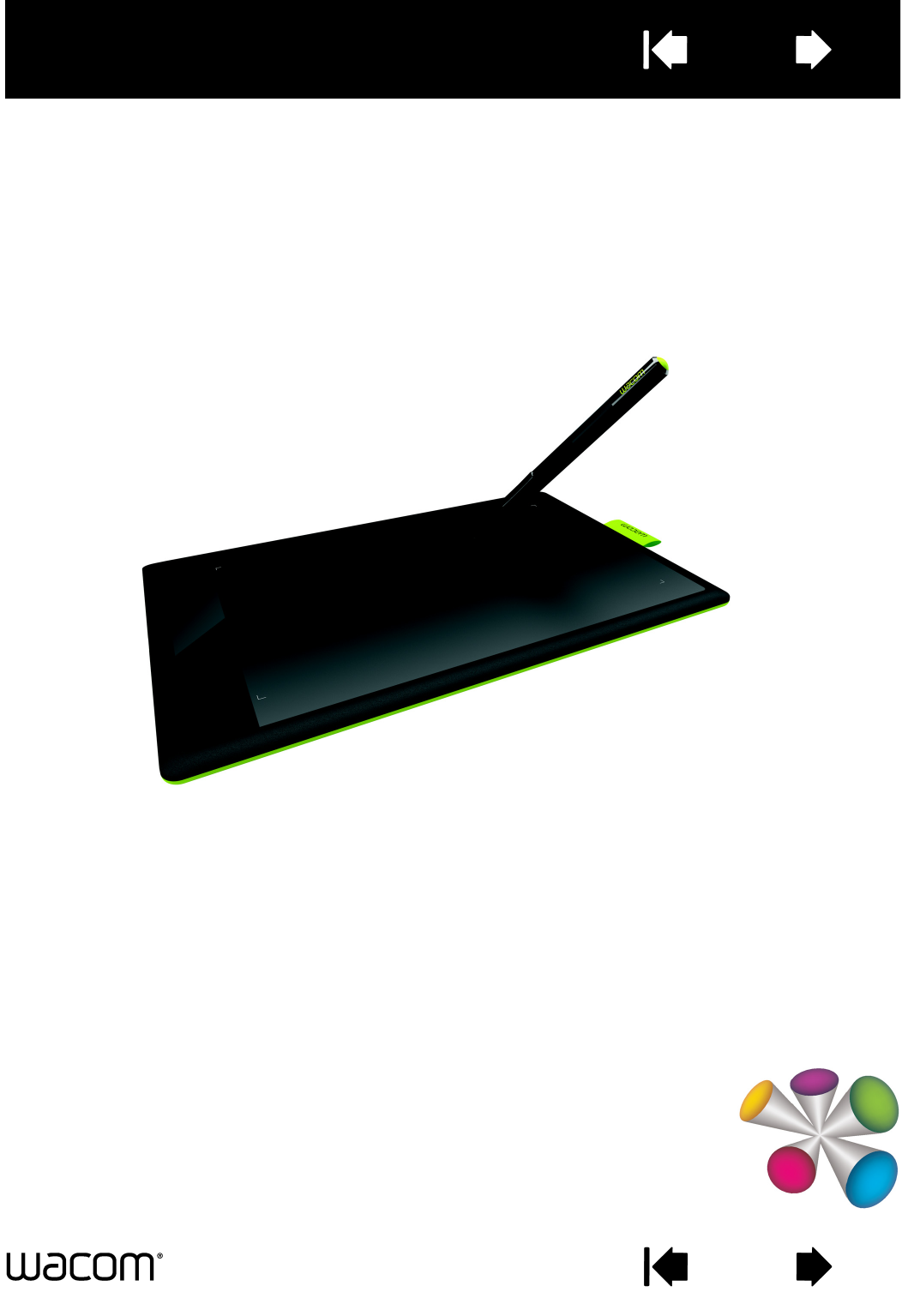Wacom Co CTL671 Pen Tablet User Manual Wacom Tablet User s Manual
Wacom Co Ltd Pen Tablet Wacom Tablet User s Manual
Wacom Co >
Contents
- 1. User manual 1 of 2
- 2. User manual 2 of 2
User manual 1 of 2

Contents Index
Contents 2
Index
2
Wacom Tablet
User’s Manual
Version 1.1, Rev C0413
Copyright © Wacom Co., Ltd., 2013
All rights reserved. No part of this manual may be reproduced except for your express personal use.
Wacom reserves the right to revise this publication without obligation to provide notification of such changes.
Wacom does its best to provide current and accurate information in this manual. However, Wacom reserves the right
to change any specifications and product configurations at its discretion, without prior notice and without obligation
to include such changes in this manual.
The above year indicates when this manual was prepared. However, the date of release to the users of the “manual” is
simultaneous with the introduction into the market of the applicable Wacom product.
Wacom is a registered trademark of Wacom Co., Ltd.
Adobe and Photoshop are either registered trademarks or trademarks of Adobe Systems Incorporated in the United
States and/or other countries. Microsoft, Windows, and Vista are either registered trademarks or trademarks of
Microsoft Corporation in the United States and/or other countries. Apple, the Apple logo, and Mac are trademarks of
Apple, Inc., registered in the U.S. and other countries.
Any additional company and product names mentioned in this documentation may be trademarked and/or registered
as trademarks. Mention of third-party products is for information purposes only and constitutes neither an
endorsement nor a recommendation. Wacom assumes no responsibility with regard to the performance or use of
these products.

Contents Index
Contents 3
Index
3
TABLE OF CONTENTS
TABLE OF CONTENTS 3
About the manual 4
YOUR WACOM TABLET 5
Wacom Pen tablet 6
Pen 7
Pen holder 7
SETTING UP YOUR WACOM TABLET 8
Ergonomics 8
Configuring tablet orientation 9
Working with multiple monitors 10
Control panel basics 10
USING YOUR WACOM TABLET 11
The pen experience with the Wacom tablet 12
Holding the pen 12
Using the pen on the tablet 13
Positioning 14
Clicking 16
Dragging 16
Using the pen buttons 17
Writing and drawing with pressure sensitivity 18
Erasing 19
Eye-hand coordination exercise 20
Customizing pen input 20
CUSTOMIZING YOUR WACOM TABLET 21
Opening the control panel 21
Control panel overview 22
Customize your pen experience 23
Setting the tip and eraser feel, and double-click
distance 24
Setting the pen button functions 25
Setting the tablet mapping 26
Portion of screen area 28
Portion of tablet area 28
Setting the pen speed in mouse mode 29
Customizing tablet Orientation 30
Working with Display Toggle 31
Button functions 32
Testing your tablet 36
Testing a pen 36
Troubleshooting tables 37
General problems 37
Pen input problems 37
Windows-specific problems 40
Mac-specific problems 40
Technical support options 42
Obtaining driver downloads 43
APPENDIX 44
Caring for Your Wacom tablet 44
Replacing the pen nib 45
Bamboo Dock 46
Uninstalling your Wacom tablet 47
Managing preferences 48
Pen and digital ink capabilities in Windows 49
Product information 50
Ordering parts and accessories 50
Available parts and accessories 50
GLOSSARY 51
Wacom international offices 53
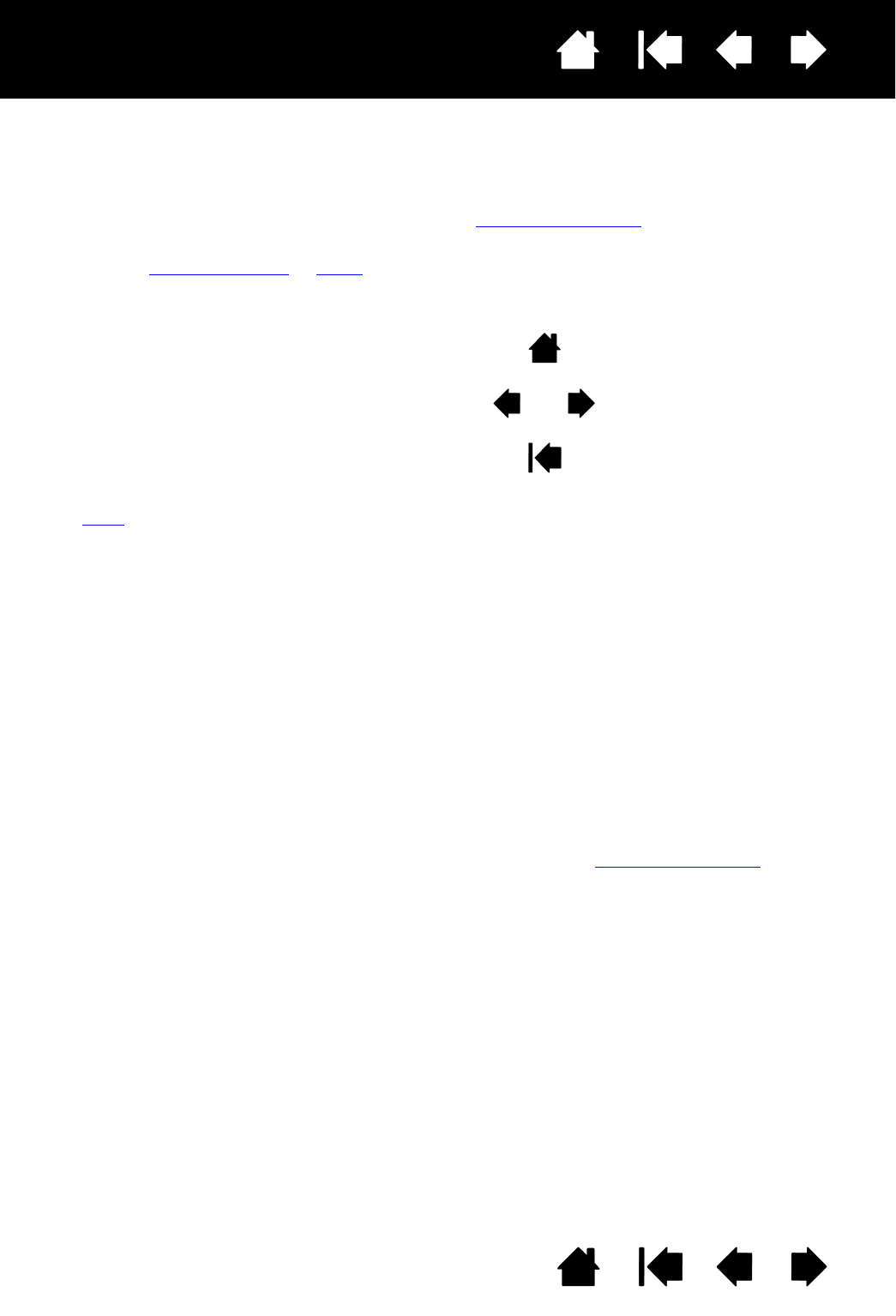
Contents Index
Contents 4
Index
4
ABOUT THE MANUAL
This manual provides quick access to information about Your Wacom tablet. The information is common
to Windows and Mac computers and Windows screen captures are shown, unless otherwise noted.
• Go directly to table of contents or index topics by clicking on them.
• Use the navigation controls to move through the manual.
• You can use your .pdf viewer zoom-in tool to increase the size of the manual on your display screen.
Most .pdf viewers include additional tools for using and printing the manual. See the viewer application
help for more information.
•S
MALL CAPITAL LETTERS are used to identify the names of keyboard keys, dialog boxes, and control panel
options.
• Be sure to see also the Important Product Information guide for the Wacom tablet, located on the
Wacom tablet Installation CD. The guide includes product safety precautions, specifications, and your
license agreement.
• The following information is not included with this product: information about your specific computer
hardware or operating system, or information about your application software. Your best source for this
information is the set of manuals and discs that came with your hardware, operating system, or
application.
• In addition to the built-in inking support found within Microsoft Windows 8, Windows 7 and Vista, many
graphics applications also support pressure sensitivity and the pen eraser. You can find a listing of
applications that support these features on Wacom’s web site (see product information).
• For information on how best to use Wacom tablet features within a specific application, see the
instructions in that application’s manuals.
Note: This manual does not describe how to install your Wacom tablet. Please refer to your product Quick
Start Guide, and use the automated software installer (located on the Wacom tablet Installation CD).
Wacom’s philosophy is to continually improve all of its products. As a result, engineering changes and
improvements are made from time to time. Therefore, some changes, modifications, and improvements
may not be covered in this manual.
Go to front page.
Go to table of contents. Page back, or page forward.
Go to index. Go back to previous view.
Go to topic.
Contents
Index
topic
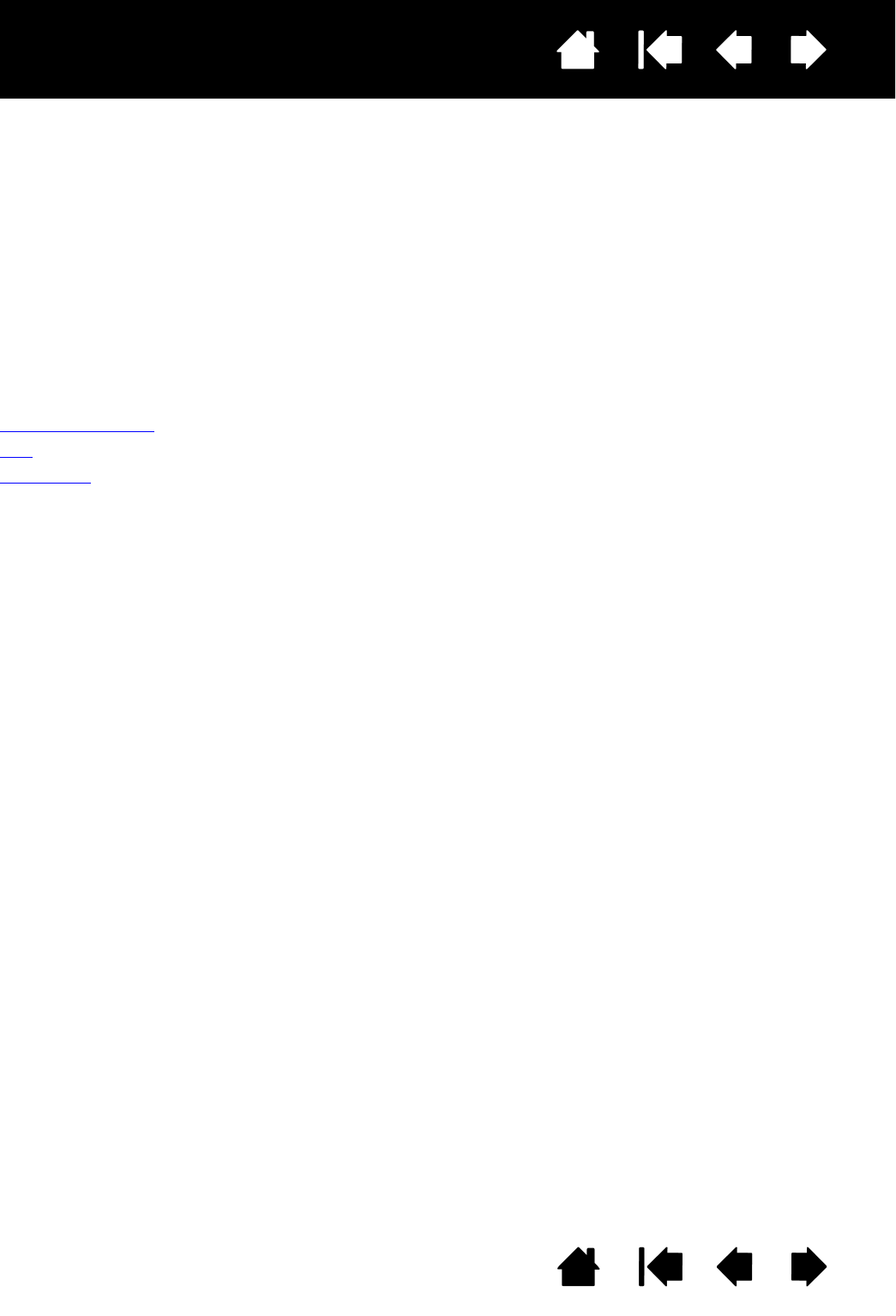
Contents Index
Contents 5
Index
5
YOUR WACOM TABLET
This section introduces you to your Wacom tablet. The quickest way to learn about your Wacom tablet is to
become familiar with its appearance and features.
• Not all product models are available in all regions.
• Your Wacom tablet can only be used with compatible Wacom pens or input devices. Wacom cannot
guarantee compatibility with older tablets or pens. You cannot use pens or input devices from a
previous version Wacom tablet. Nor can a pen from your new Wacom tablet be used with other Wacom
tablets or a previous version Wacom tablet.
Wacom Pen tablet
Pen
Pen holder
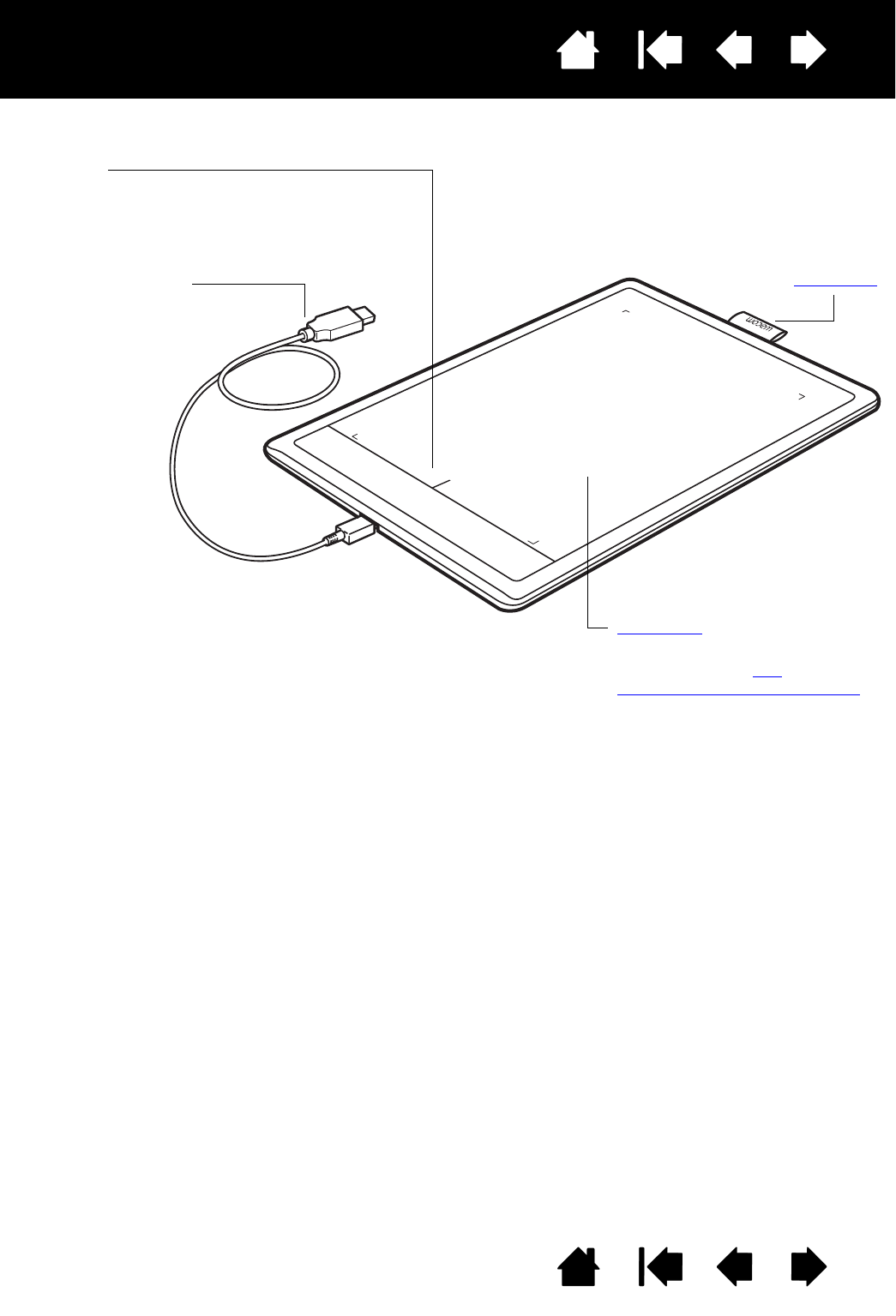
Contents Index
Contents 6
Index
6
WACOM PEN TABLET
USB cable, detachable
Disconnect the USB
cable when storing the
tablet. Do not wrap the
cable around the tablet.
Status LED
Glows blue when the Wacom tablet is connected to an
active USB port.
Brightens when using the pen.
Pen holder
Active area
This is the active area for pen input.
Learn about your pen and
Customize your pen experience.
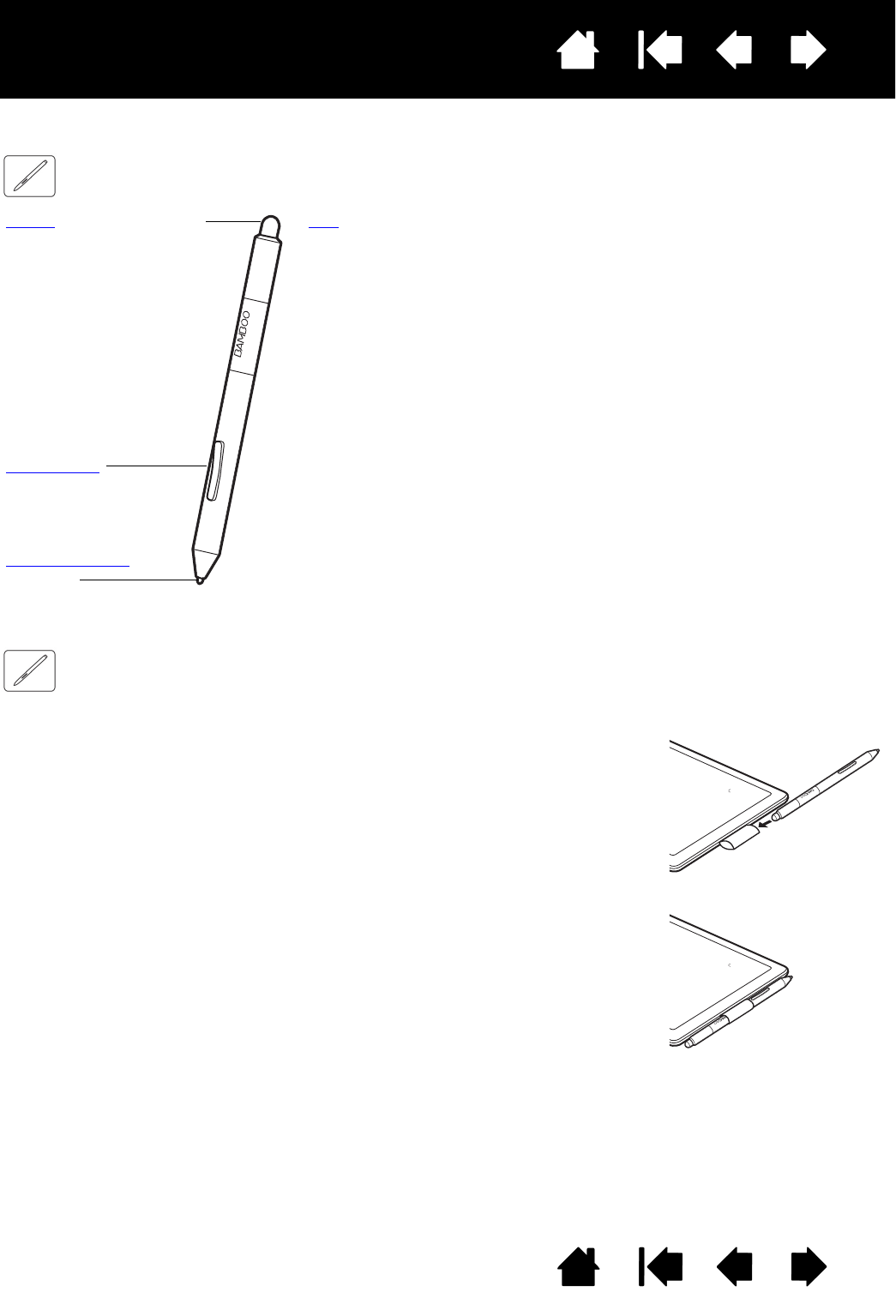
Contents Index
Contents 7
Index
7
PEN
PEN HOLDER
When not in use, store the pen in the pen holder.
Eraser (when equipped)
Pen buttons
Replaceable nib
(pen tip)
Pen
Cordless, battery-free, and pressure sensitive. Use this freehand tool for
image editing and creating natural-looking pen strokes. It is also an efficient
tool for document annotation and taking notes in applications that support
handwriting recognition.
You will find the pen ideally suited to enhance your workflow by enabling the
pen and digital ink features found within Microsoft Windows 8, Windows 7,
Vista, and Office 2007 or later. Take advantage of digital mark-up for
collaborative editing and use digital ink to take notes in applications that
support handwriting recognition.
Important: When not in use, place the pen in the pen holder or
lay it flat on your desk. When equipped, the eraser end of the
pen should be inserted first into the loop. To maintain the
sensitivity of your pen, do not store it in a container where it
will rest on the tip or eraser.
Leaving the pen on the tablet may interfere with screen cursor
positioning when using other pointing devices, or may prevent your
computer from going to sleep.
• Insert the eraser end of the pen into the loop.
• Do not wedge the pen buttons inside the loop. Doing so may cause the
buttons to be continually depressed and possibly fail.
Important: You can also lay the pen flat on your desk. Leaving the pen
on the tablet may interfere with screen cursor positioning when using
other pointing devices, or may prevent your computer from going to
sleep.
Do not store the pen in a holder or stand other than the one provided
with your Wacom tablet or purchased from Wacom. The pen may be
damaged if it falls out of an unsuitable stand. The sensitivity of your pen
may be affected if stored in a container where it rests on the tip or
eraser.
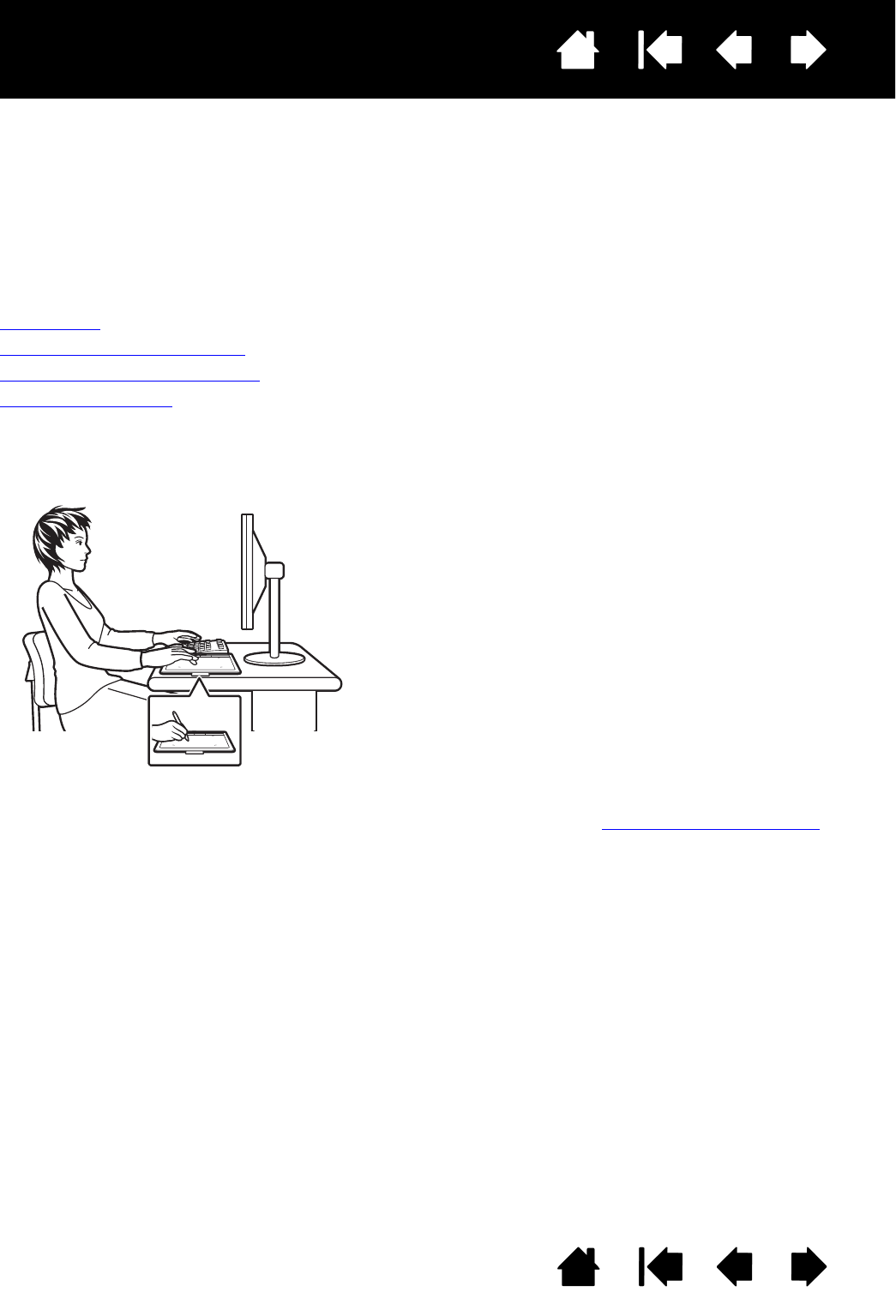
Contents Index
Contents 8
Index
8
SETTING UP YOUR WACOM TABLET
To minimize fatigue, comfortably organize your work area. Position your tablet, pen, and keyboard for easy
access without unnecessary reaching. Adjust your monitor so you can view it comfortably with minimum
eyestrain. For best results, position the tablet so the screen cursor follows the same direction as your hand
movements on the tablet.
Ergonomics
Configuring tablet orientation
Working with multiple monitors
Control panel basics
ERGONOMICS
Note regarding RSI: Wacom makes no representation, promise or guarantee that Wacom products will cure or
prevent, in whole or in part, mouse-induced repetitive stress symptoms, injuries or conditions. Individual results
may vary. Always obtain competent medical advice to determine the most appropriate treatment for your
specific situation.
• Maintain a good posture at all times.
• Use a gentle grip when working with the pen.
• Periodically shift your gaze from your computer and focus on
other objects within the room. This will help to relax your eyes.
• Take short breaks between tasks to stretch and relax your
muscles.
• Alternate tasks and tools throughout the day. Minimize awkward
postures and repetitive movements that cause discomfort.
• Change your position if you feel any discomfort due to your work
position.
• For right-handed use, position the tablet so the input (active) area
is located to the right of the ExpressKeys. If using the tablet as a
primary pointing device and mouse replacement, consider
placing it to the right of your keyboard.
• For left-handed use, position the tablet with the input area to the
left of the ExpressKeys. See configuring tablet orientation. If using
the tablet as a primary pointing device and mouse replacement,
consider placing it to the left of your keyboard.
• If using the tablet primarily as a creative tool, consider placing the
tablet below the keyboard, centered with respect to your monitor.
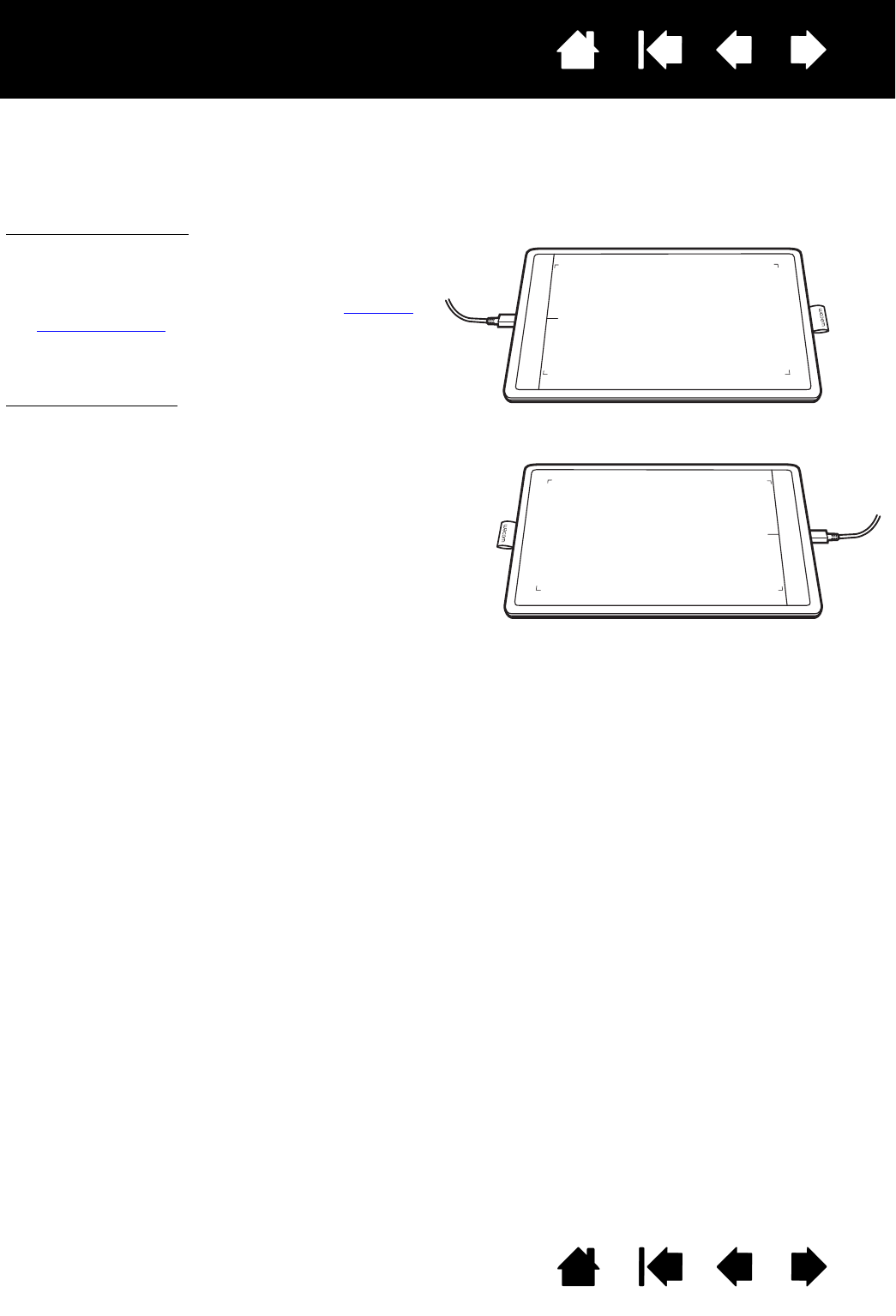
Contents Index
Contents 9
Index
9
CONFIGURING TABLET ORIENTATION
When you first installed the tablet, you were prompted to choose a default tablet orientation. The
orientation you chose was used to determine the tablet default settings. However, you can easily
reconfigure the tablet for left- or right-handed users at any time.
Note: This procedure does not affect the default orientation. At the system log on and user switching
screens, the tablet uses the default orientation you chose during the install process. To change the
default orientation, you must re-install the tablet driver.
Right-handed operation:
• Open the Wacom control panel and select the
TABLET tab. Choose RIGHT HANDED. The tablet
driver automatically configures all aspects of the
tablet for correct right-handed use. See Opening
the control panel
• Next, physically rotate your tablet.
Left-handed operation:
• Open the Wacom control panel and select the
TABLET tab. Choose LEFT HANDED. The tablet
driver automatically configures all aspects of the
tablet for correct left-handed use.
• Next, physically rotate your tablet.
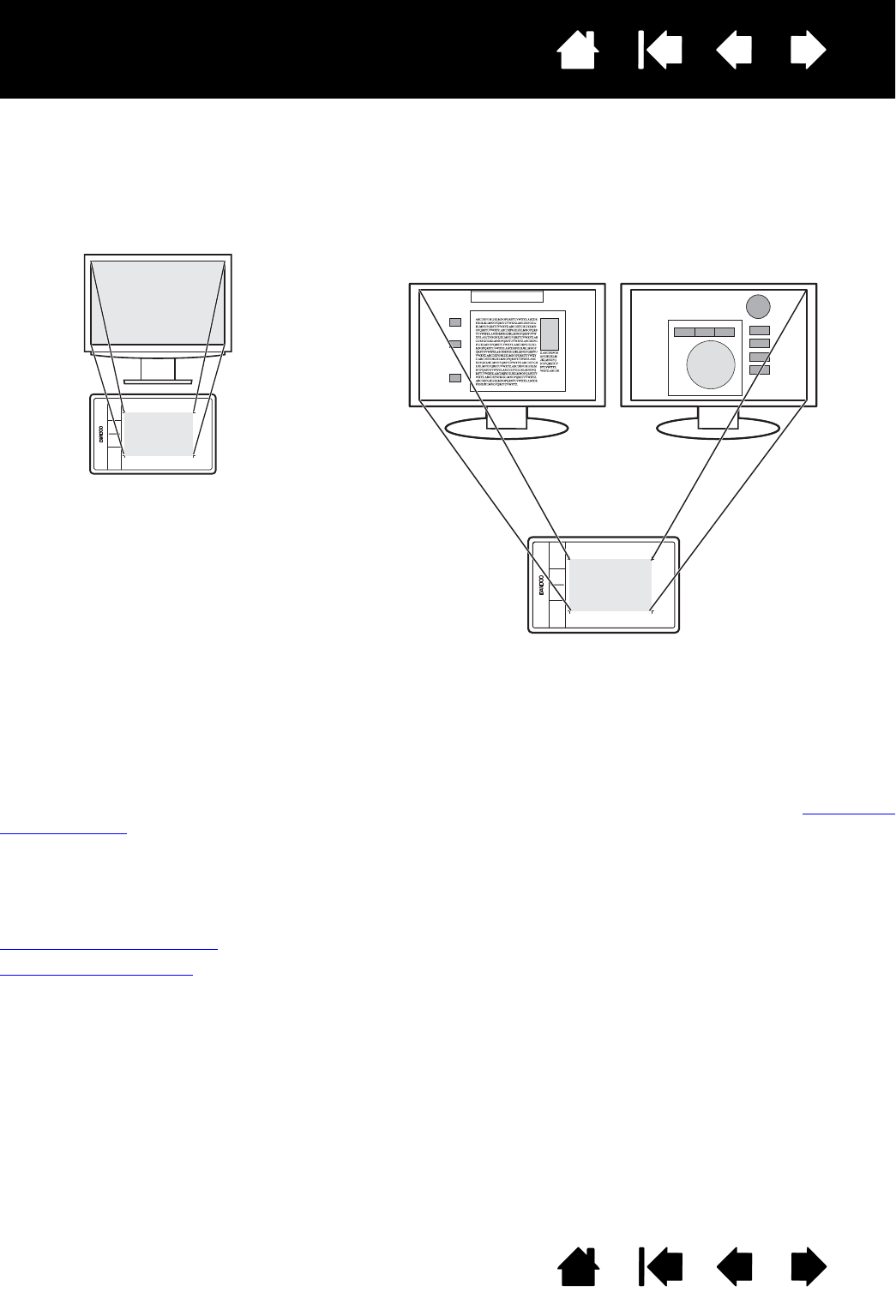
Contents Index
Contents 10
Index
10
WORKING WITH MULTIPLE MONITORS
If your computer is equipped with more than one monitor, the tablet will map to your monitors based upon
how they are configured in the display properties control panel.
• If more than one monitor is in use and you are in extended monitor mode, the tablet maps to all
monitors as if they were one large display.
• If your monitors are in mirror mode (both monitors display the same content), the tablet maps to the
entire space on each monitor and the screen cursor is displayed on each monitor simultaneously.
See your hardware and operating system documentation for details on configuring your computer and
operating system for use with multiple monitors.
You can customize the tablet to map to a single monitor, or to a portion of the monitor area. See setting the
tablet mapping.
CONTROL PANEL BASICS
After mastering the basics of using your tablet, you may want to customize the way your pen input works.
The Wacom tablet control panel is where you customize your tablet settings.
Opening the control panel
Control panel overview
Monitor 1 Monitor 2
Example of tablet mapping to the entire system desktop,
which is displayed on two monitors.
Example of tablet
mapping to a single
monitor.
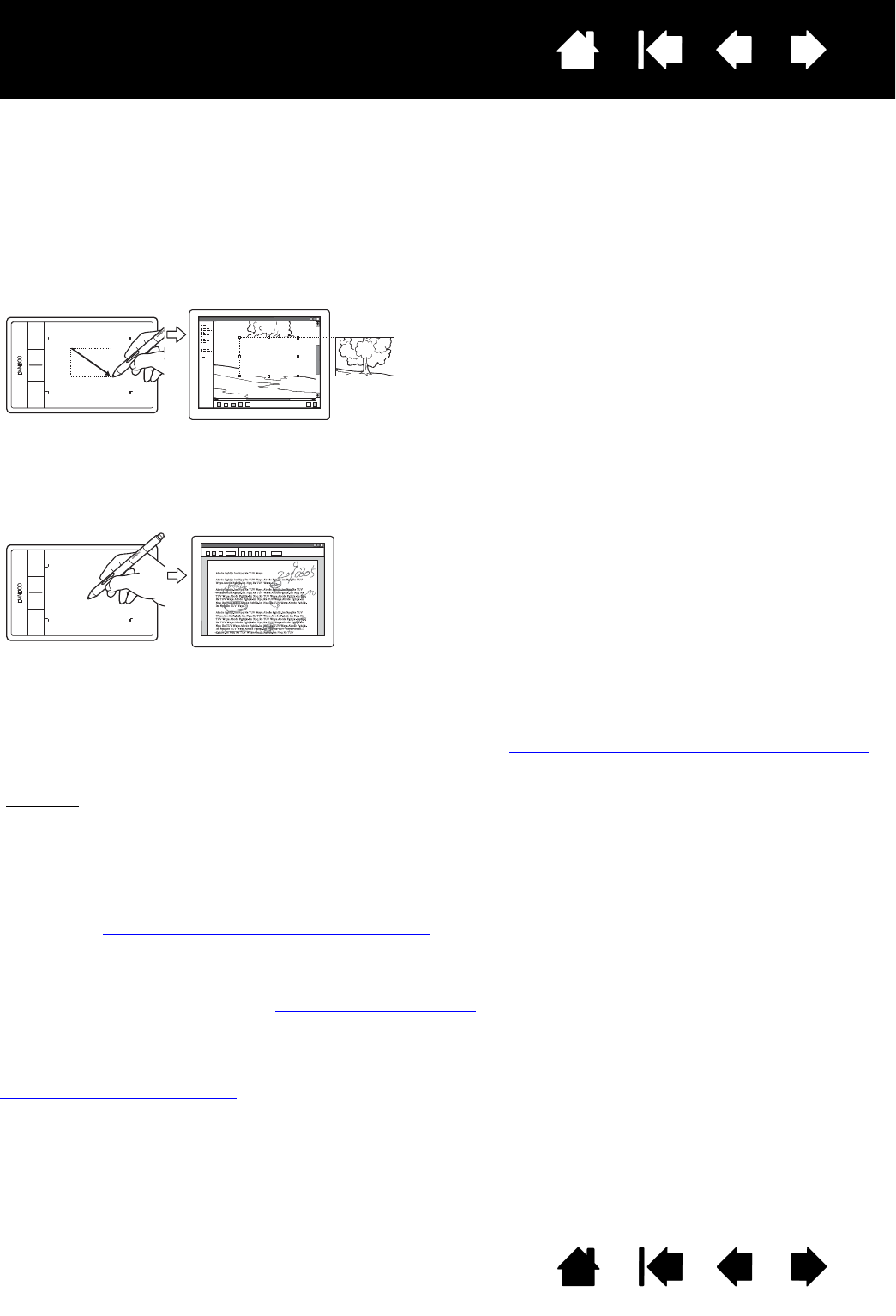
Contents Index
Contents 11
Index
11
USING YOUR WACOM TABLET
If you are new to using the Wacom tablet, read the following sections.
As you work, you will discover many ways of interacting with your tablet. For example:
For details on these and other ways to work with your tablet,The pen experience with the Wacom tablet
.
Working with Display Toggle
Annotation
Simplify document reviews by using the pen to
digitally mark-up and annotate documents.
Photo editing
Use the pressure-sensitive pen to edit images
within a photo or image editing application.
Pen input
The pen works only on the active area of the tablet.
Wherever you place the pen on the tablet, the screen pointer will jump
to the corresponding point on the screen. The screen pointer indicates
pen position, and follows the movement of the pen across the tablet
surface.
Learn about The pen experience with the Wacom tablet.
Note: The active area is a mapped representation of your computer
screen(s). By default it uses the entire screen or all screens if you
have multiple displays. You can customize the mapping
relationship for pen input by setting the tablet mapping.
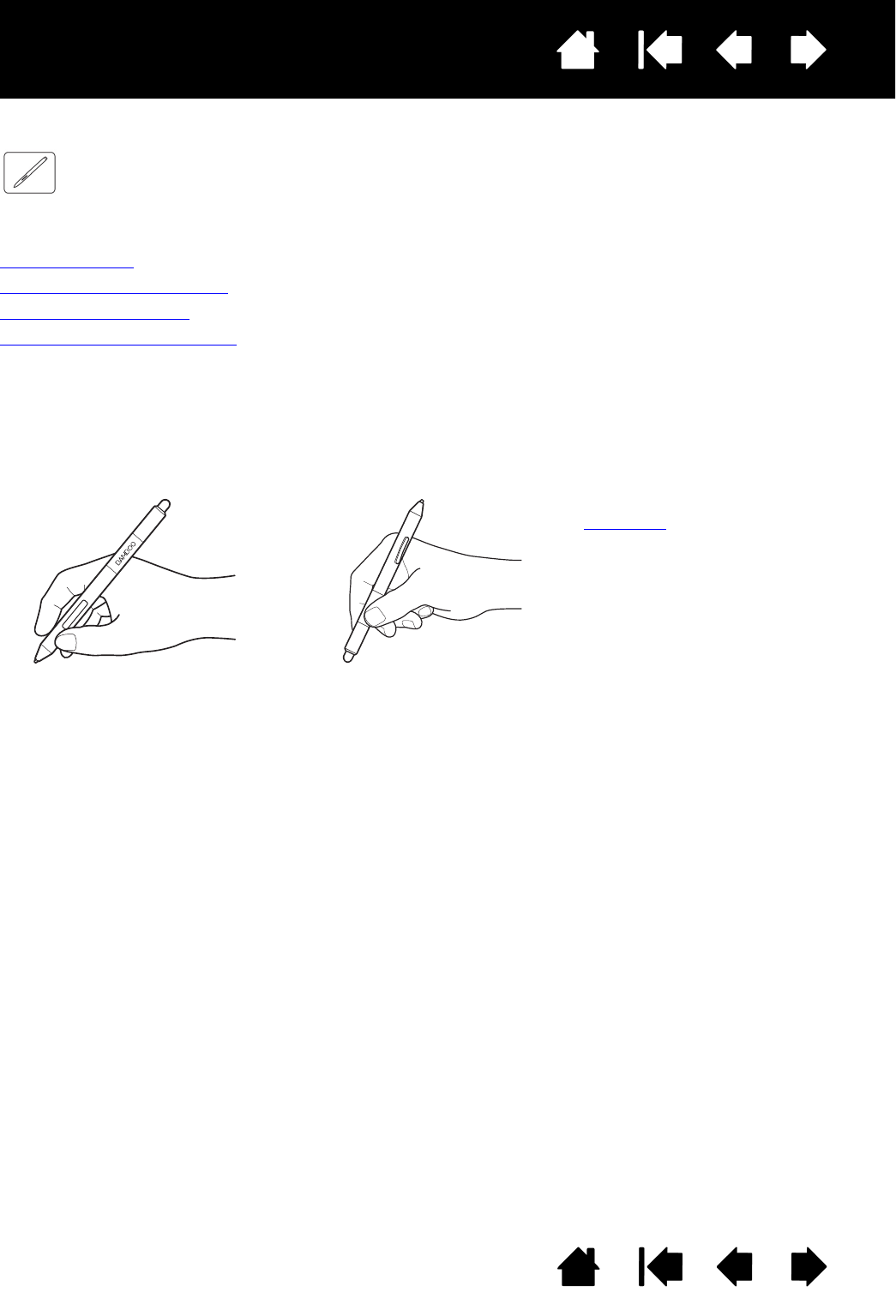
Contents Index
Contents 12
Index
12
THE PEN EXPERIENCE WITH THE WACOM TABLET
Your Wacom tablet is designed to enhance the way you work. Wacom tablet models equipped for pen
input enable you to interact with a computer using the pen on the active area of the tablet.
Holding the pen
Using the pen on the tablet
Customizing pen input
Working with Display Toggle
HOLDING THE PEN
Hold the pen like you would hold a normal pen or pencil. Make sure the pen buttons are in a convenient
location where you can toggle them with your thumb or forefinger, but not accidently press them while
drawing or positioning with the pen. Tilt the pen in any way that feels most comfortable.
Important: When not in use, place the pen in the pen holder or lay it flat on your desk. To maintain
the sensitivity of your pen, do not store it in a container where it will rest on the tip or eraser. Leaving
the pen on the tablet may interfere with screen cursor positioning when using other pointing
devices, or may prevent your computer from going to sleep.
Position for drawing and navigation Position for erasing
When you are not using the pen, store it in
the pen holder. When equipped, the eraser
end of the pen should be inserted first into
the loop.
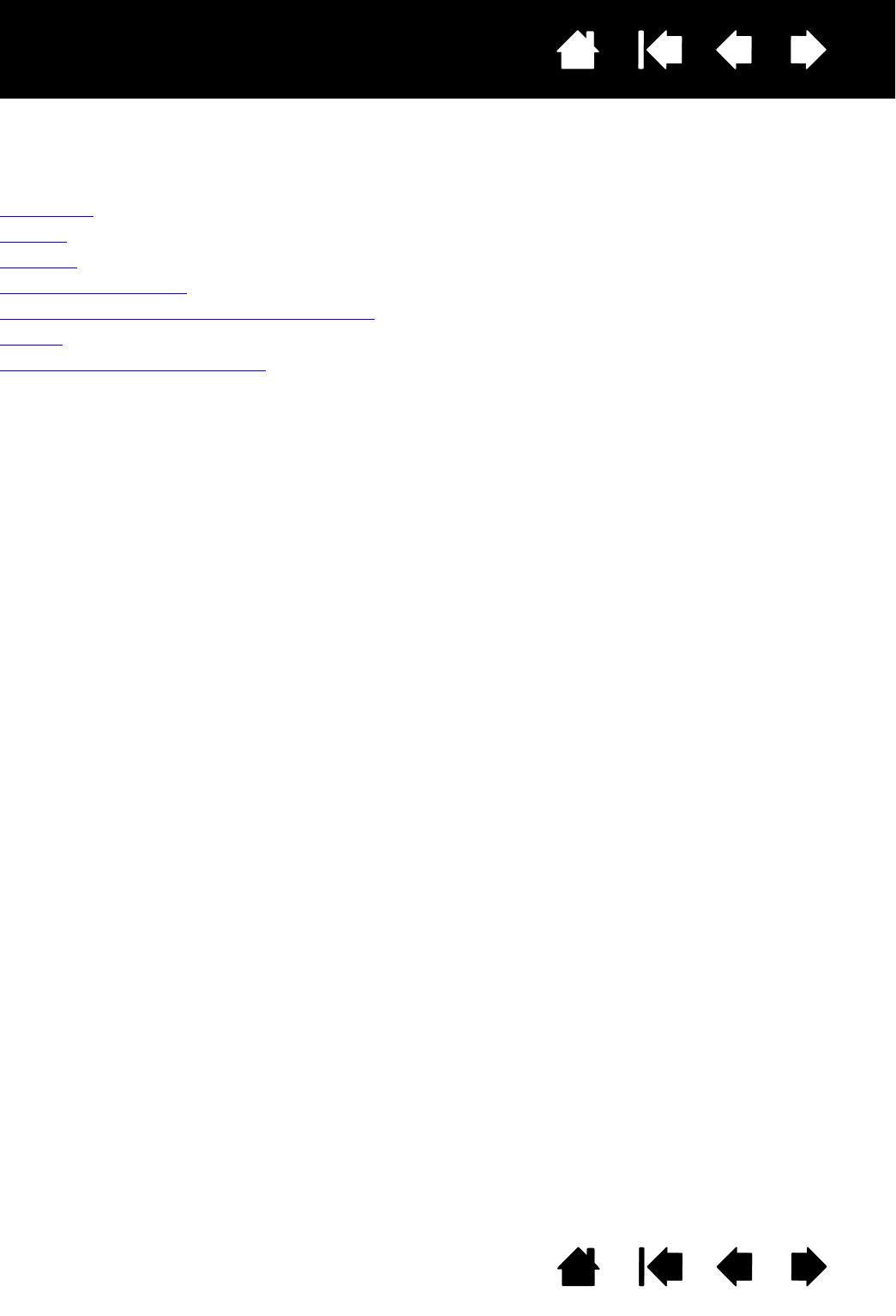
Contents Index
Contents 13
Index
13
USING THE PEN ON THE TABLET
There are four basic techniques for using the pen: positioning, clicking, double-clicking, and dragging. If
you are unfamiliar with using the pen, try the exercises on the following pages.
Positioning
Clicking
Dragging
Using the pen buttons
Writing and drawing with pressure sensitivity
Erasing
Eye-hand coordination exercise
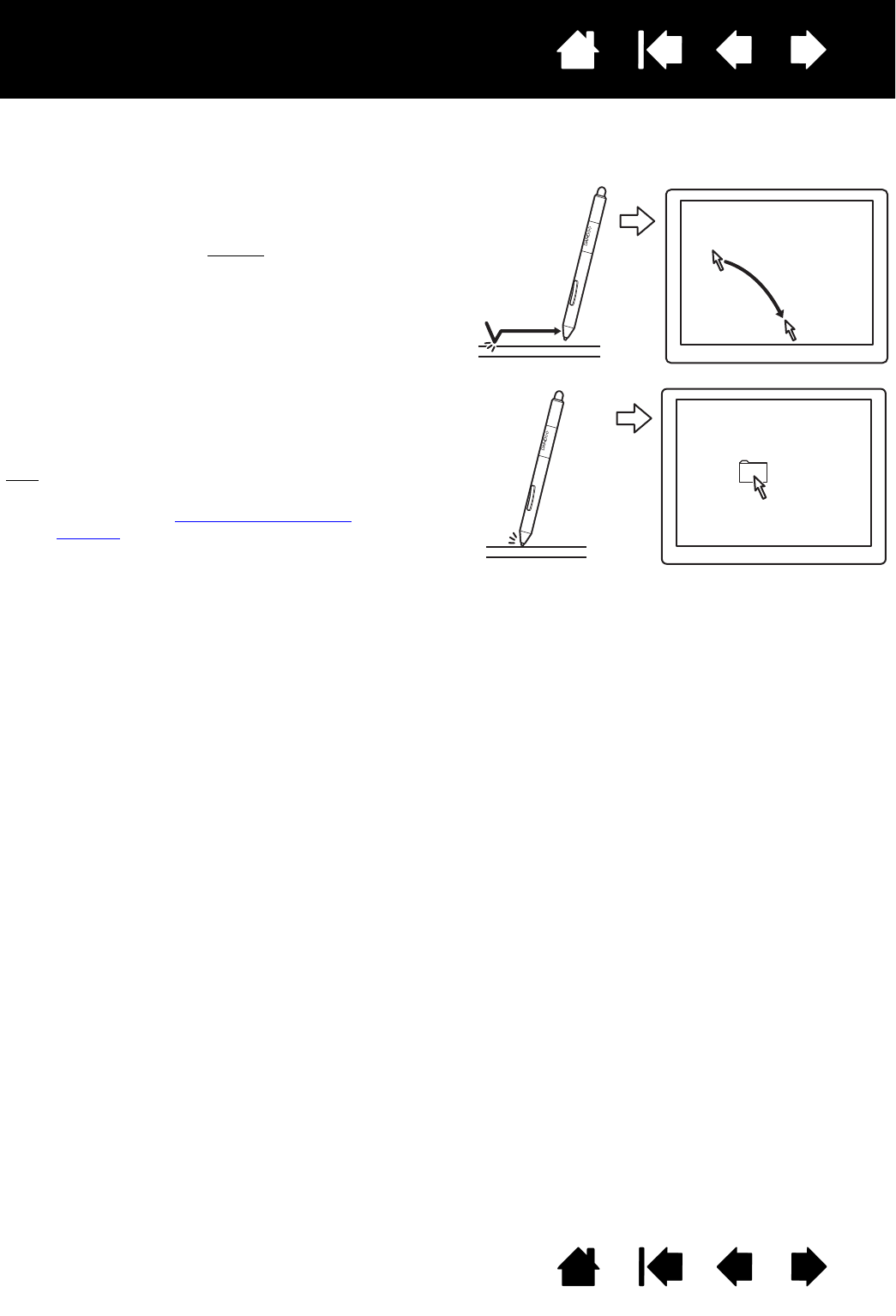
Contents Index
Contents 14
Index
14
POSITIONING
Use the pen to position the pointer (or cursor) on your screen.
Lift the pen and place the pen tip on the tablet
active area. The cursor jumps to the new location.
Move the screen cursor by hovering the pen over
the tablet surface. Do this without touching the
tablet surface, but while still keeping the pen tip
within proximity of the tablet.
To select an icon or folder, use your pen to position
the screen cursor over the object. Press down to
select.
Tips:
If you find using a pen to be somewhat
difficult, try the eye-hand coordination
exercise.
Pointing is easier when you orient the tablet
square to the computer monitor so the
screen cursor follows the same direction as
your hand movements on the tablet.
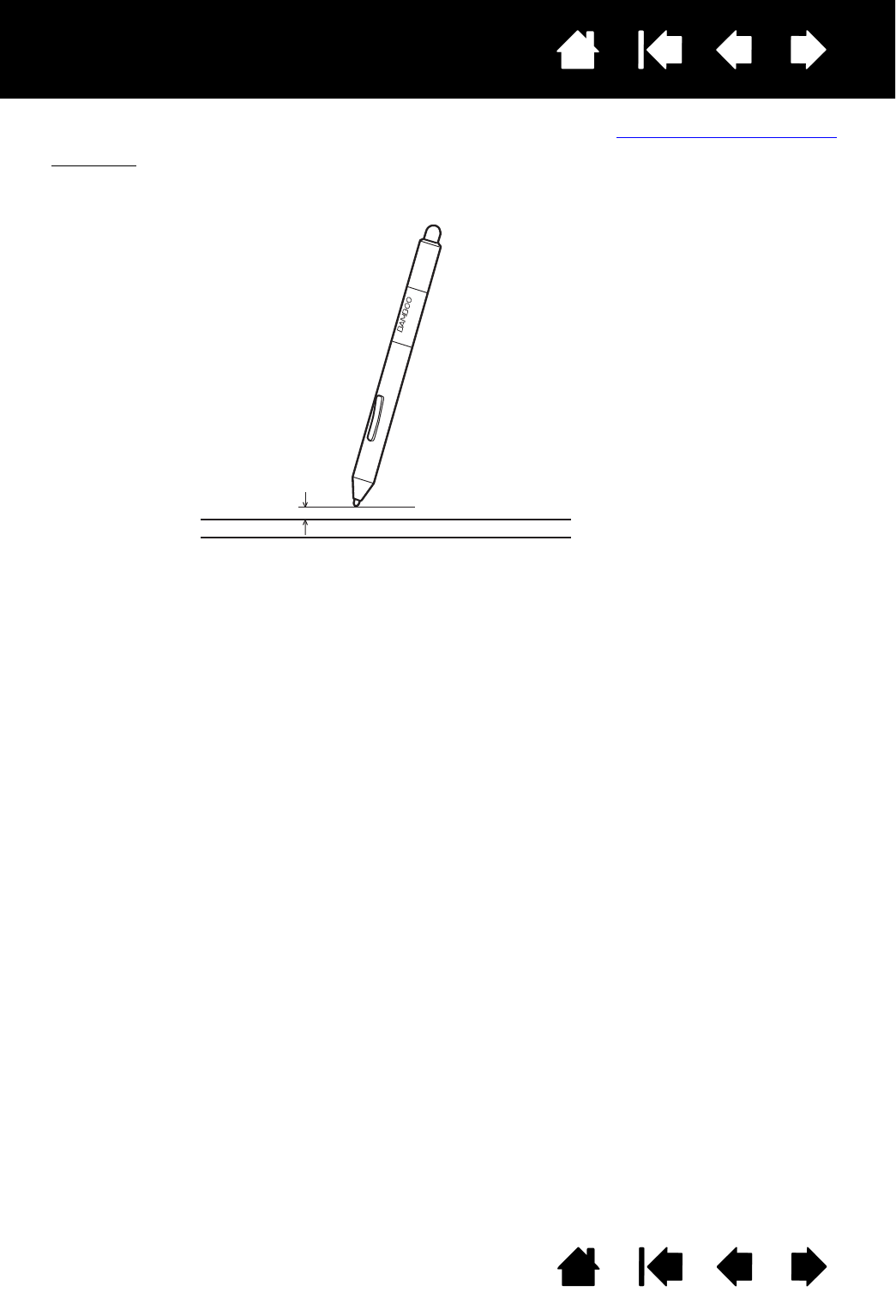
Contents Index
Contents 15
Index
15
You can set the pen to position the screen cursor two different ways (see setting the tablet mapping).
• In pen mode, wherever you place the pen on the tablet, the screen cursor will jump to a corresponding
point on the display screen. The screen pointer indicates pen position, and follows the movement of the
pen across the tablet surface. This is the default setting for the pen.
• In mouse mode you move the cursor with a “pick up and slide” motion similar to using a mouse.
7 mm (0.28 inch) proximity
16 mm (0.63 inch) proximity range
When positioning the screen cursor and operating a pen
button, the pen tip needs to be within 7 mm (0.28 inch)
of the tablet surface. The pen tip does not need to touch
the tablet in order to move the screen cursor or use a
pen button.
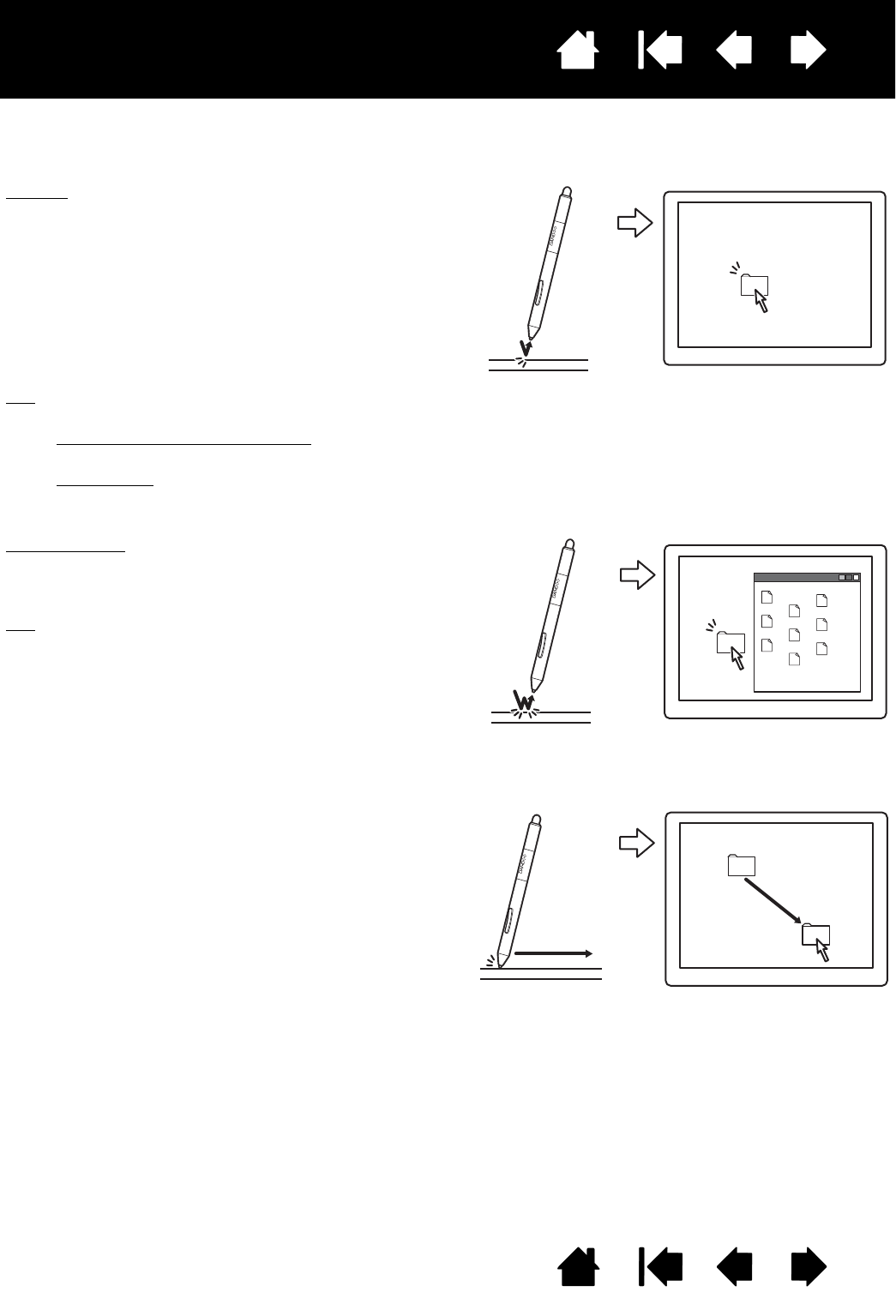
Contents Index
Contents 16
Index
16
CLICKING
Click to highlight or select an item on the screen. Double-click to open it.
DRAGGING
Dragging is used to select and move objects on the monitor screen.
Tip: Configure Windows to select when hovering the pen over an icon and to launch the icon with a single click.
To turn on this feature, first open a folder.
Windows 8, Windows 7 and Vista: From the ORGANIZE pull-down menu choose FOLDER AND SEARCH
OPTIONS.... From the GENERAL tab select SINGLE-CLICK TO OPEN AN ITEM (POINT TO SELECT).
Windows XP: From the TOOLS pull-down menu choose FOLDER OPTIONS.... From the GENERAL tab select
SINGLE-CLICK TO OPEN AN ITEM (POINT TO SELECT).
Clicking. Tap the pen tip once on the tablet, or press the pen
tip on the tablet with enough force to register a click. Try
clicking on a folder icon by moving the screen cursor over
the icon and pressing down on the pen tip. The folder
should highlight when you press.
If CLICK SOUND is selected in the Wacom control panel and
your computer speakers are on, then you will hear a “click”
sound when the pen tip is pressed hard enough to generate
a button click. Adjust your speaker volume as necessary.
Double-clicking. Quickly tap the tablet twice in the
same place with the pen tip. This is like clicking
twice with a mouse button. Try double-clicking on a
folder icon to open it.
Tip: Set a pen button to DOUBLE CLICK. This is
easier than tapping twice with the pen tip,
and is the preferred method of double-
clicking with a pen.
First point to an object. Then press the pen tip to
the tablet and slide it across the tablet surface. The
selected object will move across the display
screen.
To select text within a document, move the screen
cursor to the beginning of a text line. Then drag the
pen across the tablet to highlight the text.
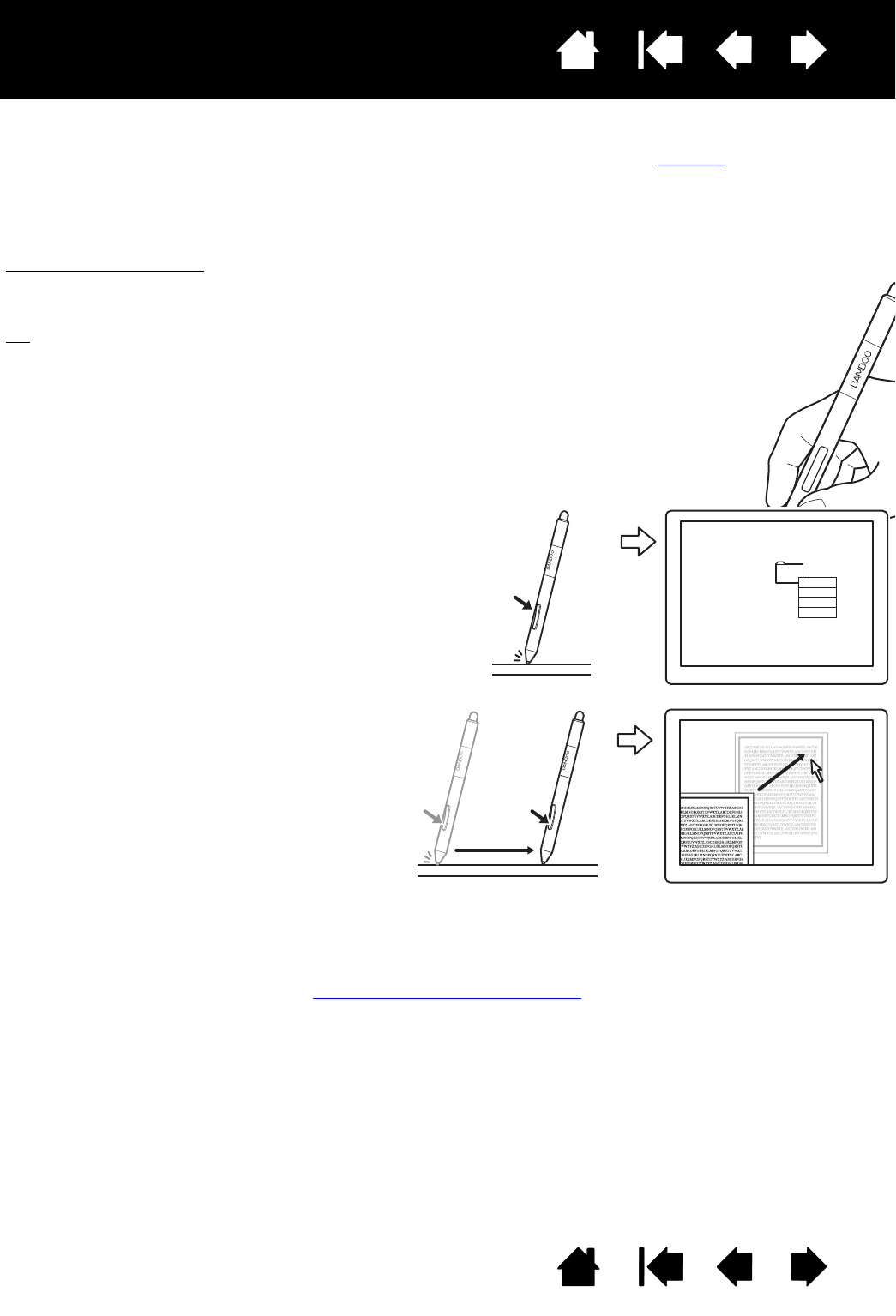
Contents Index
Contents 17
Index
17
USING THE PEN BUTTONS
The pen comes equipped with two buttons. Each button has a programmable function that is selected
when you press the button. You can use a pen button whenever the pen tip is within 7 mm (0.28 inch) of the
tablet active area. You do not have to touch the pen tip to the tablet in order to use a button.
To assign new button functions, see setting the pen button functions.
The default button positions are:
Tip: Set a pen button to DOUBLE CLICK. This is easier than tapping
twice with the pen tip.
Upper: RIGHT CLICK
Lower: PAN/SCROLL
PAN/SCROLL lets you position a document or
image in any direction within the active
window simply by pressing the pen button and
moving the pen tip across the tablet. As you
move the pen tip, the document or image is
repositioned to follow the direction of pen
movement on the tablet. Release the pen
button or lift the pen tip from the tablet surface
when done.
In some application windows the document
will precisely follow the screen cursor as you
move the pen tip. In others it will simply move
in the same general direction as the screen
cursor.
Use RIGHT CLICK to bring up application-specific
or icon-specific menus.
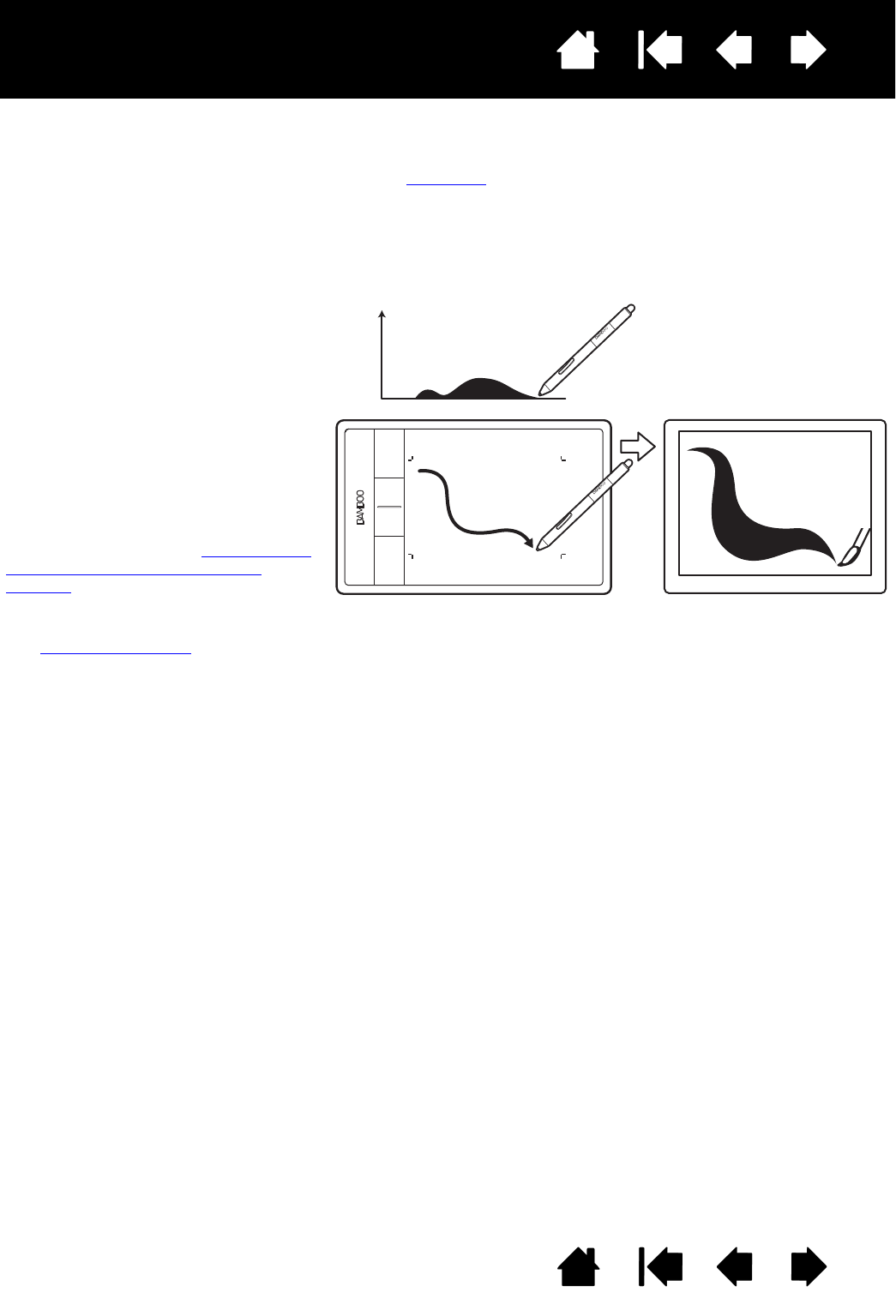
Contents Index
Contents 18
Index
18
WRITING AND DRAWING WITH PRESSURE SENSITIVITY
The pen responds to your hand movements, enabling you to create natural-looking pen and brush strokes
within applications that support this feature. The digital ink tools in Microsoft Windows 8, Windows 7, Vista,
and Office 2007 or later, as well as the drawing tools in many graphics applications, respond to the
pressure you place on the pen. For example, sliders are used in some applications to vary line
characteristics such as width, color, and opacity. These characteristics can be controlled much better by
the pen’s pressure sensitivity. You can vary line width, blend colors, and change opacity with the pressure
you exert upon the pen.
To write, ink, or draw with pressure
sensitivity, move the pen along the
surface of the tablet while applying
various amounts of pressure downward
on the tip of the pen.
• Press hard for thick lines or dense
color.
• Press gently for thin lines or softer
color.
Note that some applications require you
first select a pressure-sensitive tool from
the application tool palette.
To adjust the tip feel, see setting the tip
and eraser feel, and double-click
distance.
Visit the Wacom web site to learn about
applications that support pressure.
See product information.
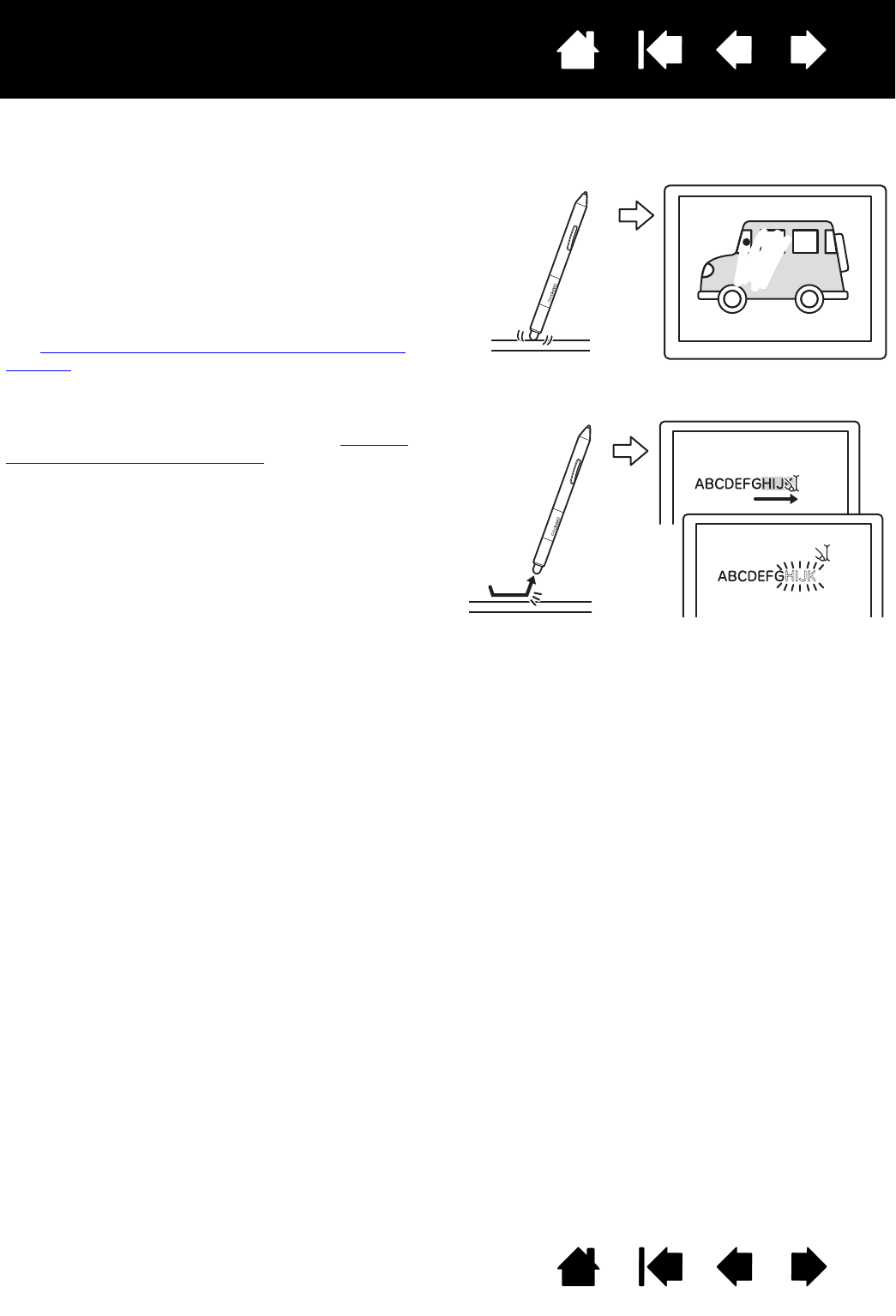
Contents Index
Contents 19
Index
19
ERASING
The pen eraser (when equipped) works like the eraser on a pencil.
Visit the Wacom web site to learn about applications that support the eraser. If the eraser is not supported
in an application, you can still use the eraser for positioning, drawing, or annotation.
Use the pen eraser in Windows 8, Windows 7, and
Vista to erase notes or sketches made with Pen and
digital ink capabilities in Windows, and to select and
delete text or spreadsheet cells within an application.
In supporting text applications use the eraser to
select text, then lift the eraser from the tablet to delete
the text.
You can erase intuitively and naturally in graphics
applications that support the pen eraser. When you use
the pen eraser, the application will automatically switch to
the eraser tool.
In applications that support pressure sensitivity, you can
select pressure-sensitive tools in the application tool
palette to vary the width and depth of your erasures as
you change the amount of pressure exerted upon the pen.
See setting the tip and eraser feel, and double-click
distance.
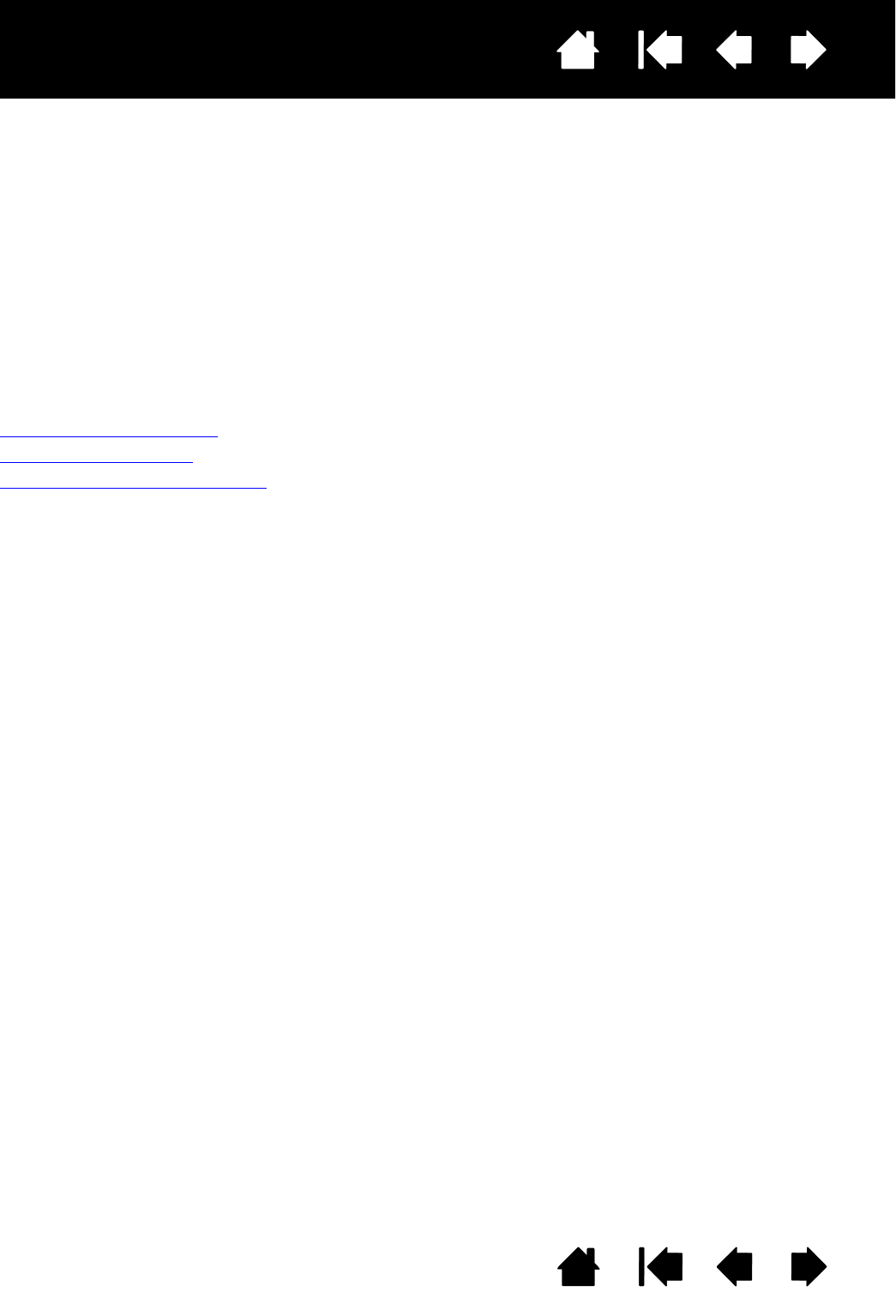
Contents Index
Contents 20
Index
20
EYE-HAND COORDINATION EXERCISE
This exercise is designed to retrain your eye-hand coordination for using the pen:
1. Open any graphics application. Use the line tool to draw a rectangular grid with line spacings of about
20-25 mm (3/4 to 1 inch). You can use a standard mouse to do this.
2. Choose a free-hand tool in your application and use the pen to draw a dot at each grid intersection.
3. Draw an X at each grid intersection.
4. Clear your screen and make a simple drawing of your own. The more you use your pen, the easier
writing, drawing, and navigation will become.
CUSTOMIZING PEN INPUT
You can easily customize the pen. Use the pen to open the Wacom tablet control panel. Then select the
PEN tab to choose from the available options.
Opening the control panel
Control panel overview
Customize your pen experience
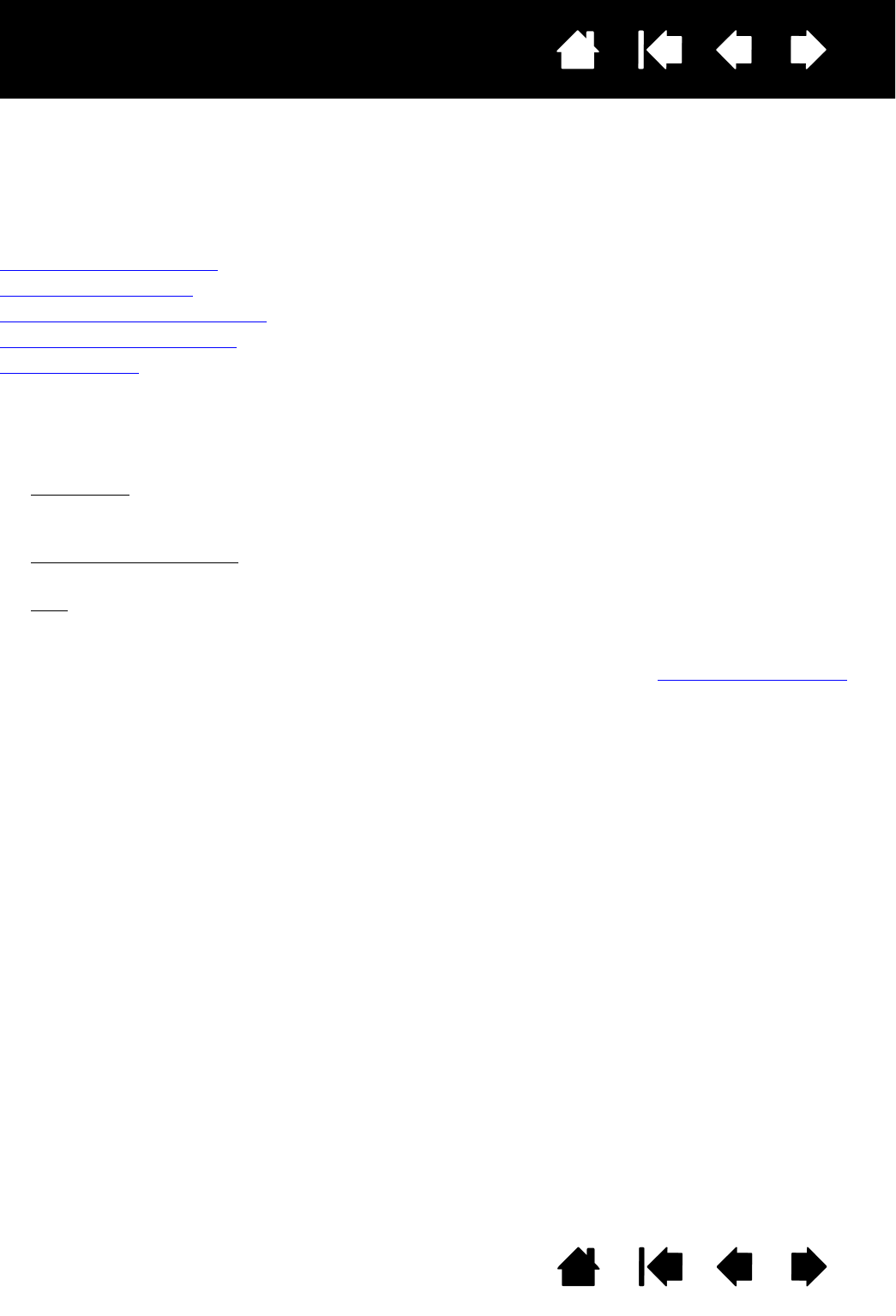
Contents Index
Contents 21
Index
21
CUSTOMIZING YOUR WACOM TABLET
Use the Wacom tablet control panel to customize your tablet for the way you like work.
Opening the control panel
Control panel overview
Customize your pen experience
Working with Display Toggle
Button functions
OPENING THE CONTROL PANEL
To open the control panel:
•Windows 8:
From the Windows 8 Start screen, click the WACOM PREFERENCES tile. If you are using the
Windows 8 Classic Desktop, press the Windows key on your keyboard, or select the Windows icon in
the Charms bar, to access the Start screen.
• Windows 7, Vista and XP
. Click on the Windows START button and choose ALL PROGRAMS. Then select
WACOM and the WACOM PREFERENCES option.
•Mac
. Open SYSTEM PREFERENCES from the Bamboo Dock, the Apple menu, or from the APPLICATIONS
folder. Then click on the WACOM TABLET icon.
You can begin customizing Wacom tablet after opening the control panel. The control panel displays only
those tabs and options that apply to your tablet model and configuration. See control panel overview.
Note: User-specific preferences are supported. After logging on, each user can customize their personal
settings in the Wacom tablet control panel. Switching to another user will automatically load the
settings for that user.
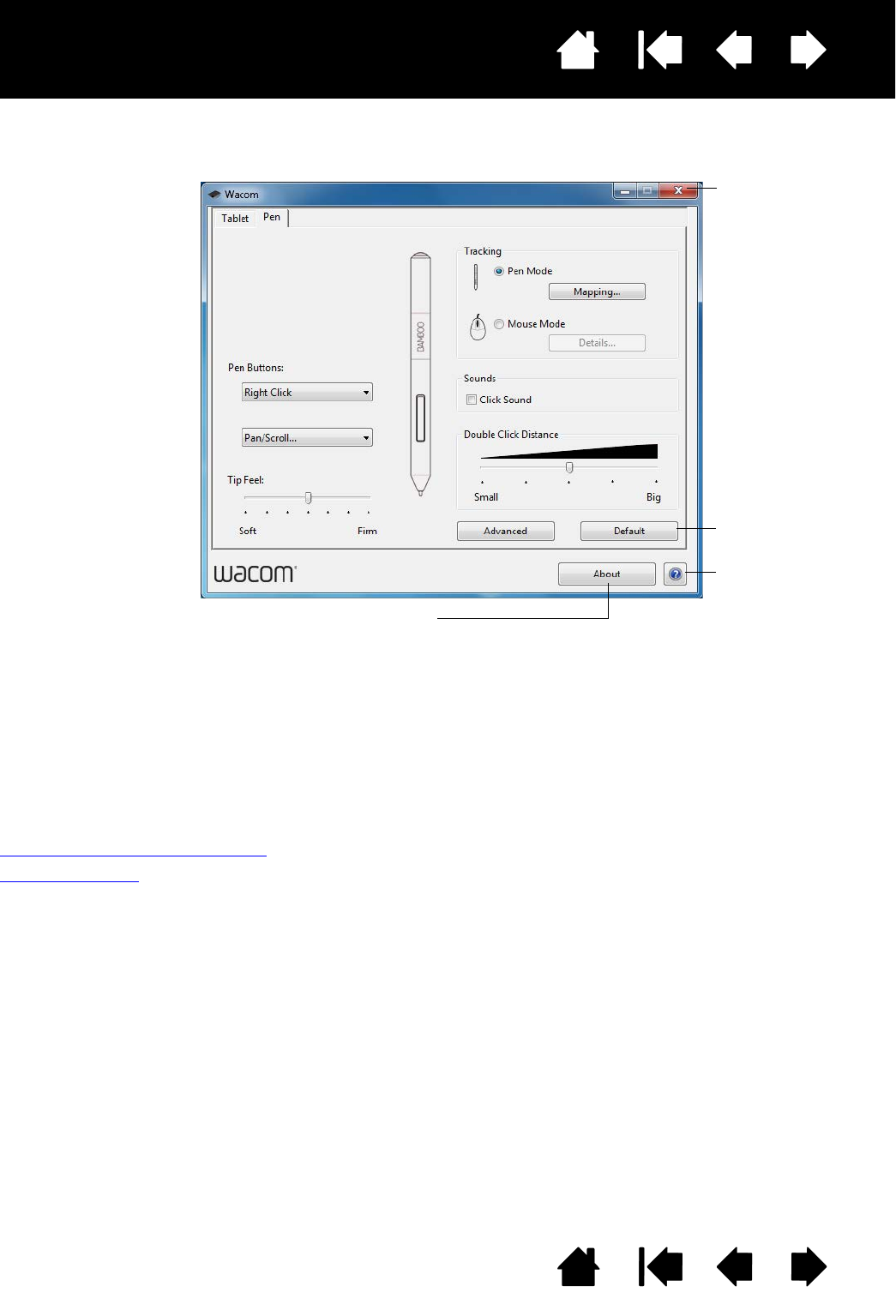
Contents Index
Contents 22
Index
22
CONTROL PANEL OVERVIEW
After opening the control panel, you can begin customizing Wacom tablet.
Experiment with different settings to find what works best for you. Any changes you make will take effect
immediately. Click DEFAULT to return a tab to the factory settings.
Tool Tips are available for most control panel items. Position the screen cursor over an item and let it rest
there. The appropriate Tool Tip will pop up in a few moments.
Your keyboard tab and arrow keys can also be used to navigate the control panel.
The following sections provide detailed information about each control panel tab and some of the more
advanced concepts. Many of the sections also contain useful customizing tips.
Customize your pen experience
Button functions
Customizable settings
are found on each tab.
The tabs that apply to
your tablet model and
configuration are
displayed when you
open the control panel.
Displays information about the control panel and driver.
Downloads or
displays the manual.
Resets the selected
tab to its default
settings.
Closes the control
panel.
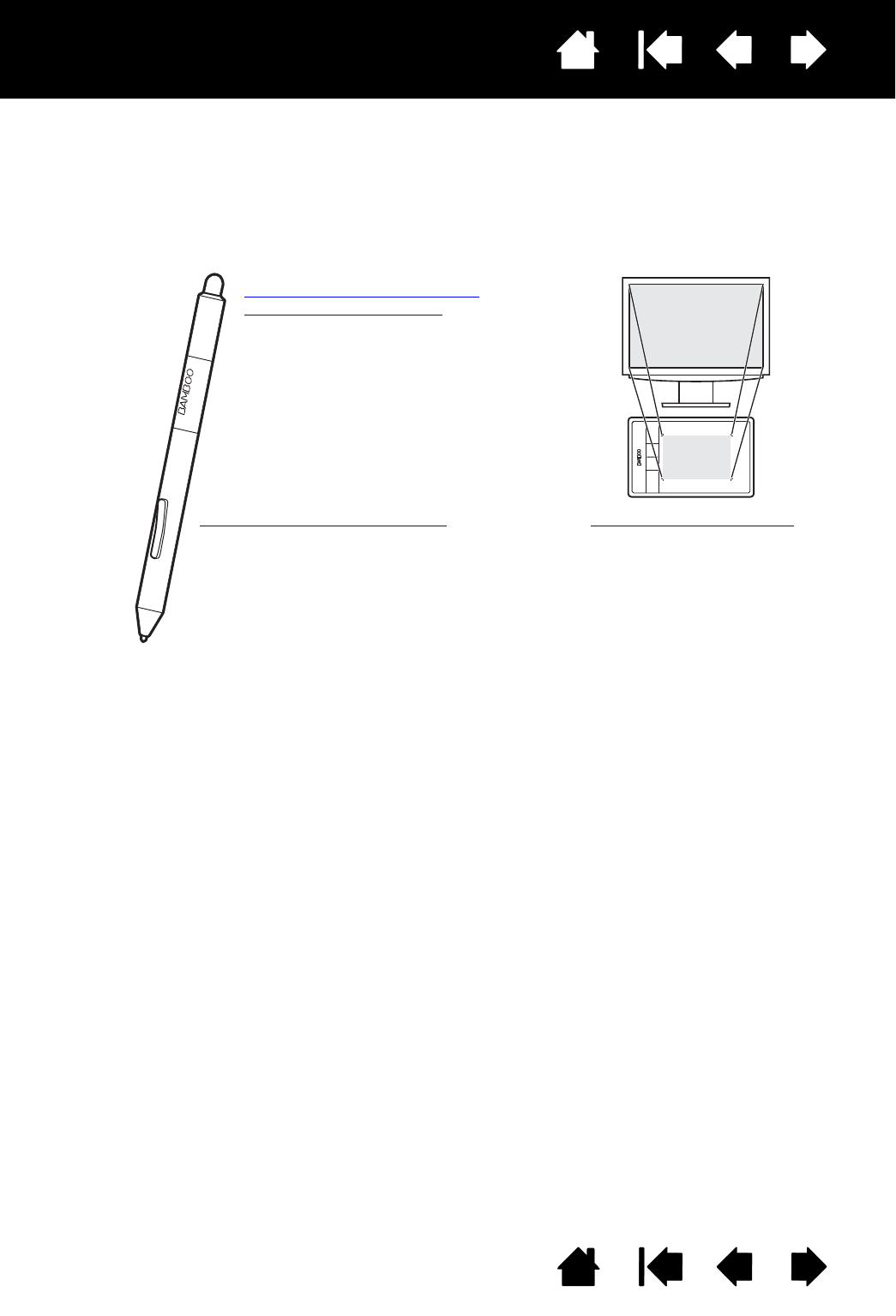
Contents Index
Contents 23
Index
23
CUSTOMIZE YOUR PEN EXPERIENCE
You can easily customize the pen. Use the pen to open the Wacom tablet control panel. You can then
customize your Wacom tablet for the way you like to interact with your tablet and computer when using the
pen or eraser (when equipped).
Note: If you have more than one Wacom pen (for example, a standard pen and a premium pen), any
changes you make to the pen settings will apply to both pens.
Setting the pen button functions
Setting the tip and eraser feel,
and double-click distance
Setting the tablet mapping
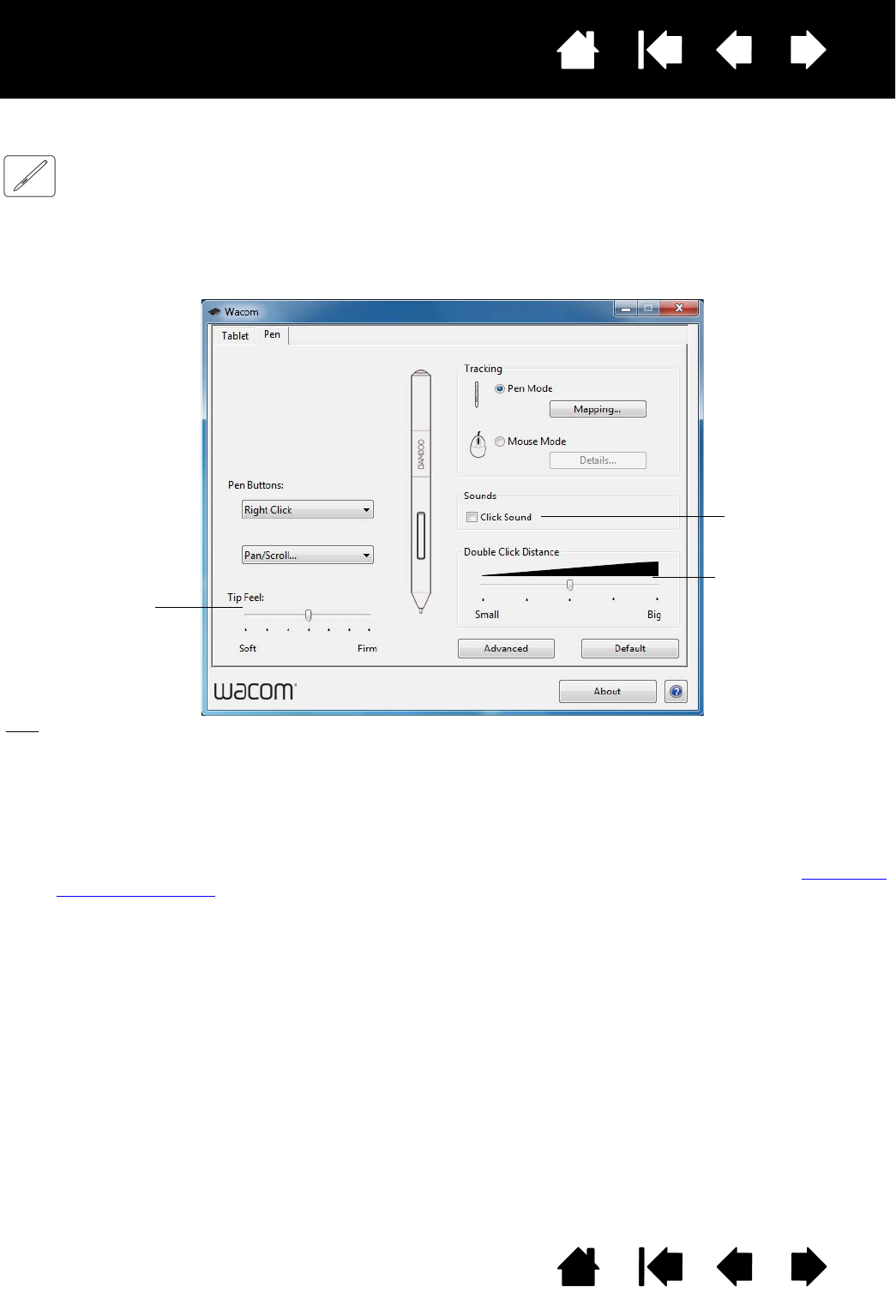
Contents Index
Contents 24
Index
24
SETTING THE TIP AND ERASER FEEL, AND DOUBLE-CLICK DISTANCE
Select the PEN tab. To create broad brush strokes or to click with a light touch, use a soft tip setting. For
maximum control while drawing thin lines, use a firm tip setting. To erase with a broad stroke or to click with
a light touch, use a soft eraser setting (when equipped with eraser). For maximum control while erasing,
use a firm eraser setting.
When checked, an
audible “click”
sound will be heard
whenever a pen click
occurs and your
computer speakers
are turned on.
Adjusts the size of
the double-click area
and the double-click
speed. A larger
setting makes
double-clicking
easier.
Customizes the amount
of pressure needed to
click, draw, or ink.
Tips:
Use a soft TIP FEEL to reach the full pressure range with a lighter touch.
In some applications a soft pressure setting can make the pen overreact, causing any small press on the pen
to be magnified on the screen. If you experience this, try a firmer TIP FEEL setting.
To make double-clicking easier, expand the tap area that accepts a double-click (the double-click distance).
A large double-click distance may cause a delay at the beginning of brush strokes in some drawing
applications. This may also cause a delay at the beginning of a drag action or inking stroke. If you notice such
effects, try setting a smaller double-click distance and using a pen button set to double-click (see setting the
pen button functions).
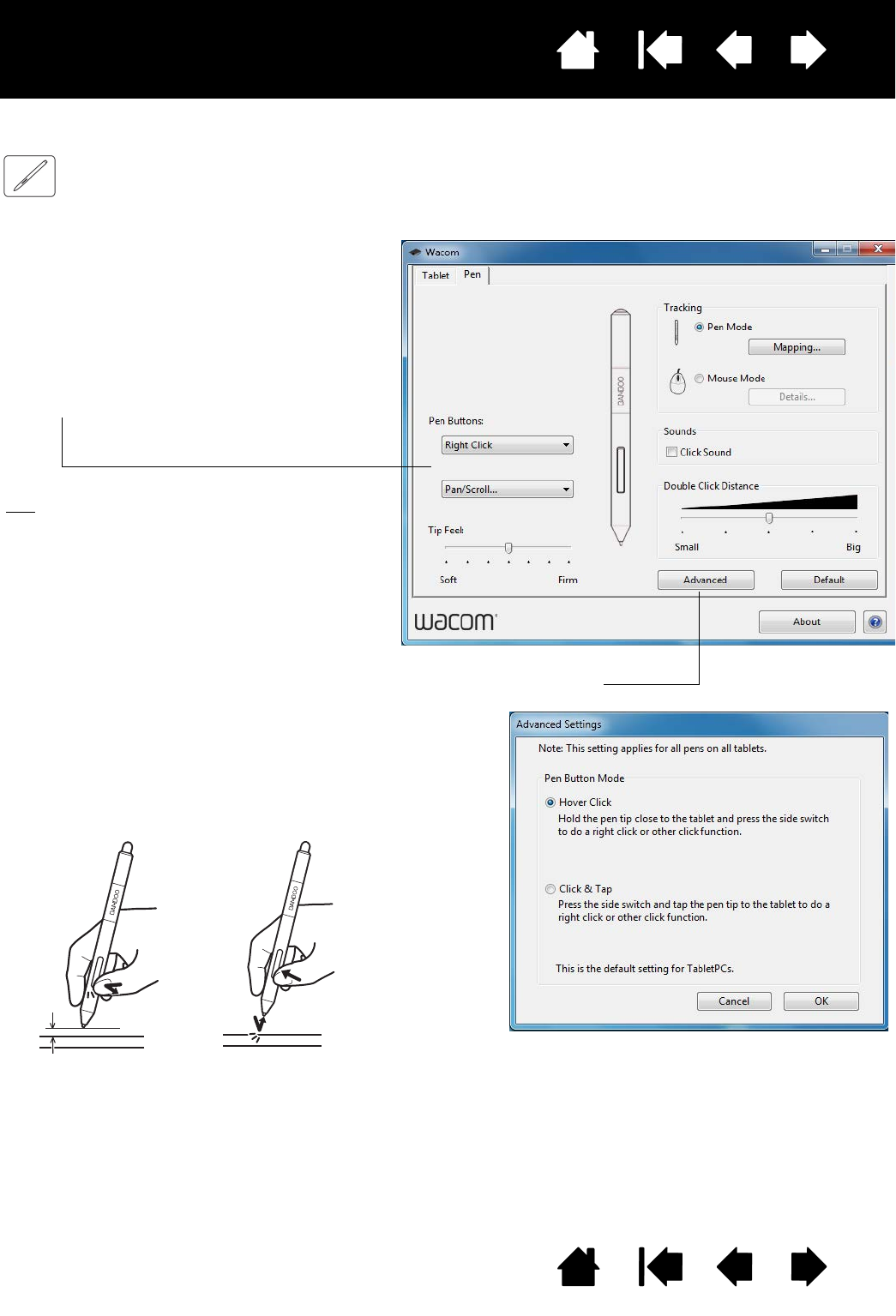
Contents Index
Contents 25
Index
25
SETTING THE PEN BUTTON FUNCTIONS
Select the PEN tab. Each pen button can be set to simulate a variety of mouse functions.
Select the function to perform when
pressing the upper or lower pen button.
The selected function occurs when you
bring the pen tip within 7 mm (0.28 inch) of
the tablet surface without touching the
tablet and then press the upper or lower
pen button.
Tip: To make double-clicking easier, set a
pen button to double-click
automatically by selecting DOUBLE
CLICK.
•Choose H
OVER CLICK to perform click functions without
touching the pen tip to the tablet surface.
•Choose C
LICK & TAP to enable the precise placement of
click functions. When selected, you must first press the pen
button and then touch the pen tip to the tablet surface in
order to perform the click function.
Hover click Click tap
You can change the SIDE SWITCH MODE to best fit the way you like to use the pen
when making right-clicks or other click functions. Click the ADVANCED button.
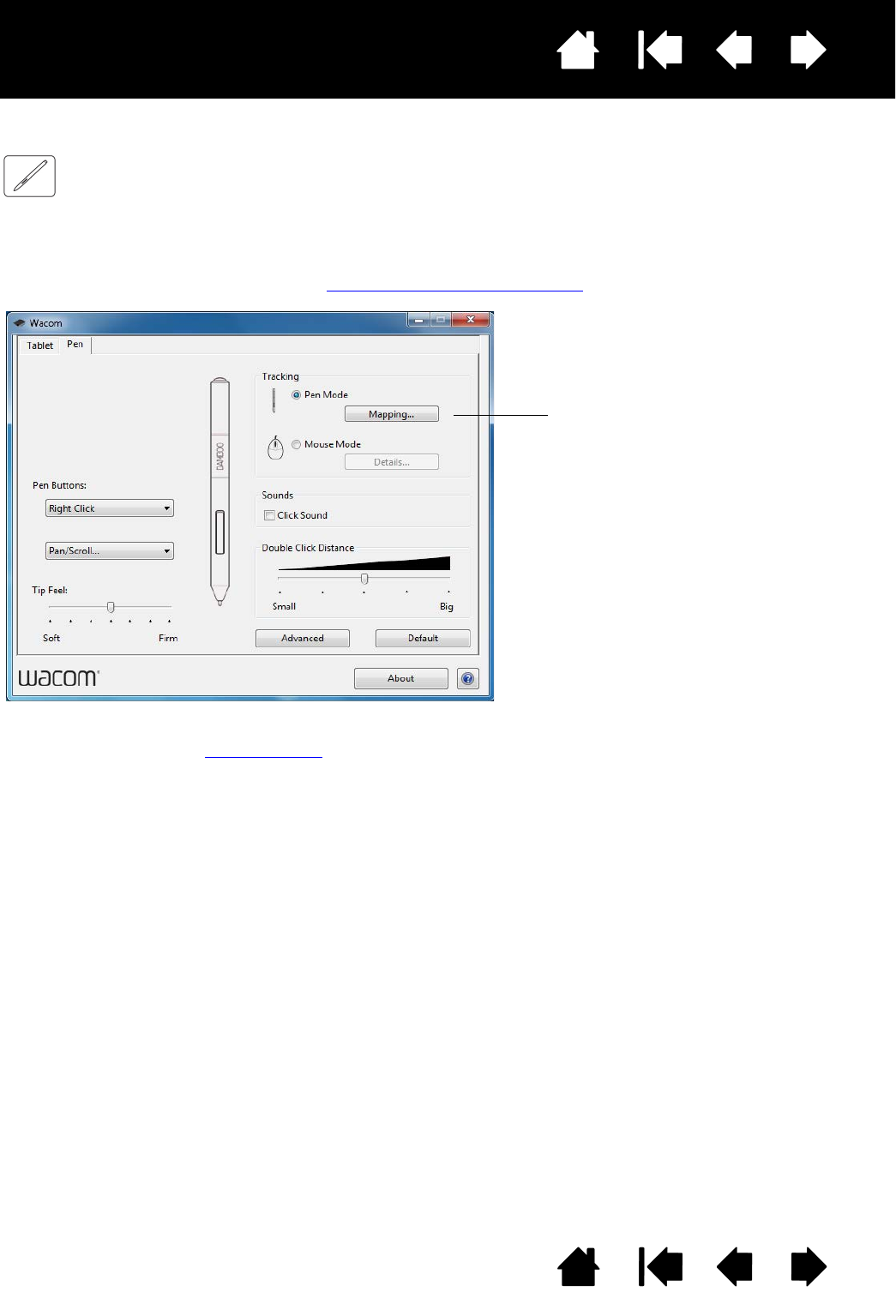
Contents Index
Contents 26
Index
26
SETTING THE TABLET MAPPING
Select the PEN tab. The tablet TRACKING options enable you to define the relationship between pen
movement on the tablet surface and cursor movement on the monitor screen.
By default the entire active area of the tablet maps to the entire monitor. If more than one monitor is in use
the tablet will map to all monitors. See working with multiple monitors.
TRACKING options control how the screen
cursor moves:
•P
EN MODE sets the cursor movement to
correspond with the position of your
pen on the tablet. Wherever you place
your pen on the tablet, the cursor will
jump to a corresponding point on the
screen. This is known as absolute
positioning, and is the default setting
for the pen.
Click MAPPING... to customize the tablet
mapping.
•M
OUSE MODE enables you to move the
screen cursor with a “pick up and slide”
motion similar to using a standard
mouse.
Click DETAILS... to set the pen speed in
mouse mode.
Note: If you frequently switch between pen mode and mouse mode,
you can assign the MODE TOGGLE... function to one of your pen
buttons or ExpressKeys.
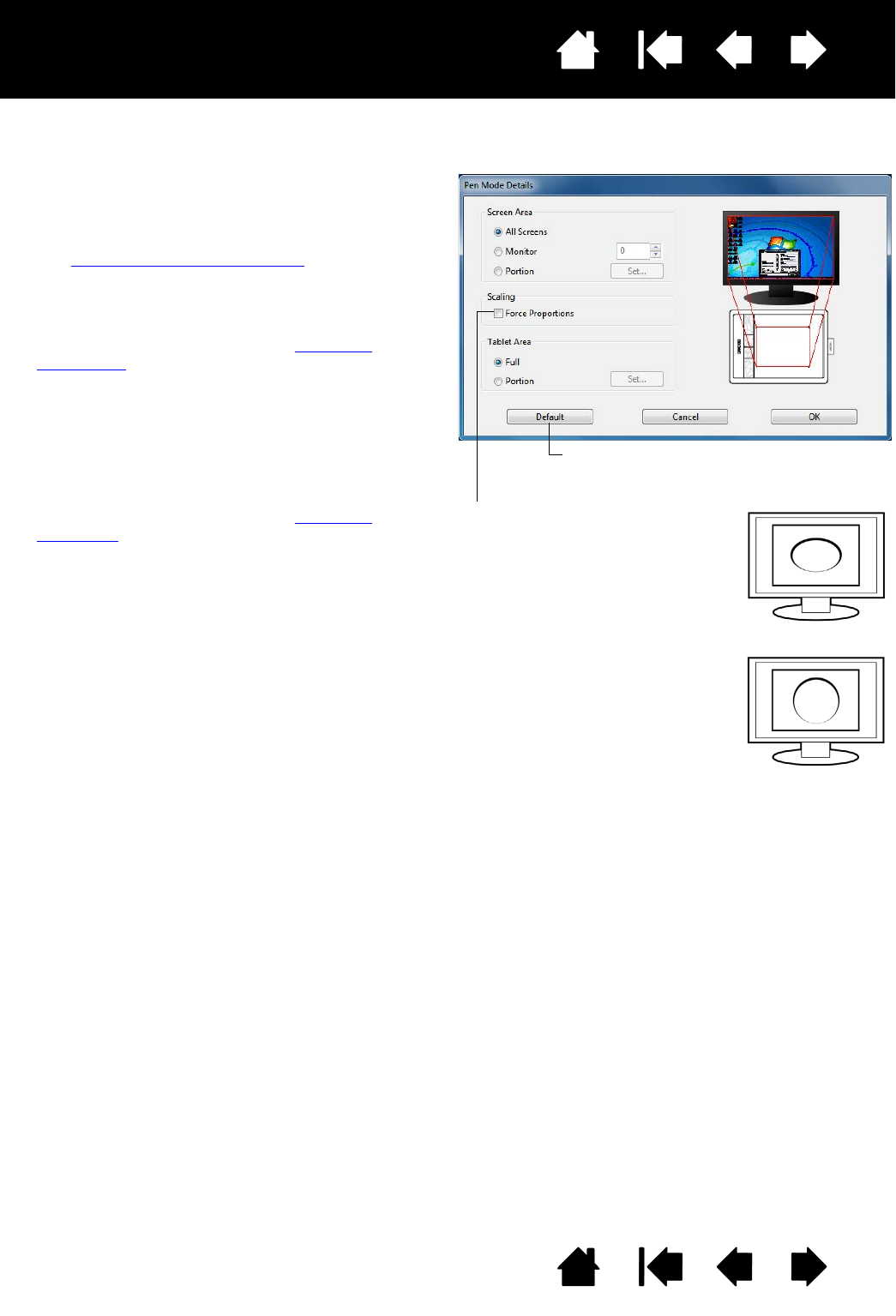
Contents Index
Contents 27
Index
27
In the Wacom tablet control panel PEN tab, click on the PEN MODE MAPPING... button to display the PEN
MODE DETAILS dialog box.
Use the SCREEN AREA options to select a screen
area for tablet to screen mapping.
•A
LL SCREENS. The entire monitor(s) area is
mapped. This is the default setting.
See working with multiple monitors.
•M
ONITOR. The entire area of a single monitor
that you choose is mapped.
•P
ORTION. A portion of the desktop area is
mapped. Click SET... to define the portion of
screen area.
Use the TABLET AREA options to select a tablet
area for tablet to screen mapping.
•F
ULL. The entire active area of the tablet is
mapped. This is the default setting.
•P
ORTION. A portion of the tablet area is
mapped. Click SET... to define the portion of
tablet area.
Note: Although the tablet is optimized for use
with 16 : 10 aspect ratio displays, the
default settings automatically adjust for
use with other aspect ratio displays.
Returns settings to their factory defaults.
When FORCE PROPORTIONS is
unchecked, the correct scale or
proportions are not maintained.
The selected tablet area is mapped
to the selected display area.
Drawing a circle on the tablet may
create an ellipse on the display
screen. This is the default setting.
When FORCE PROPORTIONS is
checked, the correct vertical and
horizontal proportions are
maintained. Drawing a circle on the
tablet results in a circle on the
display screen. Depending on your
settings, some portions of the
tablet active area may no longer be
usable when this option is
selected.
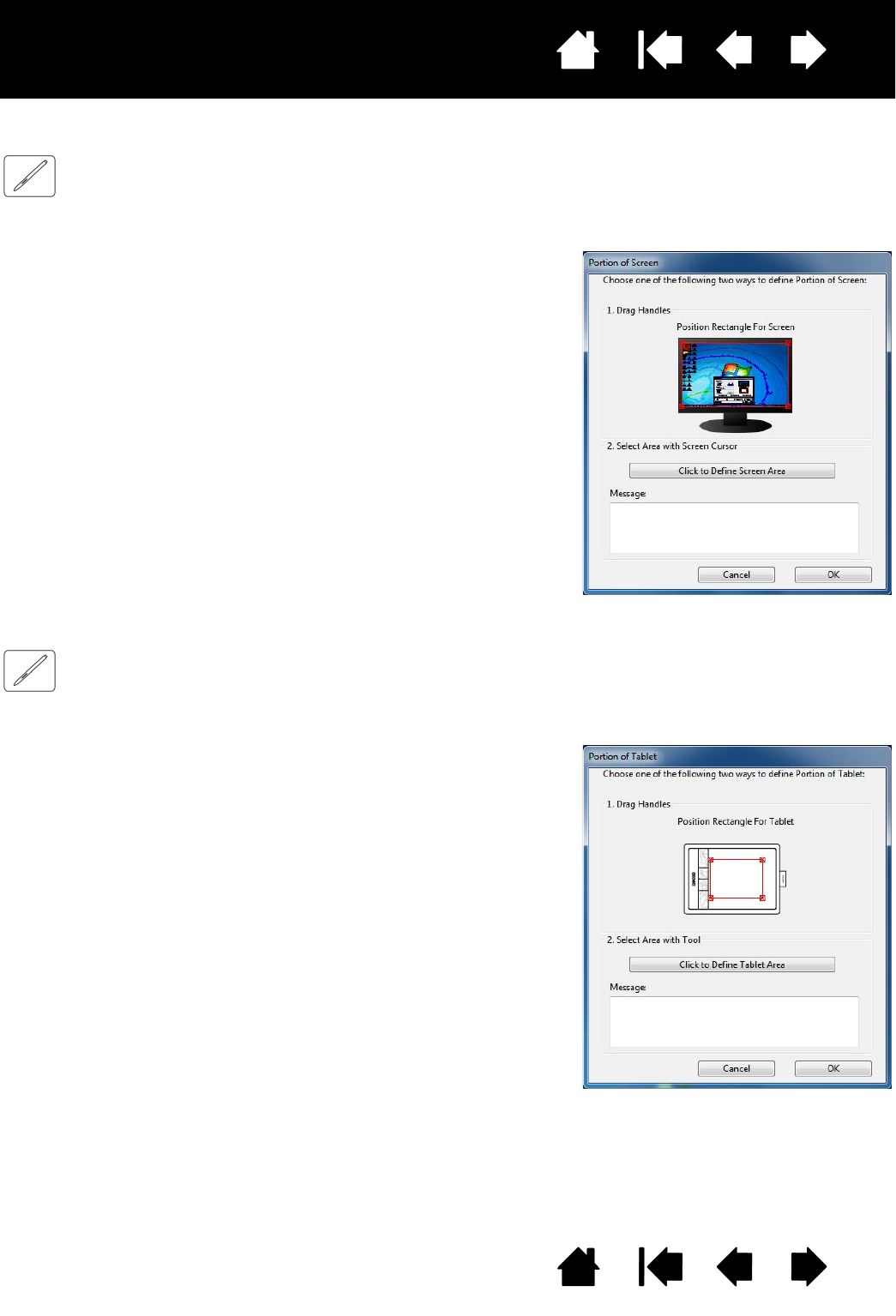
Contents Index
Contents 28
Index
28
PORTION OF SCREEN AREA
To define which portion of the display screen your tablet will map to, click on the PEN tab PEN MODE
MAPPING... button to display the PEN MODE DETAILS box. Choose SCREEN AREA PORTION and click SET....
PORTION OF TABLET AREA
To define the tablet area that will be mapped to the screen area, click on the PEN tab PEN MODE MAPPING...
button to display the PEN MODE DETAILS box. Choose TABLET AREA PORTION and click SET....
In the dialog that appears, choose a method for defining a portion of the
display.
• Drag corners of the foreground graphic to select the screen area.
• Select the CLICK TO DEFINE SCREEN AREA button and move the screen
cursor to select the screen area. Be sure to follow any MESSAGE
prompts.
After defining a portion of the screen, you may need to use a different
input device to access other portions of the screen area.
In the dialog that appears, choose a method for defining a portion of the
tablet:
• Drag corners of the foreground graphic to select the tablet area that
will be mapped to your selected screen area.
• Select the CLICK TO DEFINE TABLET AREA button and use your pen on
the tablet to select the tablet area. Be sure to follow any MESSAGE
prompts.
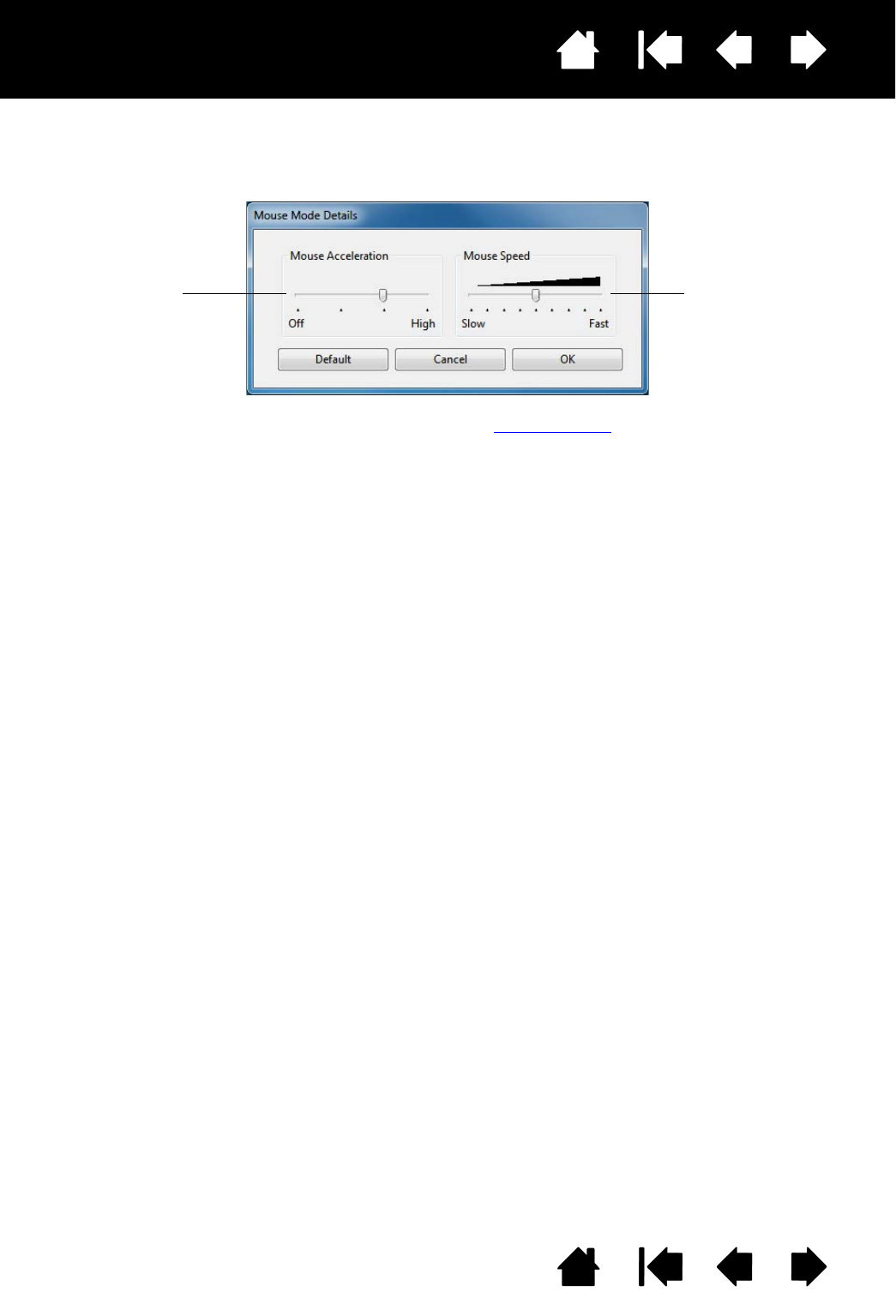
Contents Index
Contents 29
Index
29
SETTING THE PEN SPEED IN MOUSE MODE
To change the screen cursor acceleration and speed when using the pen in mouse mode, click on the PEN
tab MOUSE MODE DETAILS... button. A dialog box will be displayed where you can make your adjustments.
Sets the screen cursor
acceleration when in
mouse mode.
Sets the screen cursor
tracking speed when in
mouse mode.
Notes:
The dialog box will also appear when you set a button to MODE TOGGLE.... Only one acceleration and speed
setting can be made.
The mouse mode acceleration and speed settings are independent of system settings. Changes you make to
these settings in the Wacom tablet control panel do not affect similar system settings. However, changes
made to similar system settings may affect your Wacom tablet settings.
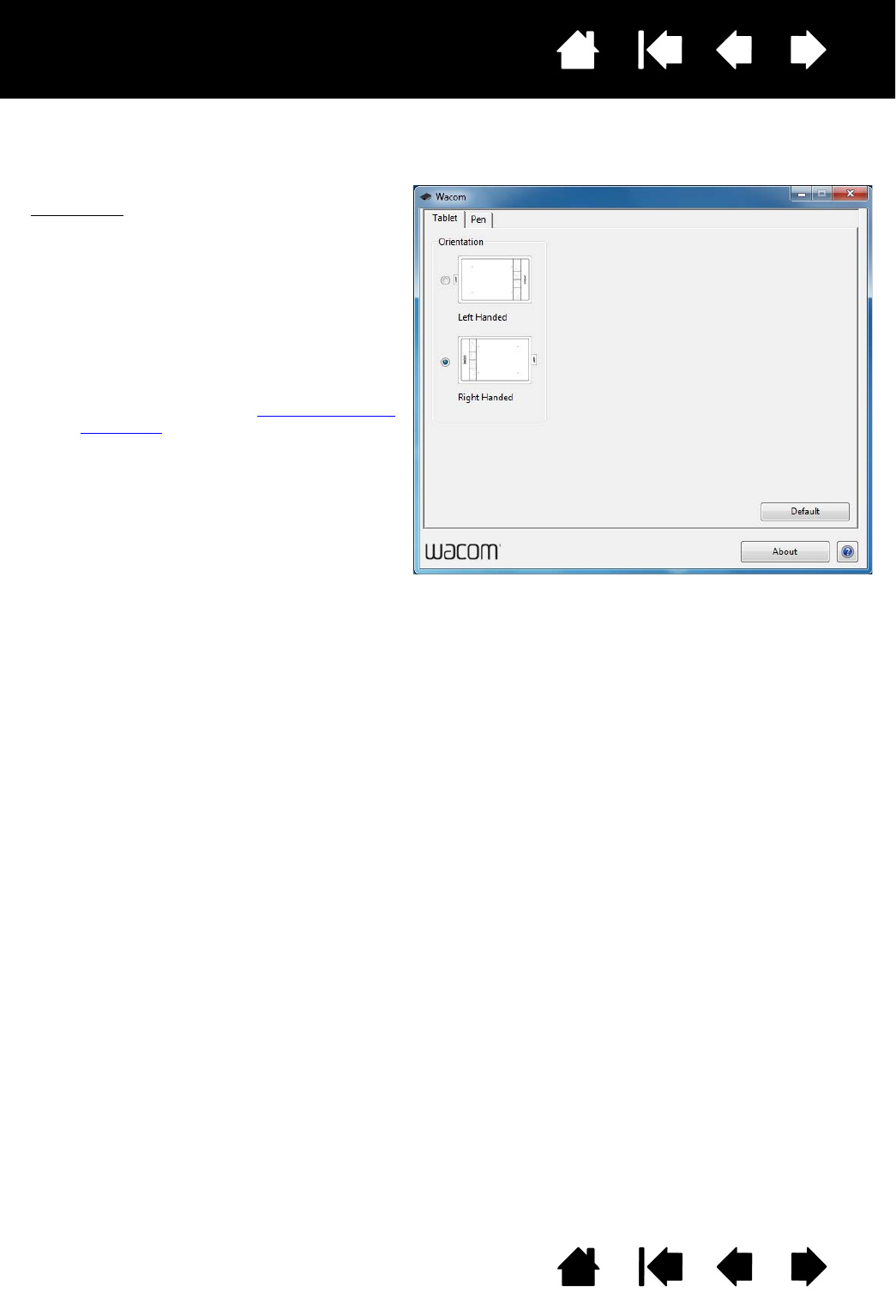
Contents Index
Contents 30
Index
30
CUSTOMIZING TABLET ORIENTATION
Choose the TABLET tab to set the tablet orientation.
ORIENTATION: Change how your tablet is
oriented by selecting RIGHT HANDED or LEFT
HANDED input. The tablet driver automatically
configures all aspects of the tablet for the
selected option. Next, physically rotate the
tablet to match your selection.
Note: At the system log on and user switching
screens, the tablet will use the default
orientation that was selected when the
driver was installed. If you want to
change the default orientation, you must
reinstall the driver. See configuring tablet
orientation.
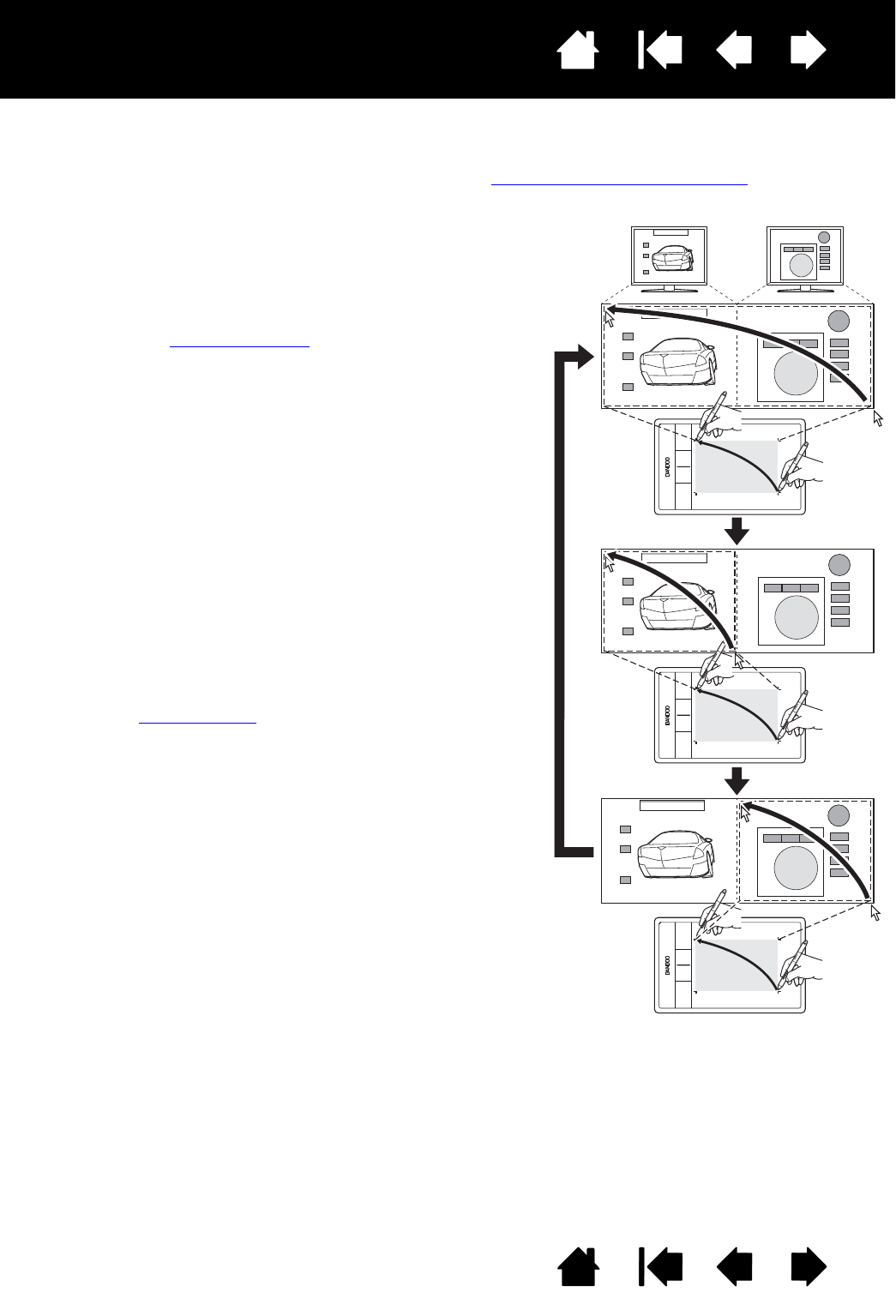
Contents Index
Contents 31
Index
31
WORKING WITH DISPLAY TOGGLE
Display Toggle is available when working on multiple monitor systems. This feature allows you to work with
your tablet on all displays or on one display at a time. See working with multiple monitors.
The entire display area of a multi-monitor system is set up for
extended mode and assigned to the active area of the tablet.
All monitors are selected in the toggle sequence.
• The base mapping is the tablet and display mapping
defined in the PEN MODE DETAILS dialog. By default, this
includes all monitors unless you have defined a specific
monitor as your primary monitor.
• As you toggle to the next monitor, the active tablet area
is mapped to that monitor (in pen mode).
• Toggling one more time after the last selected monitor
returns the system to the base mapping.
Any of the following actions will return the toggle sequence
to the base mapping:
• Launching a graphics application that supports pressure
sensitivity.
• Logging out of or rebooting the system.
• Switching users (Fast User Switching).
• Placing the system in sleep mode.
• Changing the PEN MODE DETAILS settings.
• Changing the resolution or number of displays on your
system.
•Using the MODE TOGGLE... function.
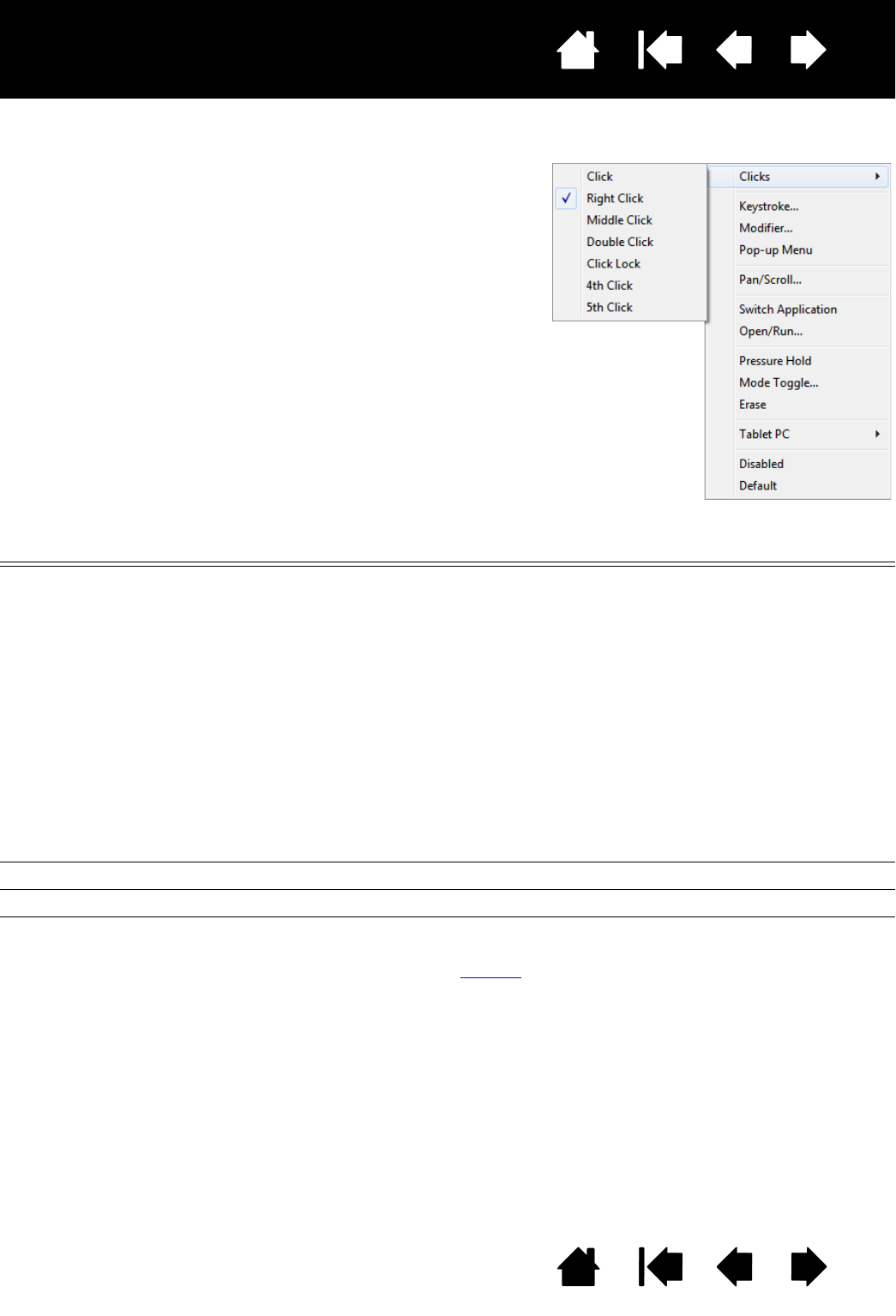
Contents Index
Contents 32
Index
32
BUTTON FUNCTIONS
FUNCTION DESCRIPTION
CLICKS
•CLICK Simulates a primary mouse button click. Default setting for the pen tip.
•R
IGHT CLICK Simulates a right mouse button click, which displays a context menu.
•M
IDDLE CLICK Simulates a middle mouse button click.
•D
OUBLE CLICK Simulates a double-click. For easier double-clicking, use this function
instead of tapping twice with the pen tip.
•C
LICK LOCK Simulates holding down the primary mouse button. Press the tool
button once to initiate click lock. Press the button again to release click
lock. Click lock is useful for dragging objects or selecting blocks of
text.
•4
TH CLICK Simulates a 4th mouse button click.
•5
TH CLICK Simulates a 5th mouse button click.
BACK Simulates the BACK command in browser applications.
FORWARD Simulates the FORWARD command in browser applications.
ERASE Pen only. Sets a button so that when the button is pressed, the pen tip
will act like the eraser (when equipped) in applications that support the
ERASE function. See erasing.
Customize your Wacom tablet for the way you like to work.
Simply use the Wacom tablet control panel to change the
button function that is assigned to a pen button, Button
function options may vary, depending on your tablet model. .
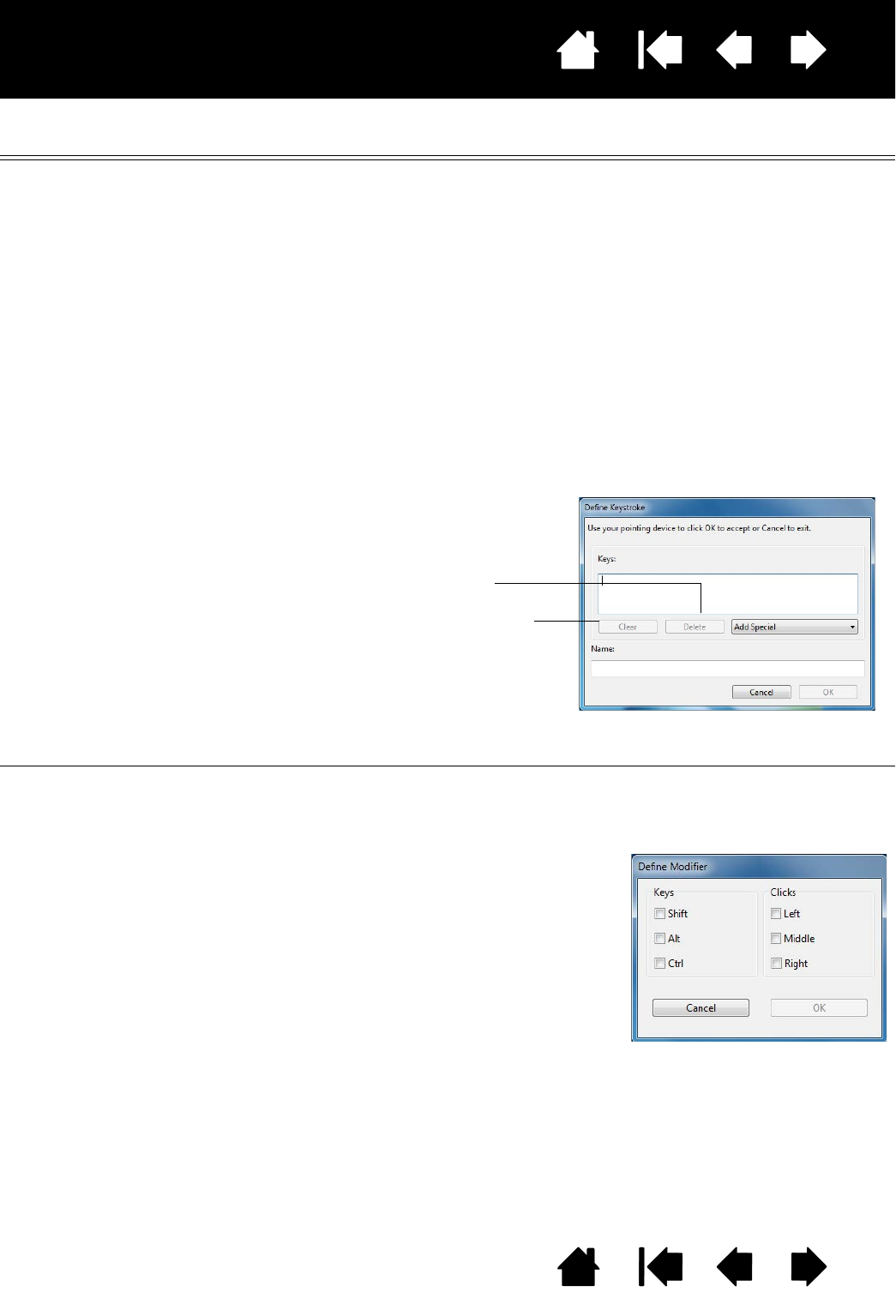
Contents Index
Contents 33
Index
33
FUNCTION DESCRIPTION
KEYSTROKE... Enables you to simulate keystrokes. Select this option to display the
DEFINE KEYSTROKE dialog box.
Enter a keystroke or keystroke combination in the KEYS entry box.
Keystroke combinations can include letters, numbers, function keys
(such as F3) and modifier keys (such as SHIFT, ALT, or CTRL for
Windows, or SHIFT, OPTION, COMMAND, and CONTROL for Mac). You can
also choose special keystrokes or keystroke combinations from the
ADD SPECIAL pull-down menu.
After defining a keystroke or keystroke sequence, click OK.
Important: Because the ENTER (Windows) and RETURN (Mac)
keys can be selected as a defined keystroke, they cannot be
used to select OK. You must use your pen to click on the OK
button.
Enter a name for the keystroke definition. The name will be displayed
with the respective control..
To learn which keystroke shortcuts are supported by a particular
application, see the documentation that came with the application.
MODIFIER... Enables you to simulate modifier key(s) (such as SHIFT, ALT, or CTRL for
Windows, or SHIFT, OPTION, COMMAND, and CONTROL for Mac). Many
applications use modifier keys to constrain the size or placement of
objects.
Clears the keystroke entry box.
Deletes only the last entry
in the keystroke entry box.
Choose one or more modifier key options.
Choose a CLICKS option to simulate
pressing a button of the selected type on
a mouse.
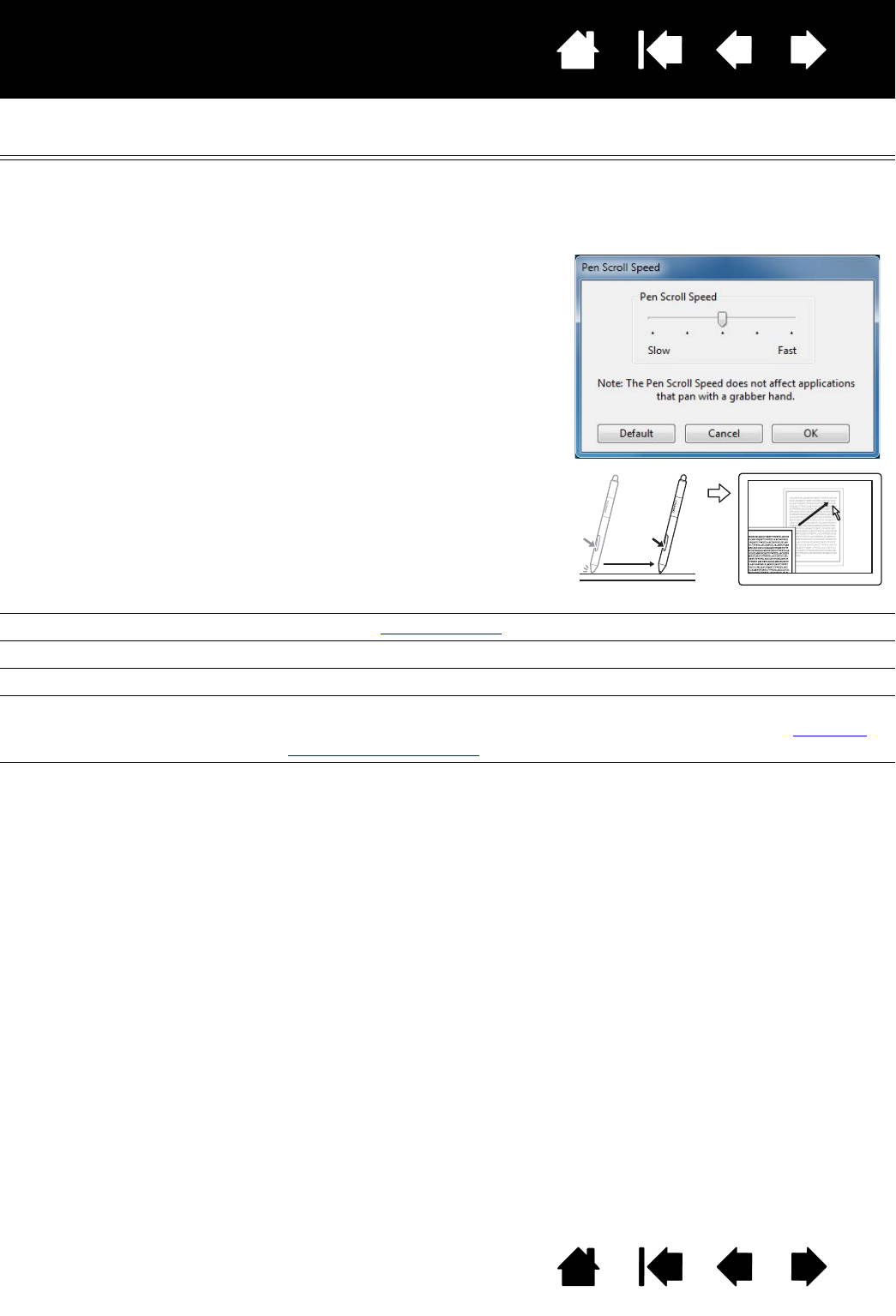
Contents Index
Contents 34
Index
34
FUNCTION DESCRIPTION
PAN/SCROLL Pen only. Enables you to position a document or image in any direction
within the active pane. Do this by pressing a pen button set for PAN/
SCROLL and then dragging with the pen tip across the tablet active
area.
BAMBOO DOCK Opens the Bamboo Dock.
WACOM PREFERENCES Opens the Wacom tablet control panel.
SHOW DESKTOP Minimizes all open windows to display a clean desktop.
DISPLAY TOGGLE For multiple monitor systems. Enables you to toggle the current tablet
mapping and screen cursor between different displays. See Working
with multiple monitors.
SWITCH APPLICATIONS Brings up the application switching dialog with focus on the next open
application. On Windows 8, Windows 7 or Vista systems running Aero,
Flip 3D will be activated with focus on the next open application.
When you select PAN/SCROLL, you
are prompted to set a scrolling
speed for use in applications that do
not support grabber hand (pixel-
level) panning.
A slower setting reduces the scroll
rate and is useful for close-up and
detail work where you need precise
control of the image.
As you move the pen tip, the
document or image is repositioned
to follow the direction of pen
movement on the tablet.
Release the button or lift the pen tip
from the tablet surface when you are
done.
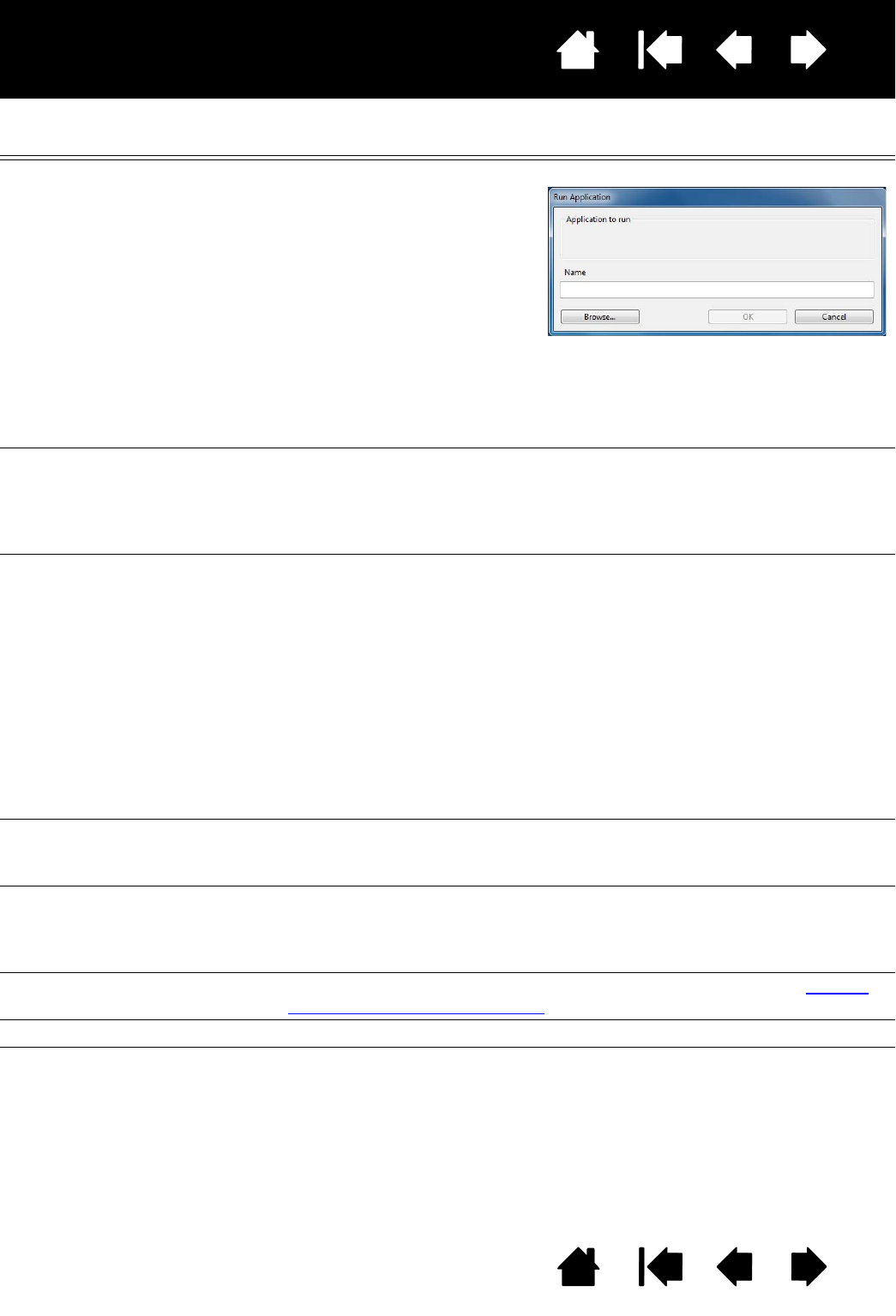
Contents Index
Contents 35
Index
35
FUNCTION DESCRIPTION
OPEN/RUN... Opens the RUN APPLICATION dialog box.
INK TOGGLE (Mac.) Toggles the “ink in any application” function of Ink on and off. Ink
automatically recognizes and converts your handwriting into text and
inserts it into a document. Handwriting recognition must be turned on
for this function to work. See your Mac help for information on working
with Ink.
TABLET PC
•T
ABLET PC INPUT PANEL (Tablet PCs and Windows systems that support the Tablet PC Input
Panel.) Opens the Tablet PC Input Panel when you press a tool button
set to this function.
•J
OURNAL (Windows 8, Windows 7 and Vista, and Tablet PC systems that include
Microsoft Journal.) Opens Microsoft Journal.
•T
ABLET PC DEFINED (Tablet PCs and Windows systems that support the Tablet PC Input
Panel.) Sets the button function according to settings found in the:
• Windows 8, Windows 7 and Vista TABLET PC SETTINGS and PEN AND
INPUT DEVICES control panels.
• Windows XP Tablet Edition TABLET AND PEN SETTINGS control panel.
EXPOSÉ (Mac.) Tiles all open windows. To access this option, first choose
KEYSTROKE... and then click on the ADD SPECIAL menu within the dialog
box.
PRESSURE HOLD Locks the pressure at the current pressure level until the button is
released. For example, you can paint with pressure sensitivity until you
reach the brush size that you like. You can then press the button and
continue painting with the same size brush until the button is released.
MODE TOGGLE... Toggles pen input between pen mode and mouse mode. See setting
the pen speed in mouse mode.
DISABLED Disables the button function.
DEFAULT Returns a button to its default setting.
Click BROWSE... to locate an
application, file, or script to
launch. Your selection appears in
the APPLICATION TO RUN box.
Click OK to accept the selection.
The dialog box will close and the OPEN/RUN... option you have selected will be
assigned as your tool button option. Press the tool button to launch the
assigned option.
If your selection is for the Pop-up Menu, it will be displayed in the Pop-up
Menu list.
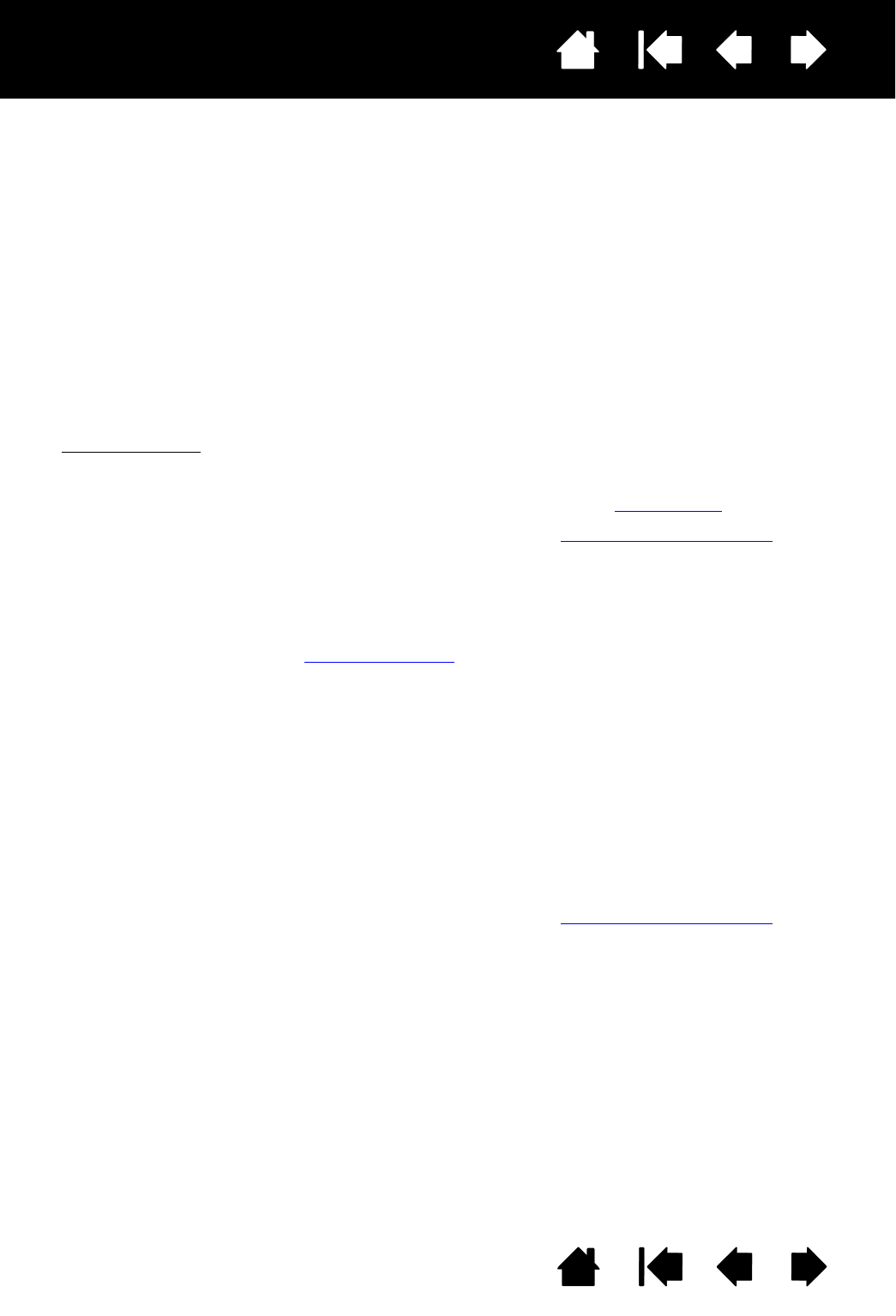
Contents Index
Contents 36
Index
36
TESTING YOUR TABLET
1. Turn on your computer and wait until the system has fully loaded.
2. Check the USB connection. The tablet status LED should glow whenever the tablet is properly
connected and your computer has registered it as a USB device. If not:
• Make sure the tablet USB cable is securely connected to an active USB port on your computer.
• Check the tablet USB cable for damage.
• If you are connecting the tablet to a USB hub (or hub device such as a keyboard with USB ports), be
sure the USB hub is properly connected to your computer and is active.
• If the status LED does not illuminate after your computer is on and has finished booting up, your
USB port may be disabled. Verify that you have connected the tablet to an active USB port.
• Connect the tablet to a different USB port or try connecting to the USB port on another computer.
3. Check pen input:
• Check pen input. If the tablet driver does not load properly, pen input will not be available. (If you
have a pen-only tablet model, you will be able to use the pen tip to move the screen cursor and
click. You will also be able to use the pen buttons to CLICK and RIGHT CLICK, but there will be no
other pen functionality.) Install the tablet driver software. See also testing a pen.
4. If any of these tests fail you may have defective hardware. See technical support options.
After testing, use the Wacom tablet control panel to reconfigure your tablet for any custom settings you
may originally have been using.G
TESTING A PEN
1. First perform the procedures for testing your tablet.
2. Check the pen by opening the Wacom tablet control panel and selecting the PEN tab. Click on the
DEFAULT button to return the pen to its default settings. Next:
• Touch the pen tip and then the eraser (when equipped) to the tablet active area. Each time the tip or
eraser makes contact with the tablet surface, the status LED should brighten.
• Without applying pressure to the pen tip, hold the pen tip within approximately 7 mm (0.28 inch) of
the tablet surface and press each pen button in turn. For each button press, the status LED should
brighten.
• While still within proximity, but without touching the tablet surface, move your pen across the active
area of the tablet. The screen cursor should move in the corresponding direction on your monitor or
display screen.
3. If any of these tests fail you may have defective hardware. See technical support options.
4. After testing, use the Wacom control panel to reconfigure your tablet and pen for any custom settings
you may originally have been using.
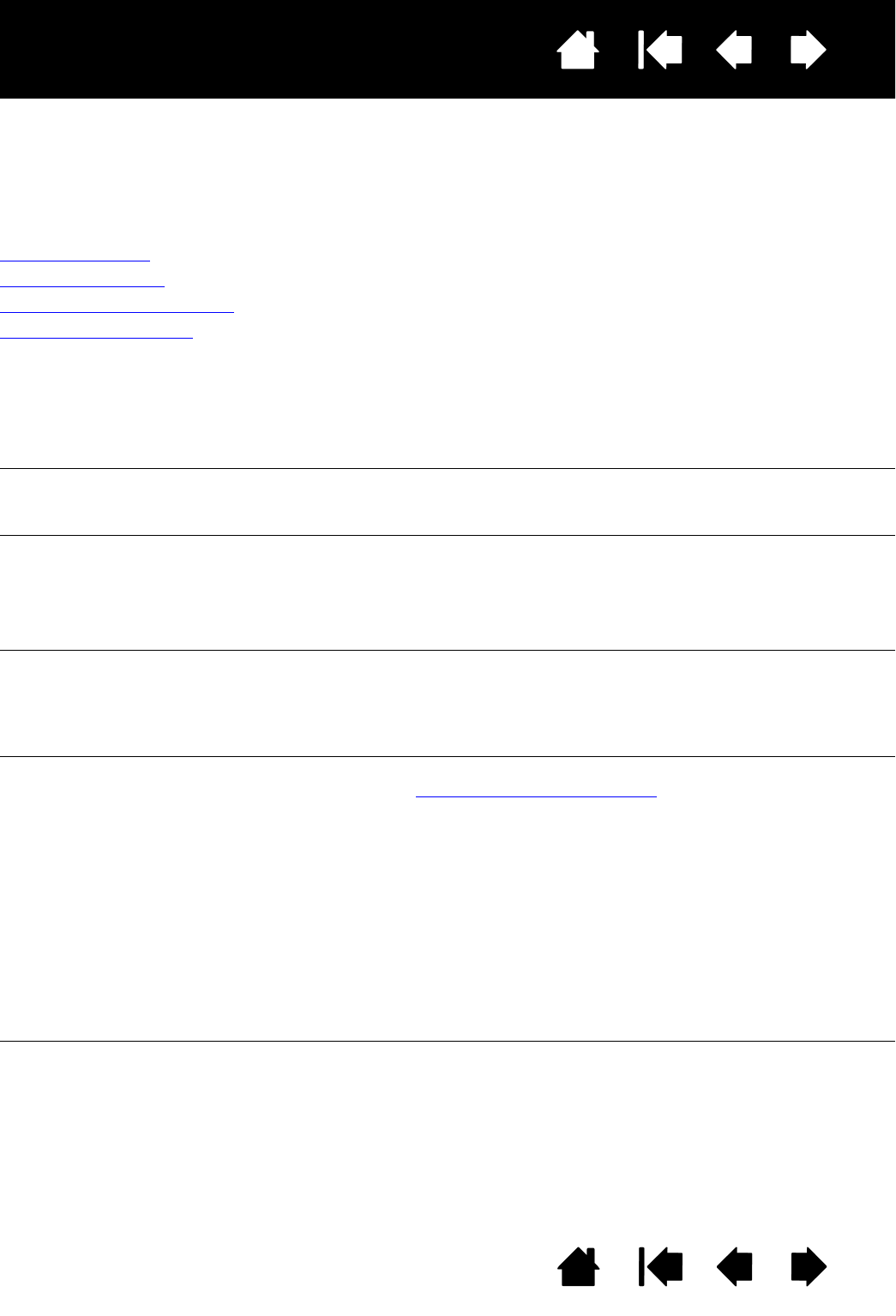
Contents Index
Contents 37
Index
37
TROUBLESHOOTING TABLES
If you encounter problems with your Wacom tablet or pen, see the following tables. Your problem may be
described here, and you can try the solution offered. Check the tablet Read Me file for the latest information
updates.
For additional information, visit the Wacom web site at http://www.wacom.com .
General problems
Pen input problems
Windows-specific problems
Mac-specific problems
GENERAL PROBLEMS
PEN INPUT PROBLEMS
The computer does not have
an available USB port. Check if there is an available USB port on a USB hub. If not available
you will need to add a USB hub or USB card.
The tablet status LED does
not illuminate. Verify that your tablet USB cable is properly connected to an active
USB port. If you are connecting to a USB hub, make sure the hub is
connected to an active USB port and that the hub is active.
The computer does not go to
sleep. When you are not using the pen, remove it from the tablet surface or
the tablet will continue to send data, keeping the computer awake.
Note: Because some metallic or other conducting objects can also
cause the tablet to send data, it is best to keep the tablet
surface clear of all objects when not in use.
The screen cursor is very
erratic or jumps around when
using the tablet.
On rare occasions the tablet may receive interfering radio frequencies
from a computer monitor or nearby AM radio station. If you notice
interference from a monitor, try moving the tablet at least six (6) inches
away from the monitor, or change the monitor refresh rate or monitor
resolution.
The tablet is set for RIGHT
HANDED (or LEFT HANDED), but
at the log on screen the tablet
seems to work upside down.
Reinstall the tablet driver software and change the default orientation of
the tablet. See configuring tablet orientation.
The pen does not position the
screen cursor, or otherwise
does not work.
If the tablet driver does not load properly, pen input will not be
available.
You will be able to use the pen tip to move the screen cursor and click.
You will also be able to use the pen buttons to CLICK (lower button) and
RIGHT CLICK (upper button), but there will be no other pen functionality.
Install the driver software for the tablet.
The pen does not draw or ink
with pressure sensitivity. Some applications require that you turn on the pressure capabilities
within the application or selected tool before the pen will respond as a
pressure-sensitive tool.
Verify also that your application supports pressure sensitivity.
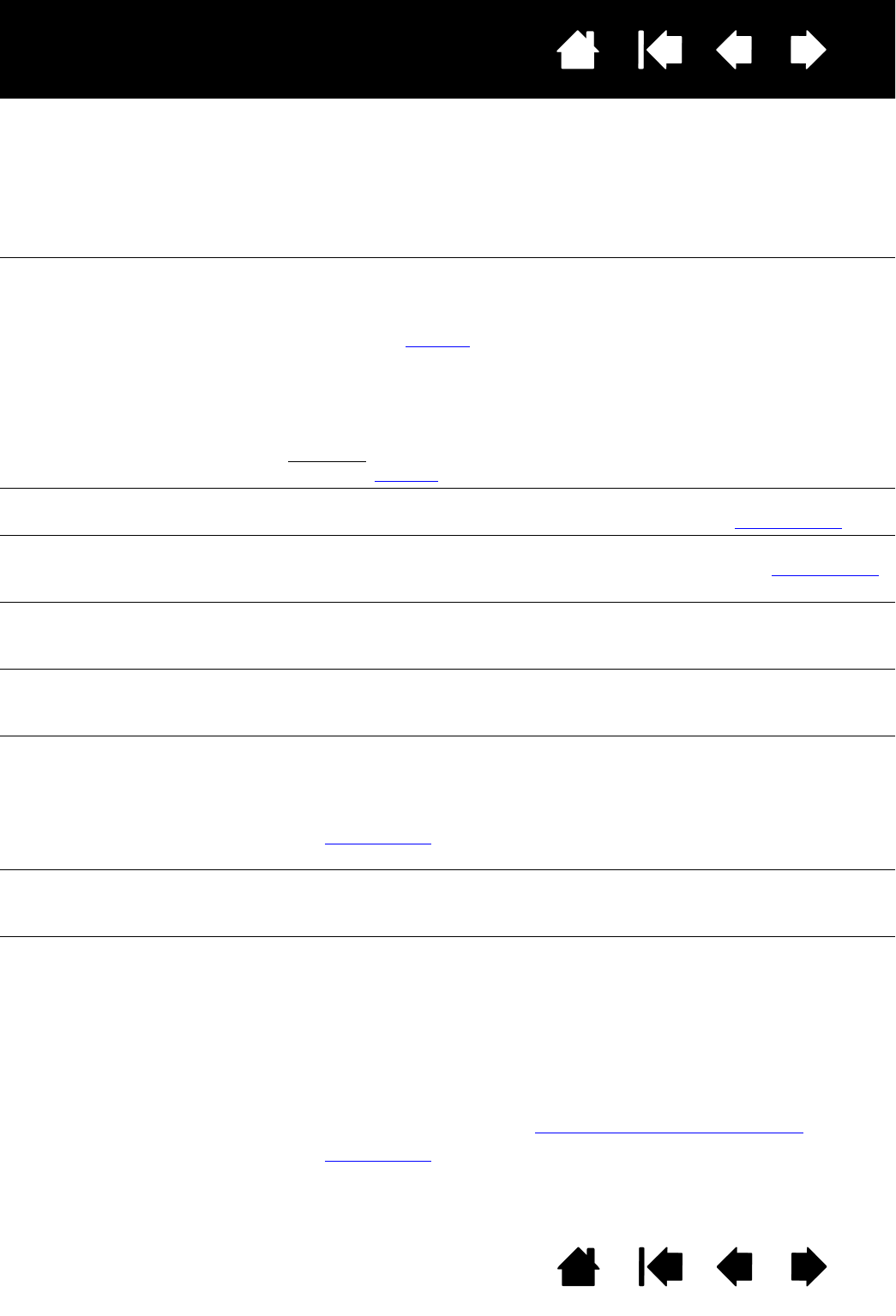
Contents Index
Contents 38
Index
38
Clicking is difficult. Open the Wacom control panel and go to the PEN tab. Try using a
lighter TIP FEEL.
Select the CLICK SOUND option (the check box should be checked). This
will enable you to hear when the pen registers a mouse click. Your
computer speakers must be turned on and the volume audible before
you can hear a click sound.
Double-clicking is difficult. Be sure you are quickly tapping the tablet twice in the same place on
the tablet active area.
Using a pen button set to double-click is recommended (review the
techniques in clicking).
Open the Wacom tablet control panel and go to the PEN tab.
• Try increasing the DOUBLE CLICK DISTANCE.
• Try using a lighter TIP FEEL.
Windows: Try setting your system to launch programs with a single
click. See clicking.
The pen selects everything, or
will not stop selecting. Open the Wacom tablet control panel and go to the PEN tab. Move the
TIP FEEL slider toward FIRM. If this does not help, see testing a pen.
The eraser (when equipped)
selects everything or will not
stop erasing.
Open the Wacom tablet control panel and go to the PEN tab. Move the
ERASER FEEL slider toward FIRM. If this does not help, see testing a pen.
You notice a screen delay at
the beginning of pen or inking
strokes.
Open the Wacom tablet control panel and go to the PEN tab. Try
decreasing the DOUBLE CLICK DISTANCE.
You have to press hard with
the pen when clicking,
drawing, or writing.
Open the Wacom tablet control panel and go to the PEN tab. Move the
TIP FEEL slider toward SOFT.
The pen tip does not function. Depending on your tablet model, the status LED should brighten or
change color when the pen tip is pressed to the tablet. Be sure you are
using the pen that originally came with your product. Other pens may
not function properly on the Wacom tablet.
See testing a pen to verify pen operation. If any of the tests fail you may
have defective hardware.
The screen cursor jumps
back. Do not place the pen on the tablet when it is not in use or when you are
using another pointing device. Leaving your pen on the tablet may
interfere with screen cursor positioning when using other input devices.
The upper or lower pen button
does not work. Be sure you press the pen button when the pen tip is within 7 mm (0.28
inch) of the tablet active area. Do this without pressing down on the
pen tip.
From the Wacom tablet control panel, verify that the pen button is set
to the function you are expecting to occur.
In the Wacom tablet control panel, click on the PEN tab ADVANCED
button. If CLICK & TAP is selected, you will need to first press the pen
button and then touch the pen tip to the tablet surface in order to
perform a click function. See setting the pen button functions.
See testing a pen to verify pen operation. If any of the tests fail you may
have defective hardware.

Contents Index
Contents 39
Index
39
Cannot move the cursor
where you want to on the
screen, or the line you are
drawing does not line up with
the location of the pointer in
paint applications.
Open the Wacom tablet control panel. Verify that PEN MODE is selected.
If this does not help, click on the DEFAULT button to reestablish the
default tablet to screen mapping. If you are still having difficulty, remove
the tablet preferences (see Windows-specific problems or Mac-specific
problems for details).
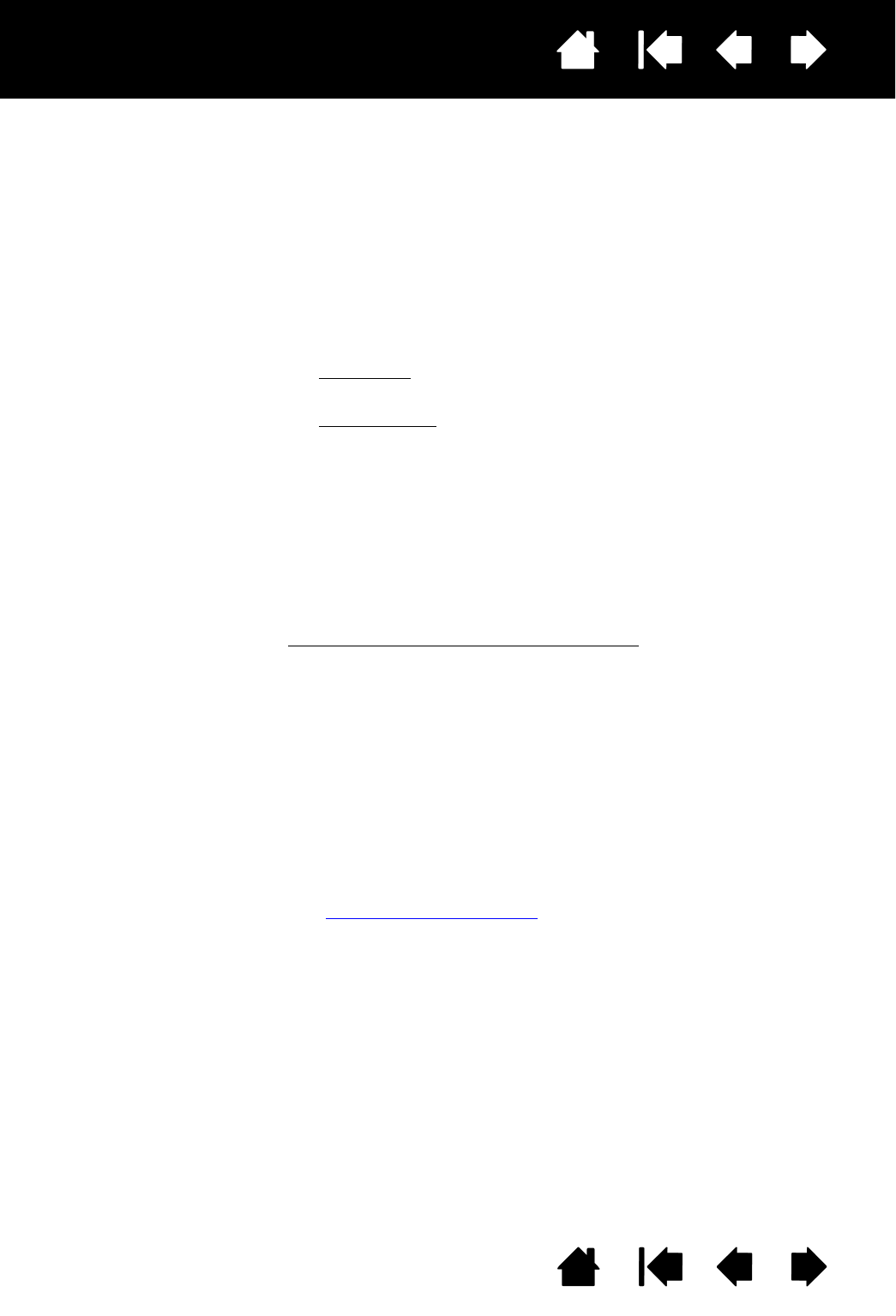
Contents Index
Contents 40
Index
40
WINDOWS-SPECIFIC PROBLEMS
MAC-SPECIFIC PROBLEMS
You suspect the tablet
preferences may be
corrupted, or want to make
certain that all settings are at
their factory defaults.
Use the Wacom Tablet Preference File Utility to work with preferences.
Close any open applications. Click the START icon and select ALL
PROGRAMS. Then select WACOM TABLET and WACOM TABLET PREFERENCE
FILE UTILITY.
• It is a good idea to first back up your tablet preferences. In the
WACOM TABLET PREFERENCE FILE UTILITY dialog box, click BACKUP...
and follow the prompts.
• Then, use the Wacom Tablet Preference File Utility to delete the
tablet preferences as follows:
Single user. Under MY PREFERENCES, click REMOVE to delete the
preferences for the current user.
Multiple users. Under ALL USER PREFERENCES, click REMOVE to
delete preferences for multiple users. Administrator rights are
required to delete preferences for all users. Relaunch any currently
open tablet-aware applications that you may be running.
You can quickly restore tablet preferences that have been backed up
by clicking RESTORE... under MY PREFERENCES.
At startup, a dialog box
appears telling you that either
the driver failed to load or the
tablet preferences have not
yet been created.
The tablet was not detected at startup.
If connected with the provided USB cable:
• Make sure the USB cable is securely connected to an active USB
port on your computer or USB hub. Make sure that the tablet status
LED is illuminated.
•From the G
O menu, select UTILITIES and launch the SYSTEM
PROFILER. Select USB from the HARDWARE section of the CONTENTS
list. A Wacom USB tablet model should be listed. If a tablet model
is not listed, check the USB tablet cable connection or try plugging
the tablet into a different USB port.
If you are still having difficulties, uninstall then reinstall the tablet driver
software.
If this does not help, contact Wacom for Technical Support.
See technical support options.

Contents Index
Contents 41
Index
41
You suspect the tablet
preferences may be
corrupted, or want to make
certain that all settings are at
their factory defaults.
Use the Wacom Tablet Utility to work with preferences. Close any open
applications. Open the main APPLICATIONS folder. Then open the
WACOM TABLET folder and run the WACOM TABLET UTILITY.
• It is a good idea to first back up your tablet preferences. In the
Wacom tablet Utility, select CURRENT USER or ALL USERS. Then click
BACKUP... and follow the prompts.
• Then, delete the tablet preferences as follows:
Single user. When the utility starts, select CURRENT USER and click
REMOVE. Log out, then log back in. When the tablet driver loads it
will create a new preferences file with the factory defaults.
Multiple users. When the utility starts, select ALL USERS and click
REMOVE. Log out, then log back in. When the tablet driver loads it
will create new preferences files with the factory defaults.
You can quickly restore tablet preferences that have been backed up
for the CURRENT USER or ALL USERS by clicking on RESTORE... within the
utility.
Note: Do not manually remove the WACOM TABLET.PREFPANE file from
the main LIBRARY PREFERENCEPANES folder. This file is only to be
removed when uninstalling the tablet software driver, and then
only when using the WACOM TABLET UTILITY.
Ink does not work correctly
with the tablet. There may be a problem with the Ink preferences. Remove the
damaged preference files as follows. They will be re-created when you
enable handwriting recognition.
1. Open SYSTEM PREFERENCES, choose SHOW ALL and select INK. Then
turn off handwriting recognition.
2. From the GO menu, choose your HOME. Open the LIBRARY and
PREFERENCES folders. Remove the following preferences:
•COM.APPLE.INK.FRAMEWORK.PLIST
•COM.APPLE.INK.INKPAD.PLIST
•COM.APPLE.INK.INKPAD.SKETCH
3. Go back to SYSTEM PREFERENCES and INK, and then enable
handwriting recognition.
4. Test the Ink function using your tablet and pen.
If this procedure does not resolve your problem with Ink, contact Apple
Support for further assistance. Wacom is not the software
manufacturer for Ink and we are limited in our abilities to support a third
party software application.
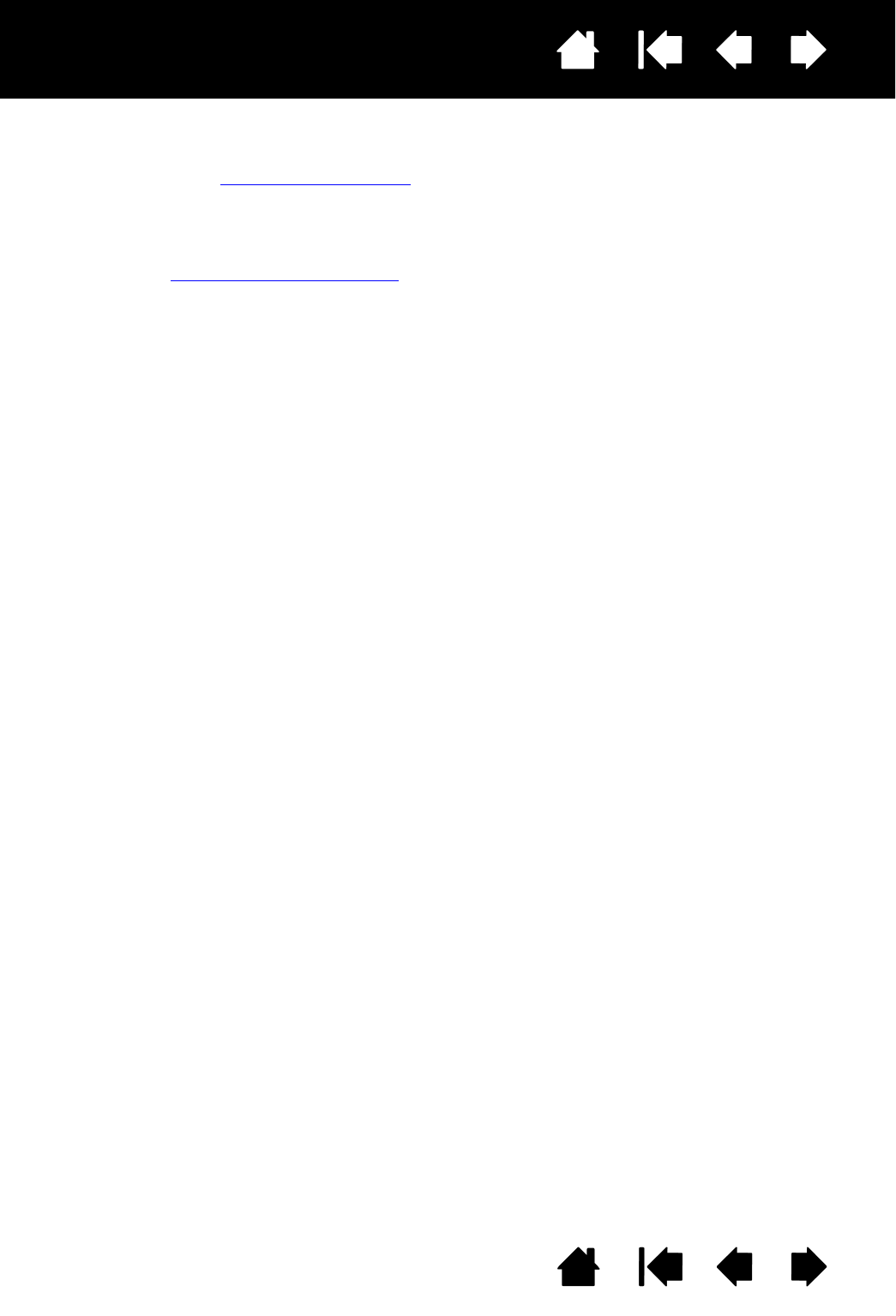
Contents Index
Contents 42
Index
42
TECHNICAL SUPPORT OPTIONS
If you have a problem with your tablet, first check the tablet Quick Start Guide to be sure the unit is installed
correctly. Then review the Troubleshooting tables and procedures.
If you cannot find the answer in this manual, you can check the product FAQs (Frequently Asked
Questions) on the Wacom web site for your region.
If you have an Internet connection you can download the latest software drivers from the Wacom web site
for your region. See obtaining driver downloads.
If you cannot solve the problem and you think your tablet is not working properly, contact the Wacom
support staff for the area where your product was purchased. See the tablet Read Me file, located on the
Wacom tablet Installation CD, for contact information.
When you call, you should be at your computer with the following information available:
• This manual.
• Tablet serial and model number. (Look on the bottom of the tablet.)
• Driver version number. (See the Wacom tablet Installation CD or click on the Wacom tablet control
panel ABOUT button.)
• The make and model of your computer, and operating system version number.
• A list of peripheral devices attached to your computer.
• The software application and version you were using when the problem occurred.
• The exact wording of any error message that appeared on your screen.
• What happened and what you were doing when the problem occurred.
• How you tried to solve the problem.
You can also contact the Wacom Customer Care Center by visiting the Wacom web site for your region and
completing an Email Inquiry form.

Contents Index
Contents 43
Index
43
OBTAINING DRIVER DOWNLOADS
Wacom periodically updates the tablet software driver to maintain compatibility with new products. If you
are having a compatibility problem between the Wacom tablet and a new hardware or software product, it
may be helpful to download a new software driver (when available) from the Internet.
USA, Canada, Central and South America
Europe, Middle East and Africa
Japan
Asia Pacific (English)
China
Hong Kong
Korea
Taiwan
Thailand
Worldwide Web: http://www.wacom.com Software updates
Worldwide Web: http://www.wacom.eu/downloads Software updates
Worldwide Web: http://tablet.wacom.co.jp/download/down1.html Software updates (Japanese)
Worldwide Web: http://www.wacom.asia Software updates (English)
Worldwide Web: http://www.wacom.com.cn Software updates
(Simplified Chinese)
Worldwide Web: http://www.wacom.com.hk Software updates
(Traditional Chinese)
Worldwide Web: http://www.wacom.asia/kr Software updates (Korean)
Worldwide Web: http://www.wacom.asia/tw Software updates
(Traditional Chinese)
Worldwide Web: http://www.wacom.asia/th Software updates
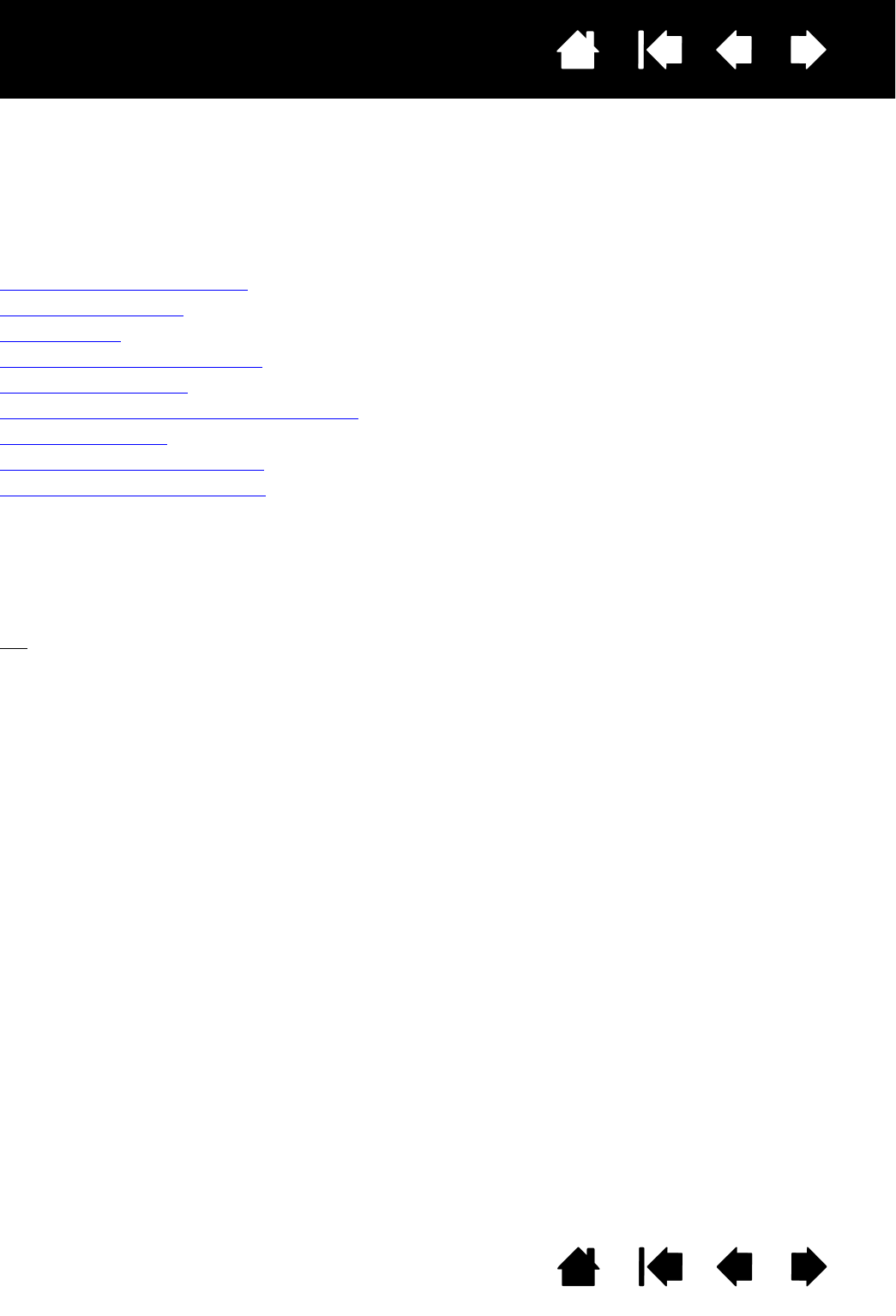
Contents Index
Contents 44
Index
44
APPENDIX
This section contains tips on caring for your Wacom tablet, instructions on how to uninstall the tablet
software, information about digital inking, and more.
Caring for Your Wacom tablet
Replacing the pen nib
Bamboo Dock
Uninstalling your Wacom tablet
Managing preferences
Pen and digital ink capabilities in Windows
Product information
Ordering parts and accessories
Available parts and accessories
CARING FOR YOUR WACOM TABLET
Keep your Wacom tablet surface and pen clean. Dust and dirt particles can stick to the pen and cause
excessive wear to the tablet surface. Regular cleaning with a soft, damp cloth will help to prolong the life of
your tablet surface and pen. You can also dampen the cloth using a very mild soap diluted with water. Do
not use volatile liquids, such as paint thinner or benzene, as they may damage the plastic case.
Keep the Wacom tablet in a clean, dry place and avoid extremes in temperature. Room temperature is best.
Also, your Wacom tablet and pen are not made to come apart. Twisting the pen case can break the pen.
Taking apart the product will void your warranty.
Important: Take care to never spill liquids onto the tablet or pen. Be especially careful not to get the tablet,
pen buttons, tip, and eraser wet. They contain sensitive electronic parts that will fail if liquid enters them.
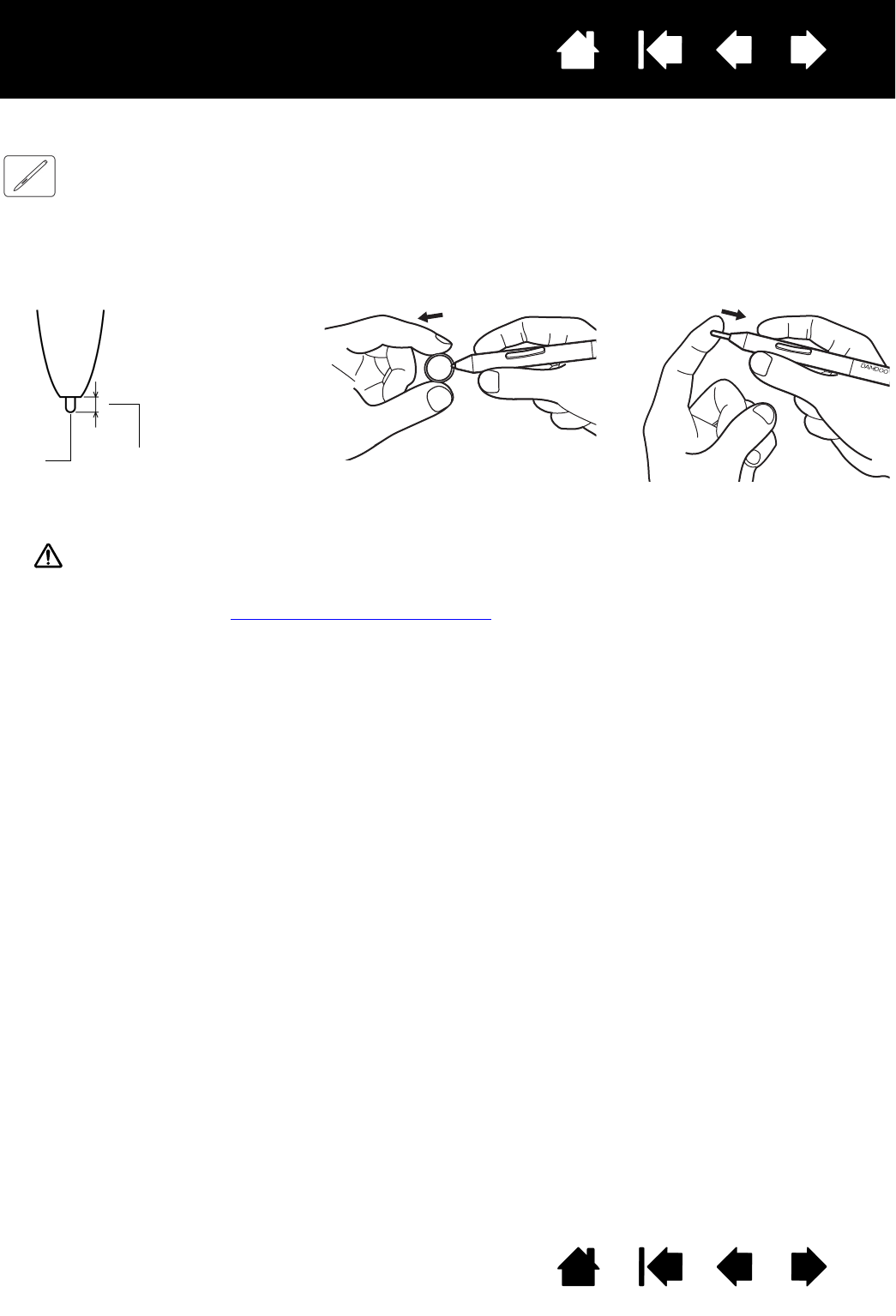
Contents Index
Contents 45
Index
45
REPLACING THE PEN NIB
The pen nib (tip) will wear with normal use. Excessive pressure will cause it to wear sooner. Replace the nib
when it gets too short or develops a flat point.
1. Clasp the old nib and pull it straight out of the pen. Use the nib removal tool, pair of tweezers, needle-
nosed pliers, or similar instrument.
2. Slide the end of the new nib straight into the barrel of the pen. Firmly push the nib until it stops.
Warning: Choking hazard. Prevent children from swallowing the pen nib or button part. The
pen nib or button part may accidentally be pulled out if children are biting on them.
For replacement parts, see ordering parts and accessories.
Important: When not in use, place the pen in the pen holder or lay it flat on your desk. When equipped, the
eraser end of the pen should be inserted first into the loop. To maintain the sensitivity of your pen, do not
store the pen in a container where it will rest on the tip or eraser.
Nib Replace when 1 mm
(0.4 inch) or less.
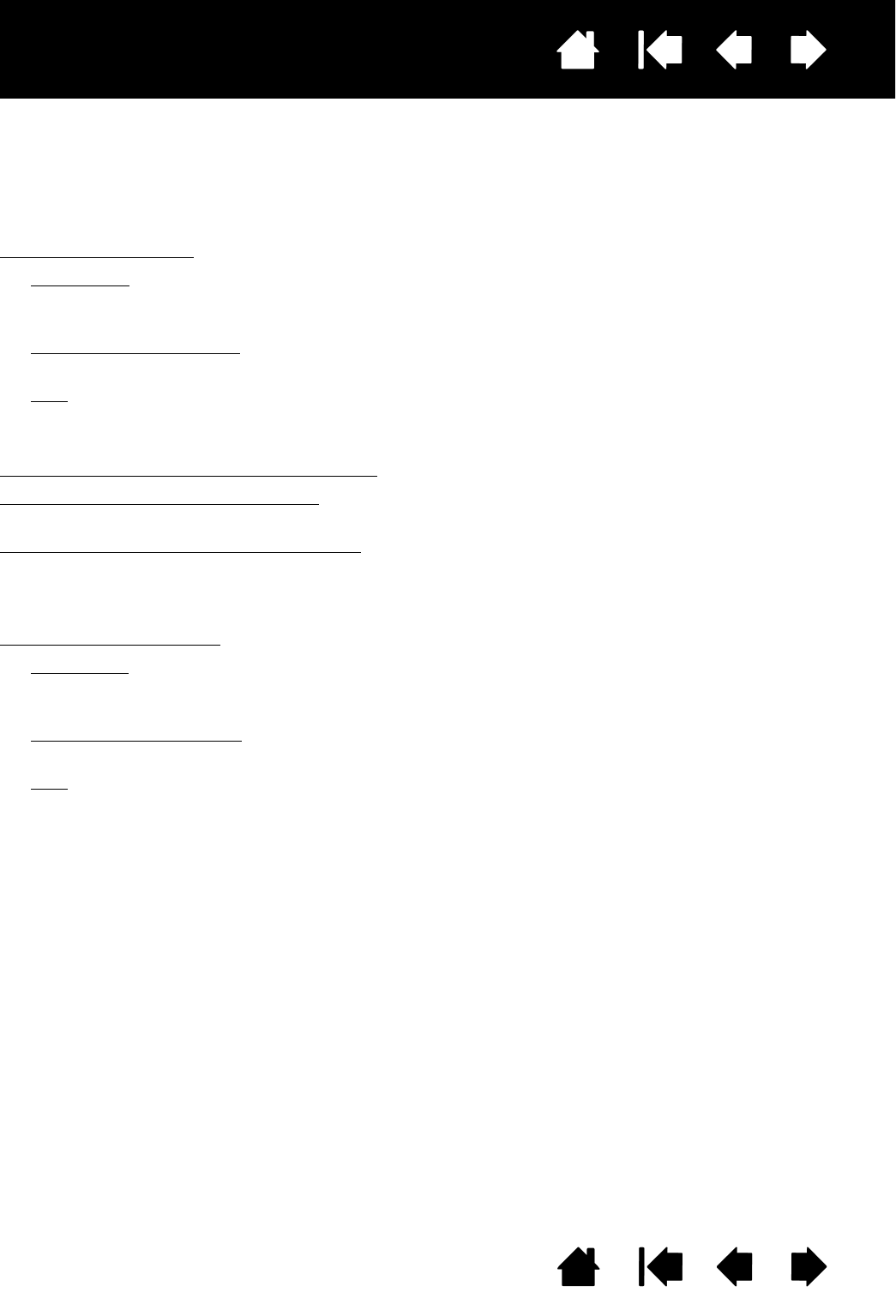
Contents Index
Contents 46
Index
46
BAMBOO DOCK
Use the Bamboo Dock to work with your Wacom tablet settings, and to view and add applications (apps)
made for the Wacom tablet. To learn more, visit http://bamboodock.wacom.com/ and choose your
language.
To open Bamboo Dock:
•Windows 8:
From the Windows 8 Start screen, click the BAMBOO DOCK tile. If you are using the
Windows 8 Classic Desktop, press the Windows key on your keyboard, or select the Windows icon in
the Charms bar, to access the Start screen.
• Windows 7, Vista and XP: Click START and choose (ALL) PROGRAMS. Then select BAMBOO DOCK from the
BAMBOO DOCK folder.
•Mac
: From the Finder GO menu or PLACES sidebar, choose APPLICATIONS, open the BAMBOO DOCK folder,
and double-click the BAMBOO DOCK icon.
Draw to open or hide Bamboo Dock options.
Work with your Wacom tablet settings. Click the Wacom tablet settings (gear) icon. Here you can adjust
your Wacom tablet settings and more.
Learn about and install Wacom tablet apps. Click the Wacom tablet collection (+) icon. From games and
sketching to composing music or sharing and connecting with friends, there is an ever-growing collection
of Wacom tablet apps to choose from.
To uninstall Bamboo Dock:
•Windows 8:
From the Windows 8 Start screen, click the BAMBOO DOCK tile. Click Uninstall from the task
bar. If you are using the Windows 8 Classic Desktop, press the Windows key on your keyboard, or
select the Windows icon in the Charms bar, to access the Start screen.
• Windows 7, Vista and XP: Click START and choose (ALL) PROGRAMS. Then select BAMBOO DOCK and
UNINSTALL. Follow the prompts.
•Mac
: In the APPLICATIONS folder, locate and trash the BAMBOO DOCK folder.
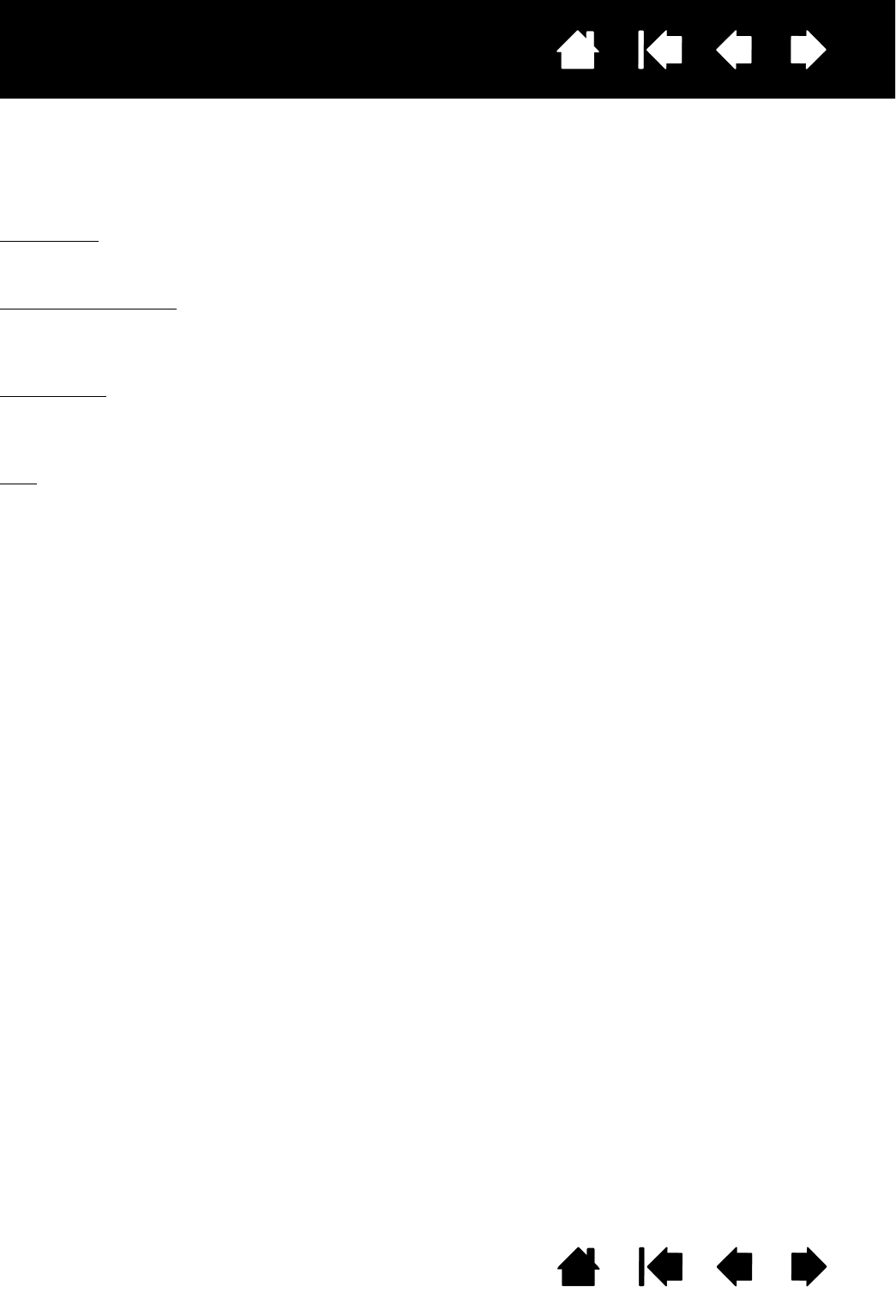
Contents Index
Contents 47
Index
47
UNINSTALLING YOUR WACOM TABLET
Follow the appropriate procedure below to remove the tablet driver software from your system.
Important: When you remove the tablet software, your tablet will no longer operate with full tablet
functionality but will continue to function as a mouse device.
Windows 8: From the Windows 8 Start screen, click the WACOM PREFERENCES tile, and click Uninstall from
the task bar. If you are using the Windows 8 Classic Desktop, press the Windows key on your keyboard, or
select the Windows icon in the Charms bar, to access the Start screen.
Windows 7 and Vista: Click on the Windows START button and open the CONTROL PANEL. In the CONTROL
PANEL window click on UNINSTALL A PROGRAM. In the dialog box that appears, choose WACOM TABLET and
click UNINSTALL. Follow the prompts to remove the tablet driver. If prompted, enter your administrator log
on name and password. Restart your computer after uninstalling the software.
Windows XP: Click on the Windows START button and open the CONTROL PANEL. In the CONTROL PANEL
window select ADD OR REMOVE PROGRAMS. In the ADD OR REMOVE PROGRAMS window, choose WACOM
TABLET and click REMOVE. Follow the prompts to remove the tablet driver. Restart your computer after
uninstalling the software.
Mac: From the GO menu, choose APPLICATIONS and open the WACOM TABLET folder. Double-click on the
WACOM UTILITY icon and select the TABLET SOFTWARE: REMOVE button. Enter your administrator login name
and password. After the removal is completed, click OK. Restart your computer after uninstalling the
software.

Contents Index
Contents 48
Index
48
MANAGING PREFERENCES
Use the preference file utility to manage your tablet preferences for single or multiple users.
Close any open applications.
Windows 8: From the Windows 8 Start screen, click the WACOM PREFERENCE FILE UTILITY tile. If you are
using the Windows 8 Classic Desktop, press the Windows key on your keyboard, or select the Windows
icon in the Charms bar, to access the Start screen.
Windows 7: Open the utility by clicking the START icon and selecting ALL PROGRAMS. In the Start menu
select WACOM and WACOM PREFERENCE FILE UTILITY.
• To remove preferences for the current user, click REMOVE under MY PREFERENCES.
• To delete preferences for multiple users, click REMOVE under ALL USER PREFERENCES. Administrator
rights are required to delete preferences for all users. Relaunch any currently open tablet-aware
applications that you may be running.
• To back up your preferences, click BACKUP... under MY PREFERENCES.
• To restore preferences that you had previously backed up, click RESTORE... under MY PREFERENCES.
• Carefully follow any prompts that may appear.
Mac: Open the main APPLICATIONS folder. Then open the WACOM folder and run the WACOM UTILITY.
• To remove preferences, select CURRENT USER or ALL USERS. Then click REMOVE. Log out, then log back
in. When the tablet driver loads it will create a new preferences file with the factory defaults.
• To back up your preferences, select CURRENT USER or ALL USERS. Then click BACKUP....
• To restore preferences that you had previously backed up, select CURRENT USER or ALL USERS. Then
click RESTORE....
• Carefully follow any prompts that may appear.
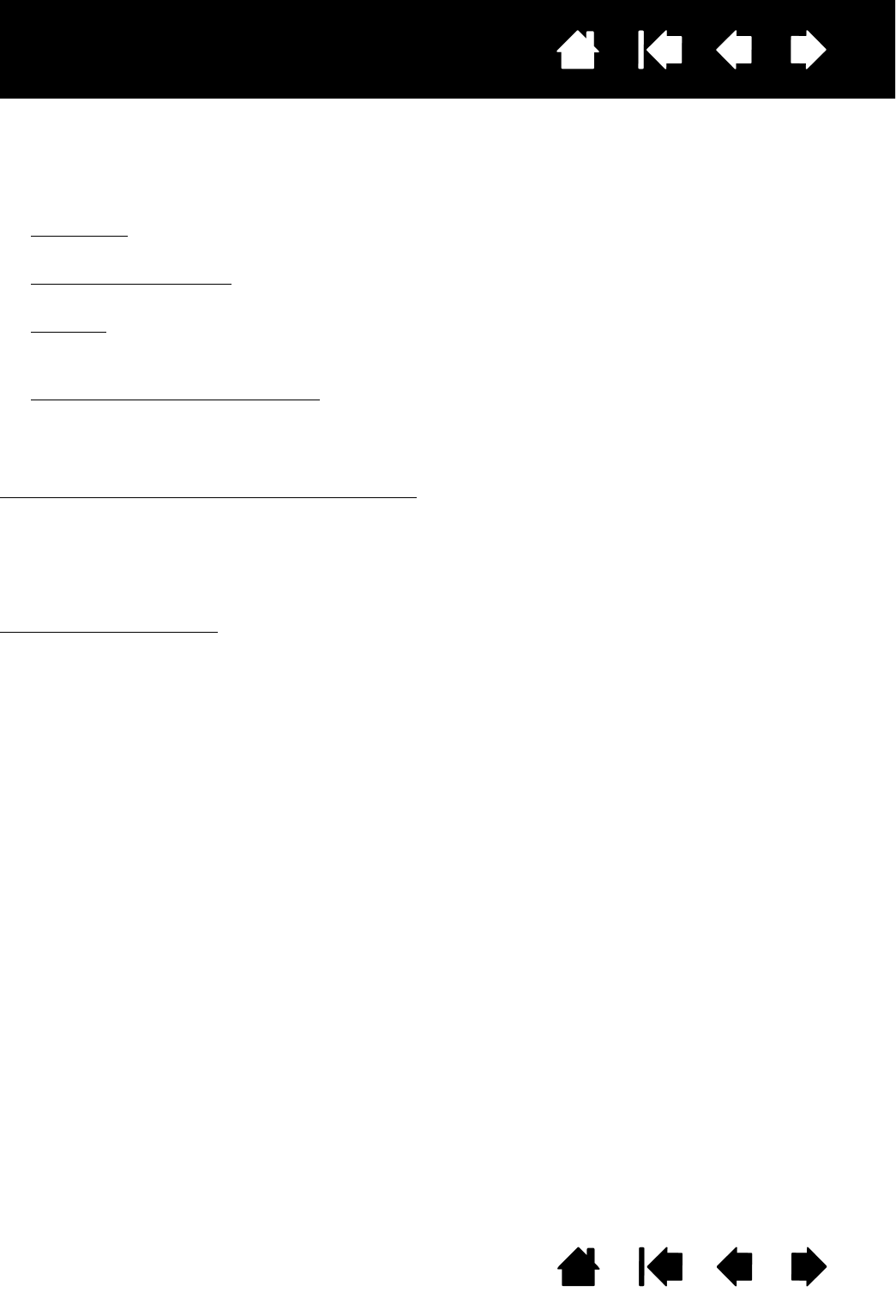
Contents Index
Contents 49
Index
49
PEN AND DIGITAL INK CAPABILITIES IN WINDOWS
Microsoft Windows 8, Windows 7 and Vista provide extensive support for pen input. Pen features are
supported in all versions of Windows 7 and Vista except Windows 7 Starter and Home Basic, and Windows
Vista Home Basic. Use your Wacom tablet and Wacom pen for quick, intuitive results.
•Note taking
. Jot notes and capture quick sketches in Windows Journal. Use the Journal search engine
to locate your handwritten content.
• Handwriting recognition. Quickly enter handwritten information anywhere the computer accepts typed
input. Convert your handwritten content to typed text at any time.
•Gestures
. Make simple gestural movements on the tablet to trigger customizable actions. To customize
gestures, select the FLICKS tab in the Windows 7 PEN AND TOUCH or Windows Vista PEN AND INPUT
DEVICES control panel.
• Digital Ink in Microsoft Office 2007. Utilize the enhanced digital mark-up and inking tools found on the
REVIEW tab within applicable applications.
The Windows 8, Windows 7 or Vista Input Panel enables you to use handwriting or an on-screen keyboard
to directly enter text with your Wacom pen.
There are different ways to launch the Input Panel:
• Click on the Input Panel icon which appears when you move the screen cursor into a text entry area.
• Click on the Input Panel tab, located by default on the left edge of the display screen.
• Click on the Tablet PC Input Panel icon located on the Windows Taskbar. If the icon is not visible, right-
click on the Taskbar, select TOOLBARS, and TABLET PC INPUT PANEL.
To disable the Input Panel:
1. Open the Tablet PC Input Panel.
2. Select TOOLS and OPTIONS.
3. Choose the OPENING tab and uncheck the following boxes:
•F
OR TABLET PEN INPUT, SHOW THE ICON NEXT TO THE TEXT BOX
•SHOW THE INPUT PANEL TAB.
4. Click OK.
For details, study the documentation that came with your system, including the Windows training tools and
Tablet PC tutorial. To access the Tablet PC Pen Training, from the START menu choose ALL PROGRAMS,
TABLET PC, and TABLET PC PEN TRAINING. Search the Windows help system for training tools if they are not
available from the START menu.
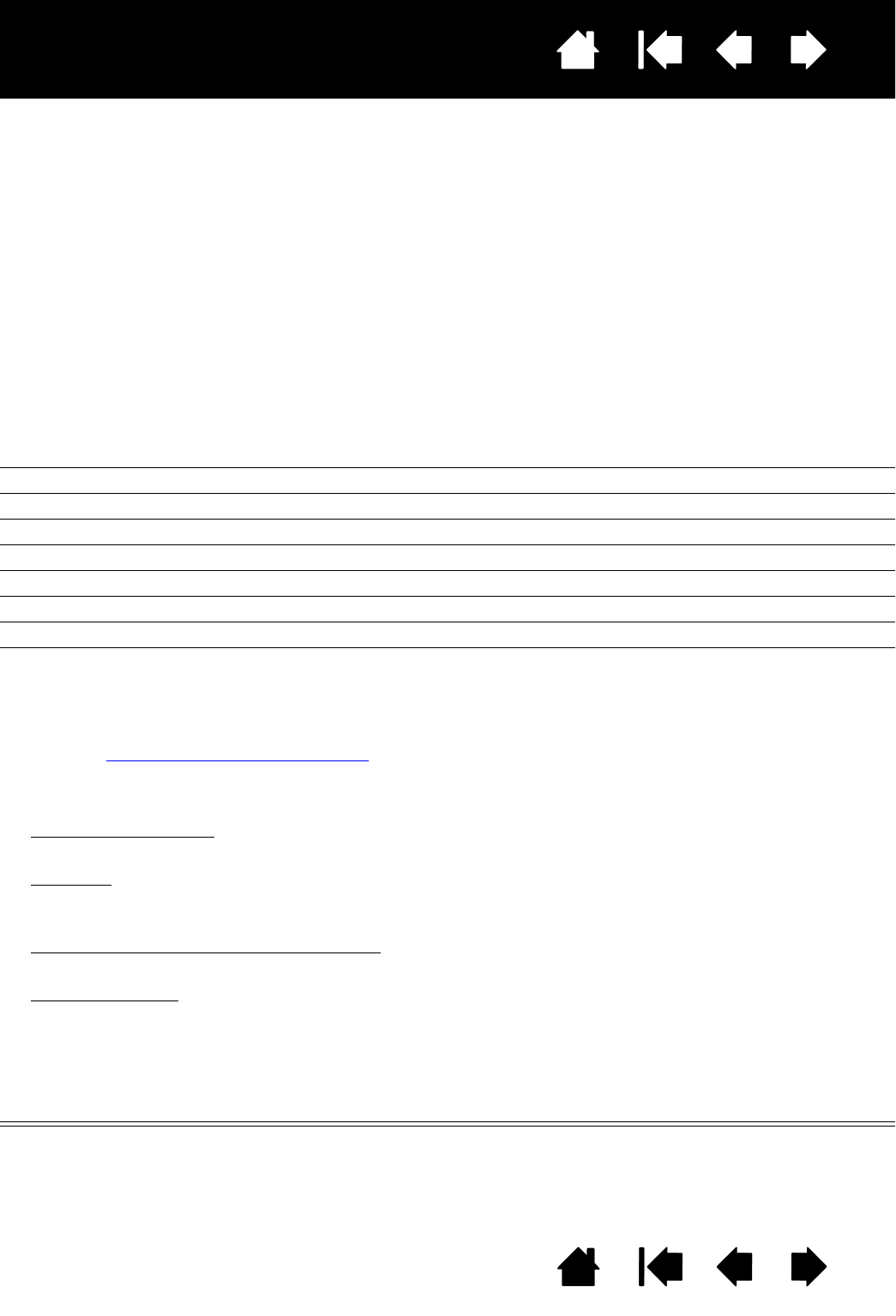
Contents Index
Contents 50
Index
50
Search the Microsoft web site for enhanced information about digital inking in Windows. You can also visit
the Wacom web site at www.wacom.com and search digital inking in Windows.
Note: The following workarounds in the Wacom software driver improve performance in Windows 8,
Windows 7 and Vista:
• The Pen Flicks and ‘press-and-hold-to-right-click’ features are disabled in graphics applications
using the Wintab API.
• There is no pressure sensitivity in Journal and other Ink features when both the Flicks and
‘press-and-hold-to-right-click’ features are disabled in the Windows 8, Windows 7 PEN AND
TOUCH, or Windows Vista PEN AND INPUT DEVICES control panel.
PRODUCT INFORMATION
To learn more about your tablet, visit the Wacom web site for your region. You can also discover which
software applications are currently tablet enhanced to support the pressure sensitivity and other special
functionality of your tablet by searching software applications.
ORDERING PARTS AND ACCESSORIES
To purchase available parts and accessories, refer to the Wacom tablet Read Me file and see who to call for
your region.
You can also do the following:
• In the USA or Canada, call 1.888.884.1870 (toll-free) or visit Wacom’s web site at
http://direct.wacom.com (USA only).
•In Europe
, call +49 (0)180.500.03.75 or send an email to spareparts@wacom.eu. Or, visit
http://shop.wacom.eu. You can also contact your local dealer, distributor, or technical support using the
appropriate number for your region.
• In Australia, Singapore, Taiwan and Korea, please visit: www.BuyWacom.com.au,
www.BuyWacom.com.sg, www.BuyWacom.com.tw and www.BuyWacom.co.kr, respectively.
• In other countries, please contact your local dealer or distributor.
Some parts and accessories may not be available in all regions.
AVAILABLE PARTS AND ACCESSORIES
USA, Canada, Central and South America http://www.wacom.com
Europe, Middle East and Africa http://www.wacom.eu
Japan http://tablet.wacom.co.jp
Asia Pacific (English) http://www.wacom.asia
China (Simplified Chinese) http://www.wacom.com.cn
Hong Kong (Traditional Chinese) http://www.wacom.com.hk
Korea http://www.wacom.asia/kr
Taiwan http://www.wacom.asia/tw
Thailand http://www.wacom.asia/th
DESCRIPTION PART NUMBER
Pen, standard, without eraser LP-170
Pen, premium, with eraser LP-170E
Pen nibs, black, qty 5 ACK-204-01K
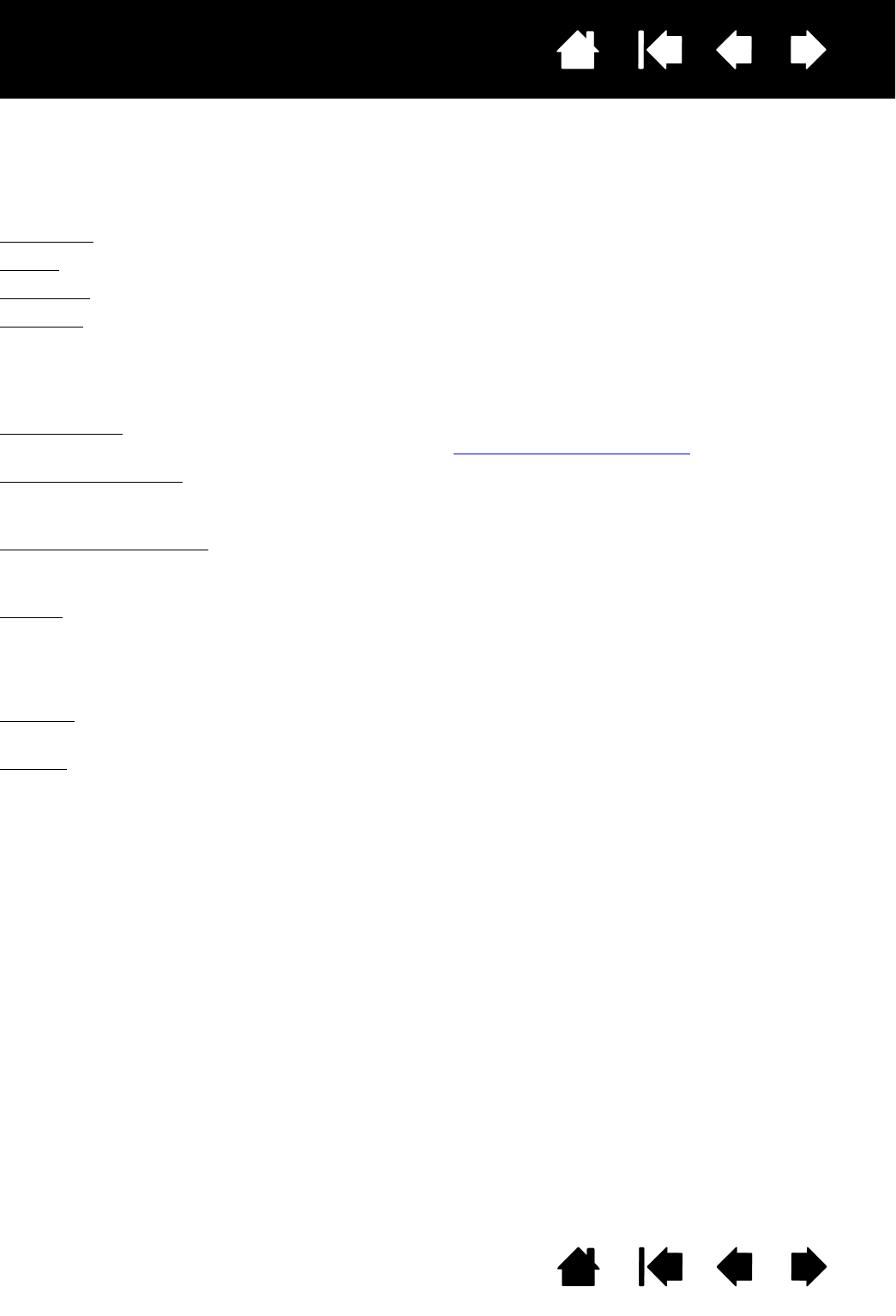
Contents Index
Contents 51
Index
51
GLOSSARY
Active area. The navigation and drawing area of your tablet where pen input is detected.
Aspect. The ratio between the vertical and horizontal dimension of the tablet or display.
Click force. The amount of force you must apply to the pen tip for a click to occur.
Digital Ink. A broad category that typically describes handwritten content which has been created using
pen-based input on a computer. This handwritten content takes the form of sketches, ink mark-up, or
handwriting. The handwriting can optionally be converted to typewritten text or simply left alone for use in
its original format. Depending on your system and application settings, the handwritten text you make with
digital ink can be converted on-the-fly or at another time.
Display Toggle. A feature that allows you to work with your tablet on all displays or on one display at a
time. Available only on multiple monitor systems. See Working with Display Toggle.
Double-click distance. The maximum distance (in screen pixels) that the screen cursor can move between
clicks and still be accepted as a double-click. Increasing the double-click distance makes double-clicking
easier, but may cause a delay in brush strokes in some applications.
Eraser-aware application. A software application that has built-in support for the pen eraser. These
applications take advantage of the eraser in different ways, depending on what makes sense for the
application.
Journal. A Microsoft Windows application that electronically simulates a physical journal pad, but with the
advantages of digital note taking. For example, you can create quick sketches and jot handwritten notes
that can be converted to text and sent on to colleagues for digital mark-up. Journal includes a variety of
pen, marker, and highlighter tools, plus an eraser that is easily activated by the eraser of the Wacom pen.
Additionally, your handwritten content is searchable within Journal.
Mapping. The relationship between the pen position on your tablet and the cursor position on the monitor
screen.
Modifier. Modifier keys include SHIFT, ALT, and CTRL for Windows, or SHIFT, CONTROL, COMMAND, and OPTION
for Mac.
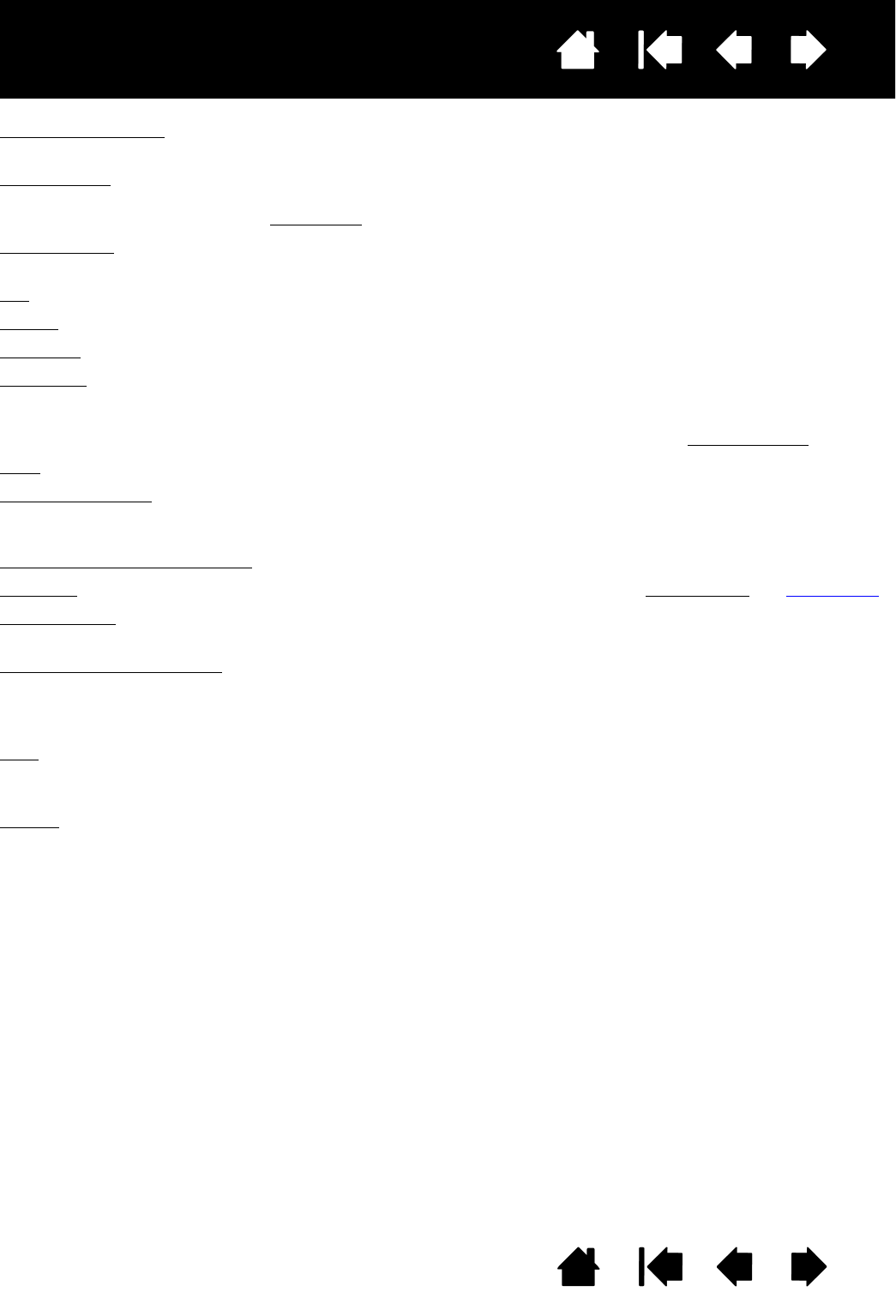
Contents Index
Contents 52
Index
52
Mouse acceleration. A setting that allows you to adjust the screen cursor acceleration when using mouse
mode.
Mouse mode. A method for positioning the screen cursor. When you place the pen on your tablet, you can
move the screen cursor with a “pick up and slide” motion similar to using a standard mouse. This is known
as relative positioning. See also Pen mode.
Mouse speed. A setting that allows you to adjust the speed at which your screen cursor moves when using
mouse mode.
Nib. The replaceable pen tip.
Pairing. A method of creating a virtual cable link between to devices.
Pen input. A method of controlling a computer using the pen on your tablet.
Pen mode. A pen input method of positioning the screen cursor. Wherever you place the pen on your
tablet, the screen cursor will jump to the corresponding point on the screen. This is known as absolute
positioning, and is the default setting for the pen. Pen mode allows you to quickly position the screen
cursor without having to first find it and then move it across the desktop. See also Mouse mode.
Pixel. The smallest unit of measure on your monitor screen.
Pressure sensitive. A quality of the Wacom pen tip and eraser that senses the amount of pressure being
applied. This is used to create natural-looking pen, brush, and eraser strokes in applications that are
pressure sensitive.
Pressure-sensitive application. Any application that supports pressure-sensitive input.
Proximity. The height above the tablet where pen detection occurs. See also Active area and positioning
Screen cursor. The pointer on the display screen. Screen cursors come in different shapes (such as an I-
beam, arrow, or box), depending on which application you are running.
Tablet PC Input Panel (TIP). The Microsoft Windows Tablet PC Input Panel enables you to use your Wacom
pen to create handwritten notes or work with an on-screen keyboard. The Input Panel dynamically converts
your handwriting to text. The information you create can then be inserted into other documents,
spreadsheets, or illustrations.
USB. Universal Serial Bus. A hardware interface standard for connecting computer peripheral devices.
USB ports support hot-plugging, which allows you to connect or disconnect a USB device without turning
off your computer.
Wintab. An interface standard used by Windows applications for receiving tablet information. Your Wacom
tablet supports all Wintab-compatible applications under Windows.
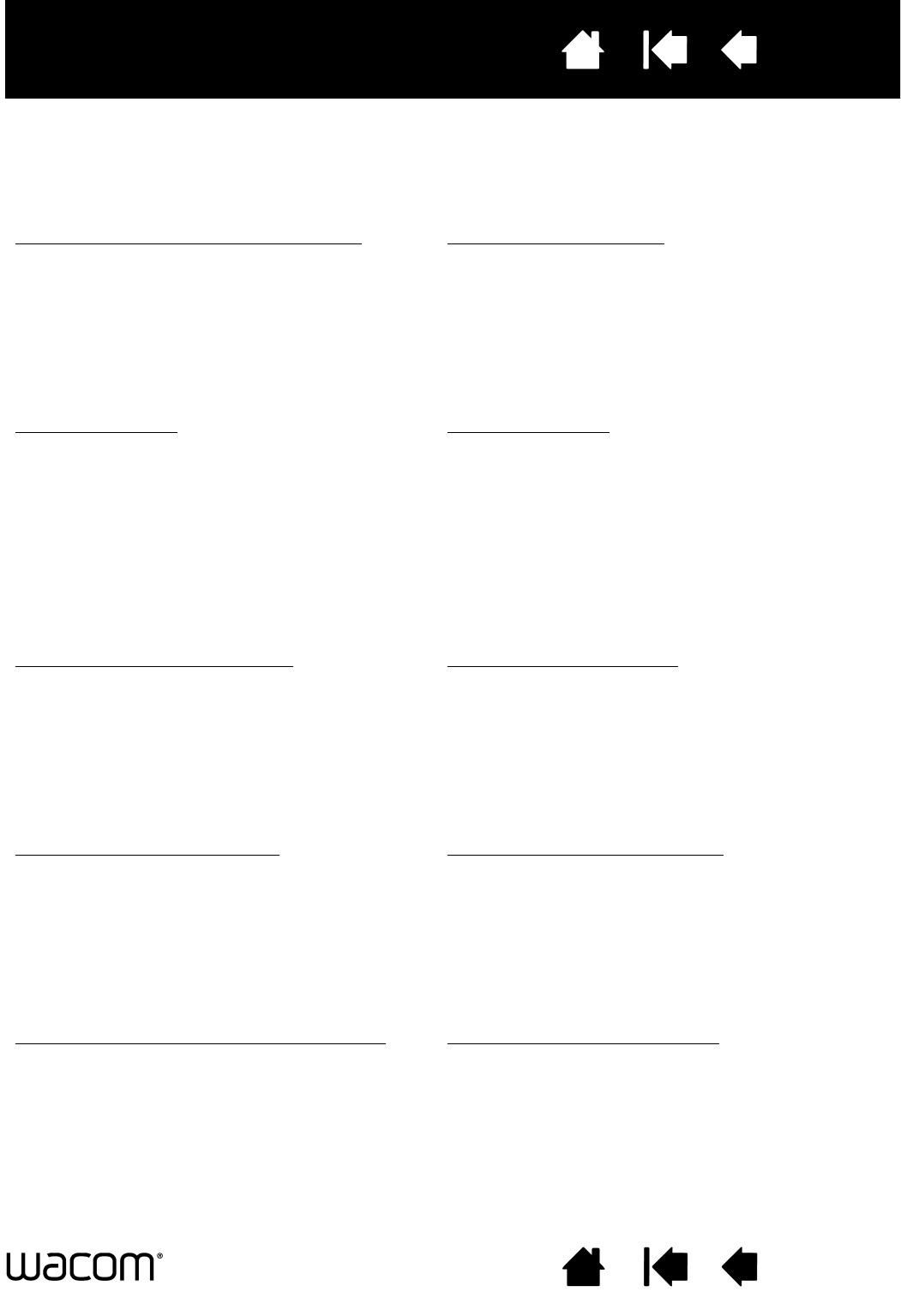
Contents Index
Contents 53
Index
53
WACOM INTERNATIONAL OFFICES
WACOM TECHNOLOGY CORPORATION WACOM EUROPE GMBH
1311 SE Cardinal Court Europark Fichtenhain A9
Vancouver, WA 98683 47807 Krefeld
U.S.A. Germany
Telephone: +1.360.896.9833 Internet: http://www.wacom.eu
Fax: +1.360.896.9724
WACOM CO., LTD.
JAPAN TABLET SALES DIVISION WACOM CO., LTD.
ASIA PACIFIC DIVISION
Sumitomo Fudosan Shinjuku Grand Tower 31F Sumitomo Fudosan Shinjuku Grand Tower 31F
8-17-1 Nishi-shinjuku, Shinjuku-ku 8-17-1 Nishi-shinjuku, Shinjuku-ku
Tokyo, 160-6131 Tokyo, 160-6131
Japan Japan
Internet: http://tablet.wacom.co.jp Telephone: +81.3.5309.1513
Fax: +81.3.5309.1514
WACOM CHINA CORPORATION WACOM KOREA CO., LTD.
1103, Beijing IFC West Tower #1211, 12F KGIT Sangam Center,
No. 8 Jianguomenwai Street 1601 Sangam-dong, Mapo-gu, Seoul 121-913, Korea
Chaoyang District, Beijing 100022 Telephone: +82.2.557.3894
China Fax: +82.2.557.3895
Internet: http://www.wacom.com.cn
WACOM AUSTRALIA PTY. LTD. WACOM SINGAPORE PTE. LTD.
Unit 8, Stage 1 Cumberland Green 5 Temasek Boulevard
2-8 South Street Rydalmere #12-09 Suntec Tower Five
NSW 2116 Australia Singapore 038985
Telephone: +61.2.9422.6700 Telephone: +65.6258.8640
Fax: +61.2.9420.2272 Fax: +65.6258.8697
WACOM TAIWAN INFORMATION CO., LTD. WACOM HONG KONG LIMITED
Suite 605, 6th floor, No. 205 Tun-Hwa North Road Room 1201, Tai Tung Building
Taipei, 105 Taiwan 8 Fleming Road
Telephone: +886.2.2712.2675 Wanchai, Hong Kong
Fax: +886.2.2712.9789 Telephone: +852.25739322
Fax: +852.25739500

Contents Index
Contents 54
Index
54
INDEX
About the manual 4
Accessories and parts, ordering 50
Accessories, available 50
Bamboo
caring for 44
customizing 21
pen input 12
product features 5
setting up 8
the pen experience 12
Bamboo Dock 46
Button functions 32
Care, for Bamboo 44
Click sound 16
Clicking, with pen 16
Control panel
basics 10
opening 21
overview 22
Customizing
Bamboo 21
button functions 32
double-click distance 24
eraser feel 24
ExpressKeys
functions 30
pen 23
acceleration in mouse mode 29
buttons 25
input 20
speed in mouse mode 29
tablet orientation 30
tip feel 24
Digital inking capabilities 49
Display Toggle, working with 31
Double-click distance, customizing 24
Double-clicking, how to 16
Dragging, with pen 16
Drawing with pressure 18
Driver downloads, obtaining 43
Environmental conditions 44
Eraser feel, customizing 24
Erasing, with pen 19
Ergonomics 8
ExpressKeys
setting functions 30
Eye-hand coordination exercise 20
Features
pen 7
pen holder 7
pen models 6
Functions, button 32
General problems, troubleshooting 37
Holding the pen 12
Information, product 50
Mac-specific problems, troubleshooting 40
Manual, about 4
Mapping
tablet 26
to multiple monitors 10
Monitors, working with multiple 10
Nib, replacing 45
Ordering parts and accessories 50
Orientation
configuring for tablet 9
setting for tablet 30
Overview, control panel 22
Parts and accessories, ordering 50
Parts, available 50

Contents Index
Contents 55
Index
55
Pen
buttons
customizing 25
using 17
clicking with 16
customizing 23
double-clicking with 16
dragging with 16
drawing with pressure 18
erasing with 19
features 7
holding 12
input problems, troubleshooting 37
input, customizing 20
nib, replacing 45
pointing with 14
positioning with 14
speed, setting 29
testing 36
the experience 12
tip, replacing 45
using 12
on tablet 13
pen buttons 17
writing with pressure 18
Pen holder 7
Pointing, with pen 14
Positioning, with pen 14
Preferences, managing 48
Pressure
drawing with 18
writing with 18
Product
features 5
information 50
Proportions and scale 27
Scale and proportions 27
Set up 8
Settings, control panel 22
Software
driver downloads 43
uninstalling 47
Tablet
configuring orientation 9
mapping 26
area 27
for portion of screen area 28
for portion of tablet area 28
to multiple monitors 10
orientation, setting 30
pen model features 6
scale and proportions 27
storing 44
testing 36
tracking 26
Technical support options 42
Testing
pen 36
tablet 36
Tip
customizing feel 24
replacing 45
Tracking, tablet 26
Troubleshooting
general problems 37
Mac-specific problems 40
pen input problems 37
tables 37
Windows-specific problems 40
Uninstalling tablet software 47
Windows-specific problems, troubleshooting 40
Work area, setting up 8
Writing with pressure 18
